
Researched by Consultants from Top-Tier Management Companies

Powerpoint Templates
Icon Bundle
Kpi Dashboard
Professional
Business Plans
Swot Analysis
Gantt Chart
Business Proposal
Marketing Plan
Project Management
Business Case
Business Model
Cyber Security
Business PPT
Digital Marketing
Digital Transformation
Human Resources
Product Management
Artificial Intelligence
Company Profile
Acknowledgement PPT
PPT Presentation
Reports Brochures
One Page Pitch
Interview PPT
All Categories

Software Case Study: Best Customers Acquisition Tool for Software Companies
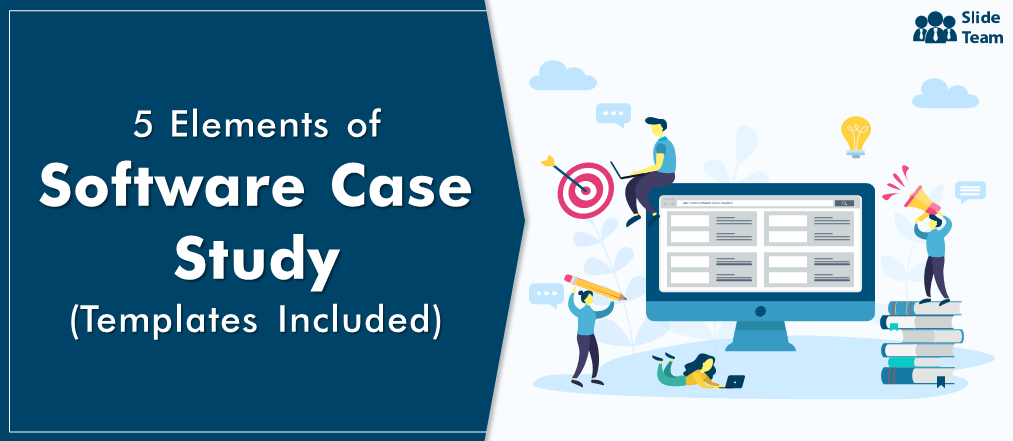
Naveen Kumar
Software companies have brought greater ease to our lives with their business vision. Yet, these enterprises usually miss out on the acquisition of customers due to competition and the dynamic nature of the market.
How do such companies stand out?
Software proposals are a proactive way of bagging projects, but acquiring website visitors is a different proposition. The key to cracking the code is Software case studies .
You can mention successful projects, achievements, and results on your website in the form of case studies. This will work as a gallery of your work for prospective customers.
Benefits of the Case Study Format
A Software case study will help you highlight achievements and showcase the market value of your organization. It will boost the confidence of your (prospective) clients and move them one step closer to a purchase decision. Case studies also function as testimony and add credibility to your organization and team. These are an excellent way to showcase the impact of your software (backed with qualitative and quantitative results).
Elements of a Software Case Study
You can divide a software case study into a headline, opening, main body, and conclusion — not to mention a Call-to-Action (CTA).
Headline: It must be a brief of the project and delivers important information in a persuasive manner. At this stage, details are not needed. You can include the partner’s or client's name, with their permission, and mention the sector of business.
Opening: You have to share the issue, its manifestation in the business process and how your organization helped the client. It can be done with a project summary (fact-sheets, key facts, project location, industry, services, expertise delivered, and technologies), product studios, and more.
Main body: Here, you describe the solution — which can be a product, process, service, or mixture of these. You have to describe how this solution was implemented and the results clients achieved.
Conclusion: Describe the results with facts (qualitative) and figures (quantitative) with client testimonials. You can also use client metrics to showcase your product’s positive impact.
CTA: An important part of content marketing strategy which you can apply in case studies. Through (and in) CTAs, you can ask visitors to read more, check company products, contact us, etc.
After drafting a fascinating software case study, it is also crucial to present it. You can add it to your website where visitors can check your work brief. Another way is to use it in sales pitches/proposals as a background check.
Our content-ready Software case study templates can assist you in creating and presenting your work in a professional manner. These high-quality PPT graphics can be a part of your website, giving it a purpose and a pull factor for customers.
Template 1: Enterprise Software Development Services Case Study Presentation
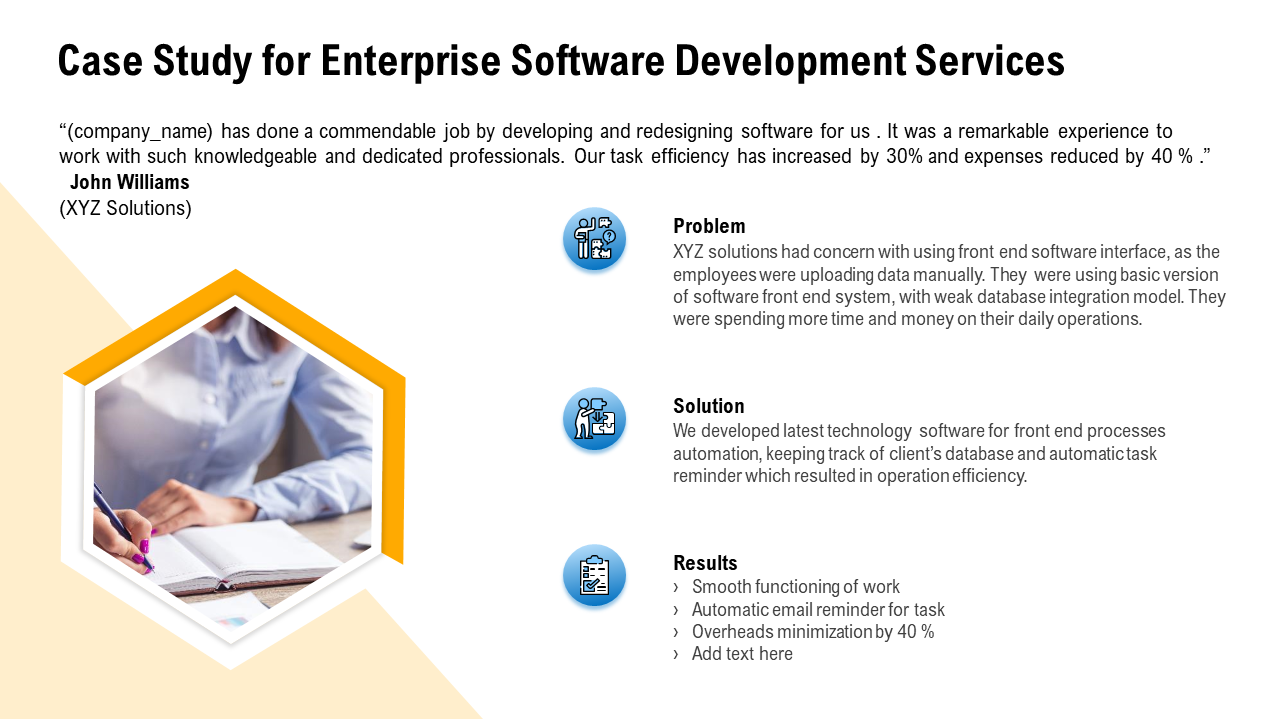
Use this PowerPoint template to create a case study for your software development project for enterprises. You can add a client testimonial with an image in the given space to this PPT slide. Describe the problem, solution, and results of the project using this design. Download it now!
Download this template
Template 2: Software Architecture Development Services Case Study PPT Template
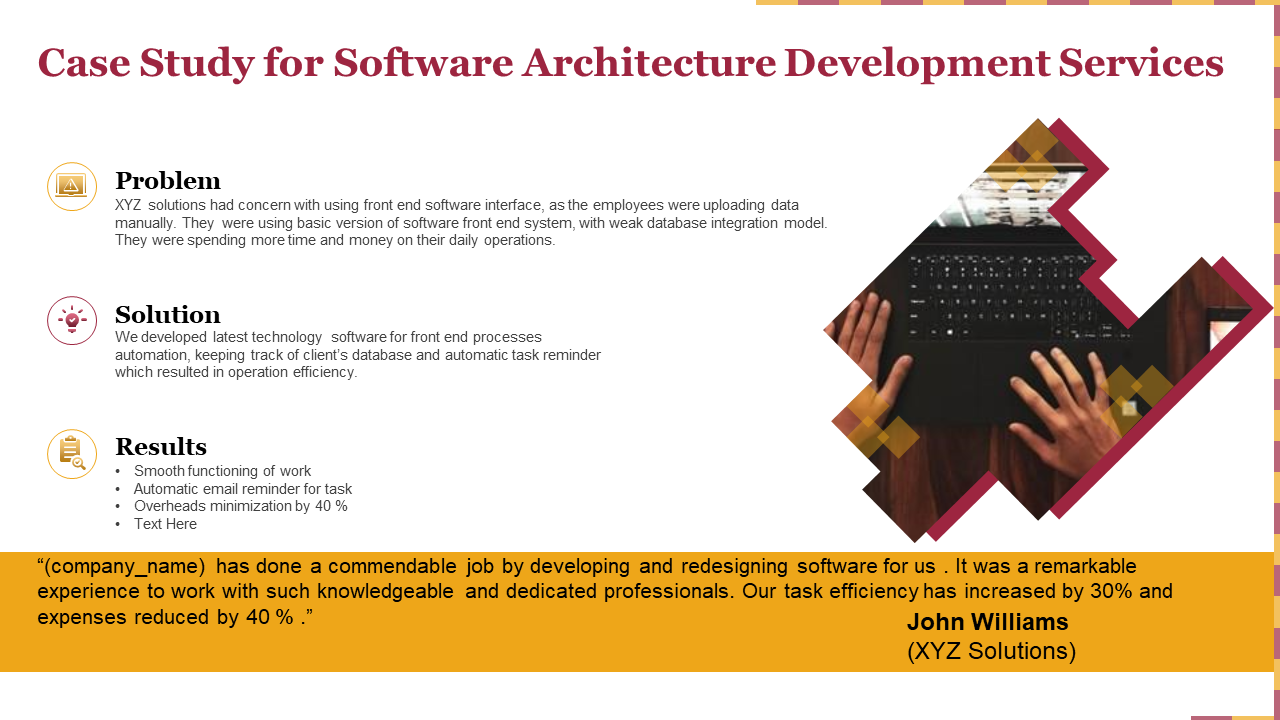
Software developers can use this PPT layout to present assignment details that their team handled. This vibrant design as a part of your next software proposal will impress more clients and bring new ones. Grab it now!
Template 3: Company Software Upgradation Proposal Case Study PowerPoint Template
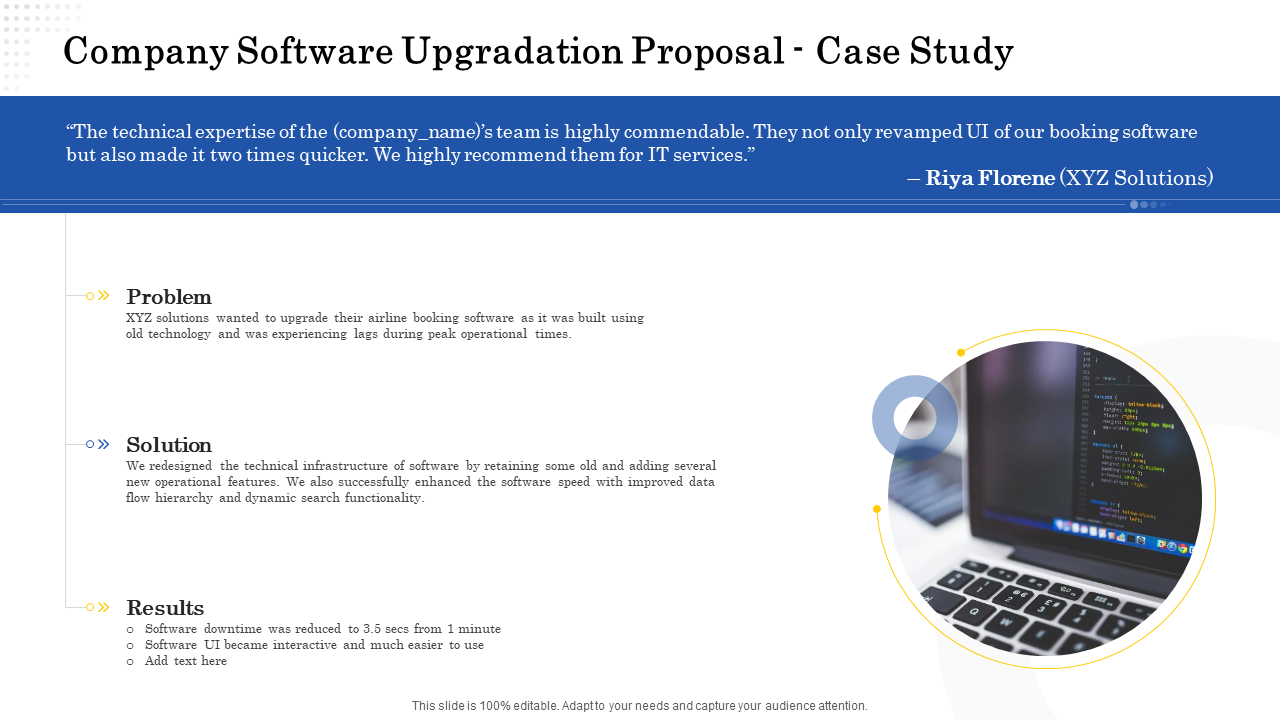
Employ this template to present your software up-gradation proposal, with case study as evidence. Positive feedback of existing or past clients can also be incorporated, with their permission. You can use this template to also add a brief about previous similar project(s). Download it now!
Template 4: Case Study for Software Maintenance Services Technology PPT Slide
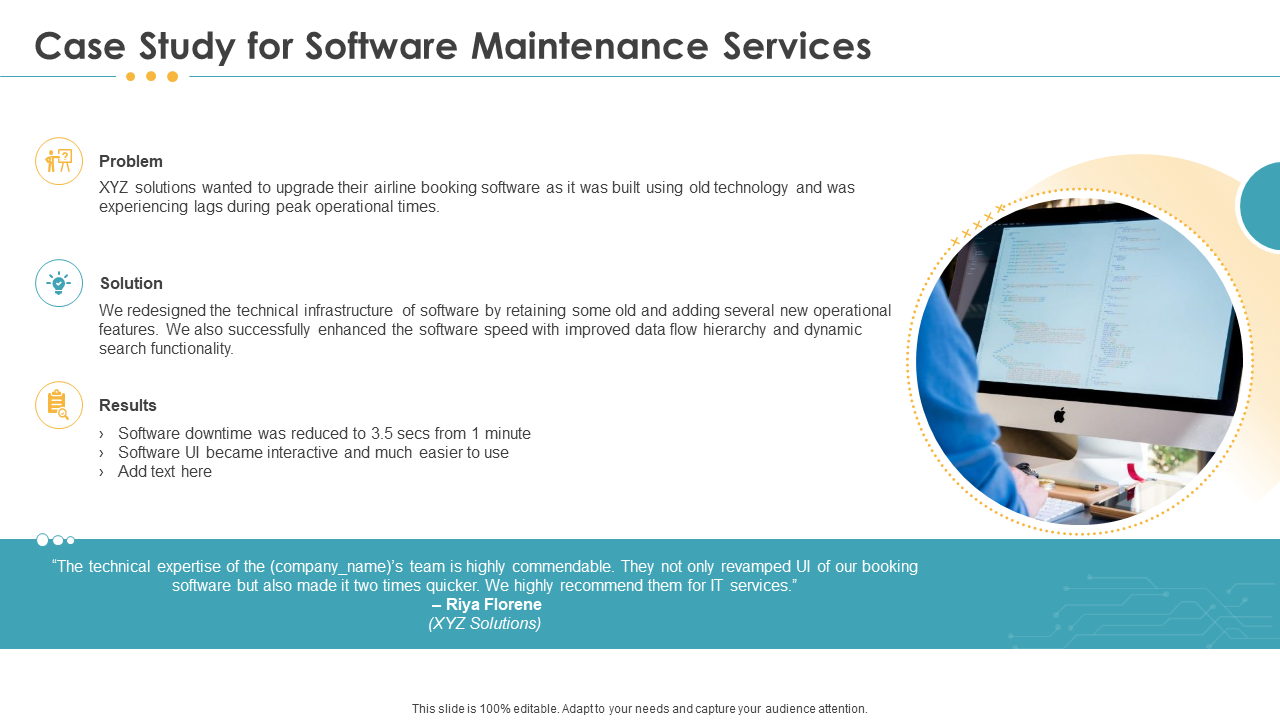
The maintenance of software is as important as developing it. Share your team’s expertise in software upkeep with prospective clients to win their trust, using this PPT graphic. You can use this to highlight the solution implemented for the stated problem. Get it now!
Template 5: Case Study for Software Technical Development Services Presentation
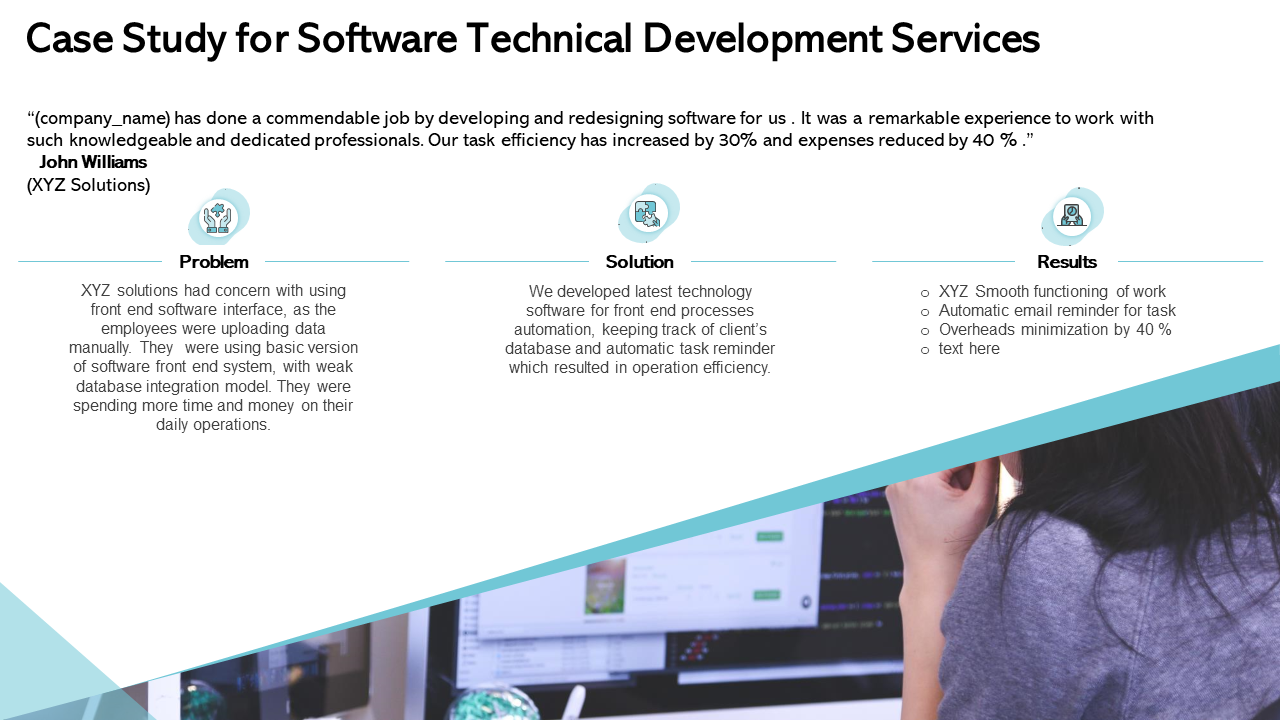
Use this PowerPoint layout to highlight the work of your technical software team in an elegant manner. This stunning PPT design helps you provide a brief project history to boost the chances of winning the project, and retaining the client. Download it now!
Template 6: Case Study for Software Development Design Services PPT Template
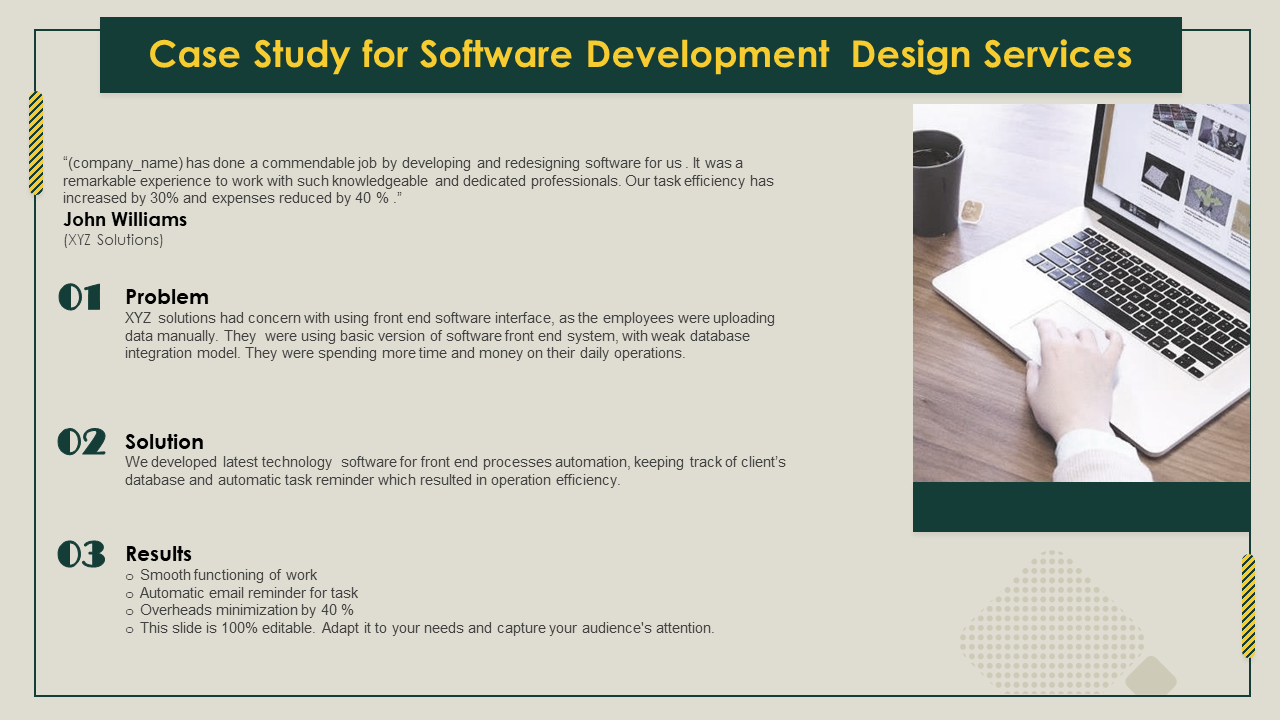
If you are looking for a design to develop a case study for a software development design service, this template is for you. You can use this PowerPoint slide to share the value your software provides to clients. Grab it now!
Template 7: New Software Development Services Case Study Presentation
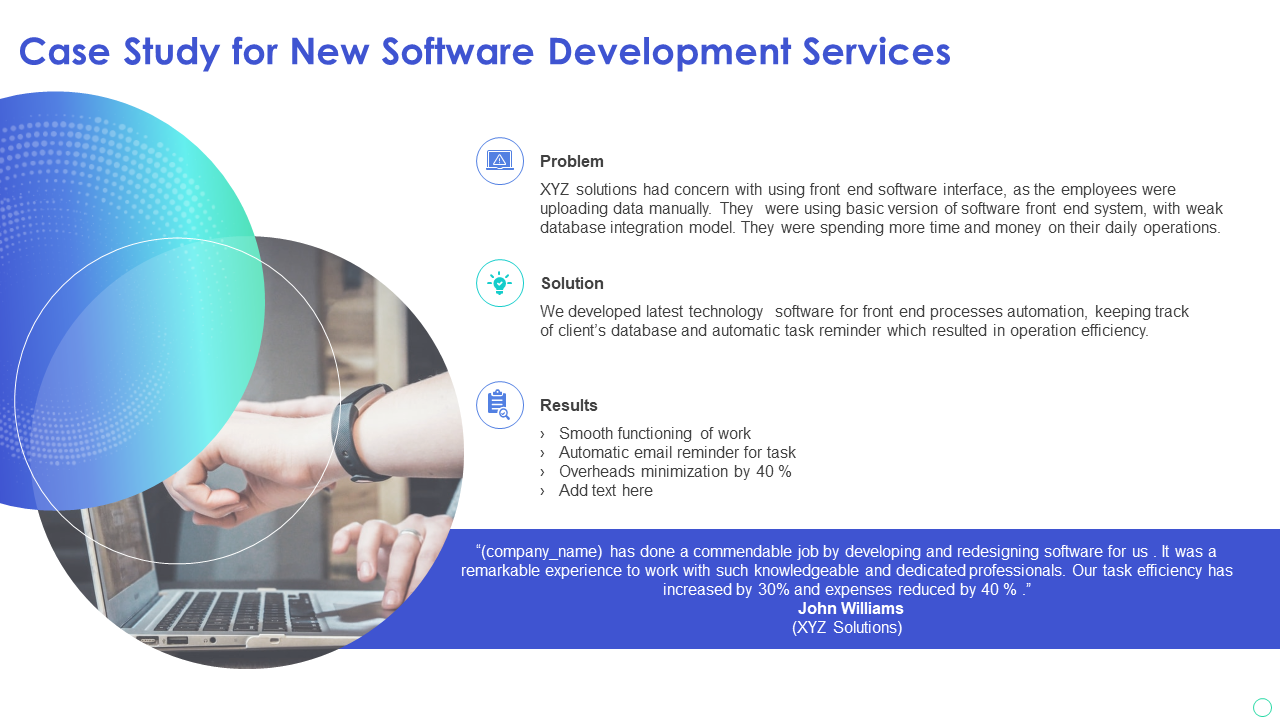
Utilize this template to highlight the benefits and features of your software. Share the quantitative and qualitative purpose that product serves. This PowerPoint graphic makes it easy to create a compelling case study for a deal. Download it now!
Template 8: HR Automation Software Proposal Case Study PowerPoint Slide
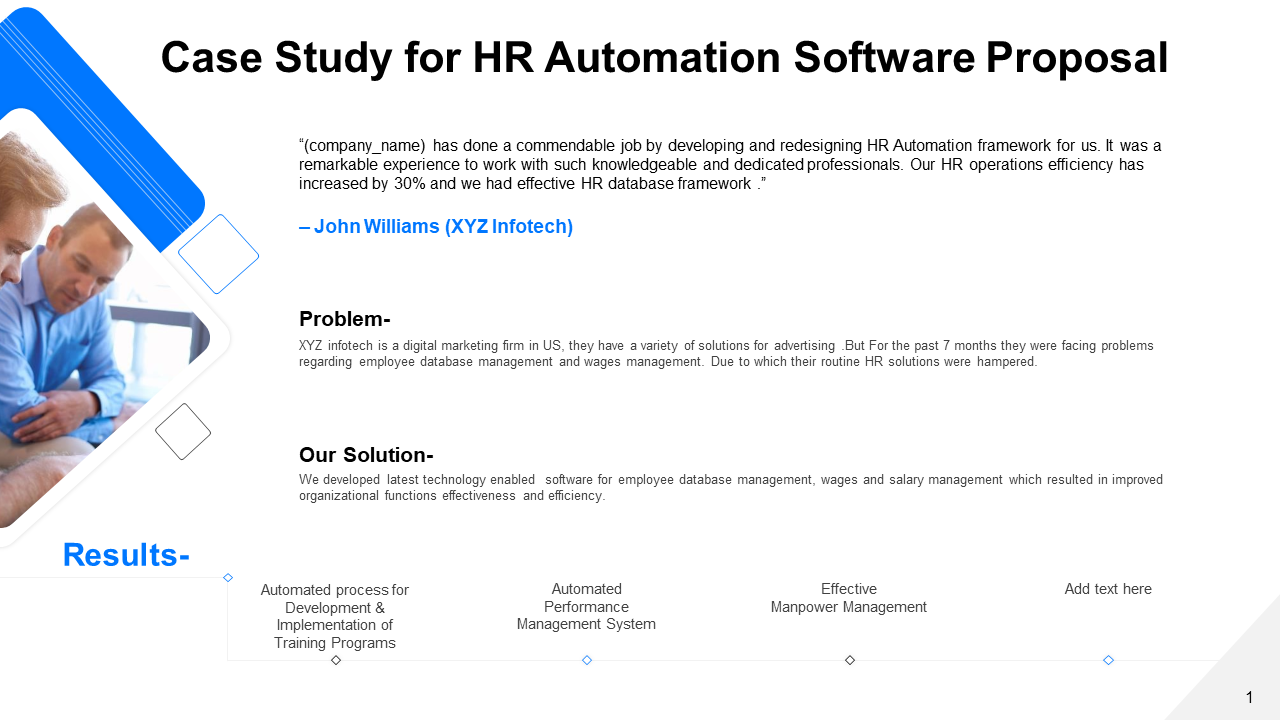
Convincing potential customers to invest in your HR automation software can be challenging. Using this case study template, you can show them how your software has helped other companies achieve their goals. Add positive feedback from customers, with their permission, to this editable PowerPoint layout to increase the value of your work and organization. Get it now!
Template 9: Case Study for System Software Modification Services PPT Template
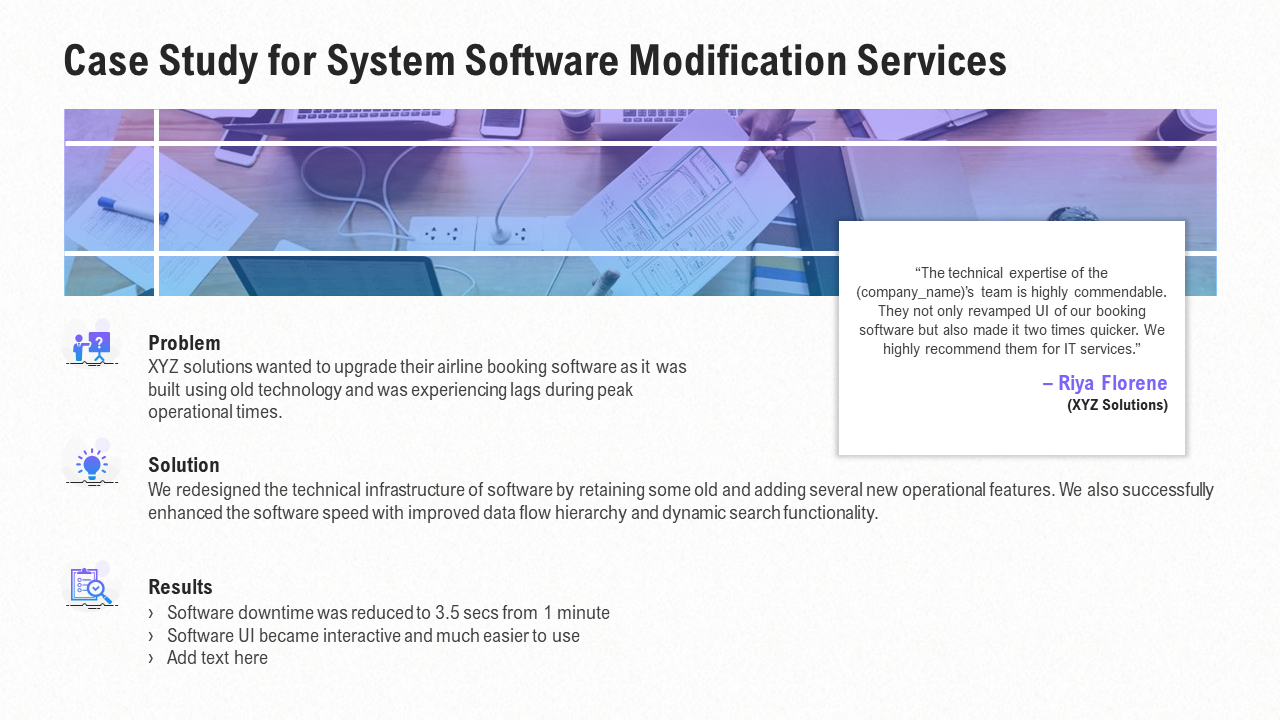
This PowerPoint set is a creative and unique way to tell your software success story to clients. It helps you present your case study in both visually-appealing and easy to understand manner. With this PPT graphic, you can show potential clients how you have helped other businesses succeed with your software modification services. Get hold of it now!
Template 10: Company Software Design Services Case Study PowerPoint Presentation
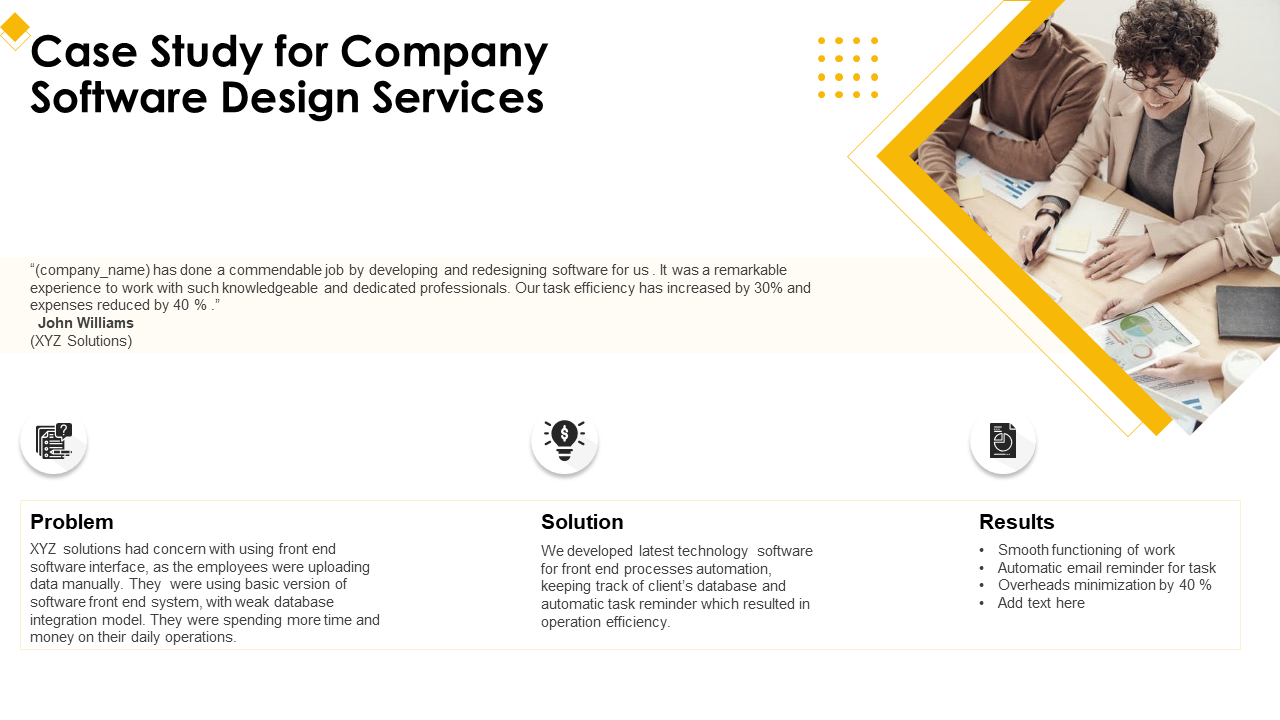
Showcase your team’s software designing skills with this case study PowerPoint template. You can win the trust of your customers and compel them to invest in your product with logic and the feasibility for your idea. Grab it now!
Case studies are persuasive documents and powerful tools for marketing your organization that can help you seal deals with potential clients. They also provide you an opportunity to showcase how your organization helps its customers succeed. Our templates make it easy for you to create impactful case studies. Don’t wait any longer – download these now and start putting this valuable marketing strategy to work.
P.S. Bring your team on the same page and help them complete a project with the help of software development status report templates included in this guide !
Related posts:
Top 10 software proposal templates for engineers and developers.
- Sales Coaching Plan Templates To Encourage Your Wolves of Wall Street [Free PDF Attached]
- Team Hierarchy Chart (With Best Templates): An Effortless Way To Introduce Your Team And Its Structure
- A Reality Check For Businesses: Cash Flow Statements (With Best Templates)
Liked this blog? Please recommend us

A User Guide to Craft an Irresistible Investor Deck for Your Software Company in 2021
![case study template for software projects [Updated 2023] Top 10 Templates to Build a Software Development Status Report](https://www.slideteam.net/wp/wp-content/uploads/2021/10/Banner_design_133b-1013x441.png)
[Updated 2023] Top 10 Templates to Build a Software Development Status Report
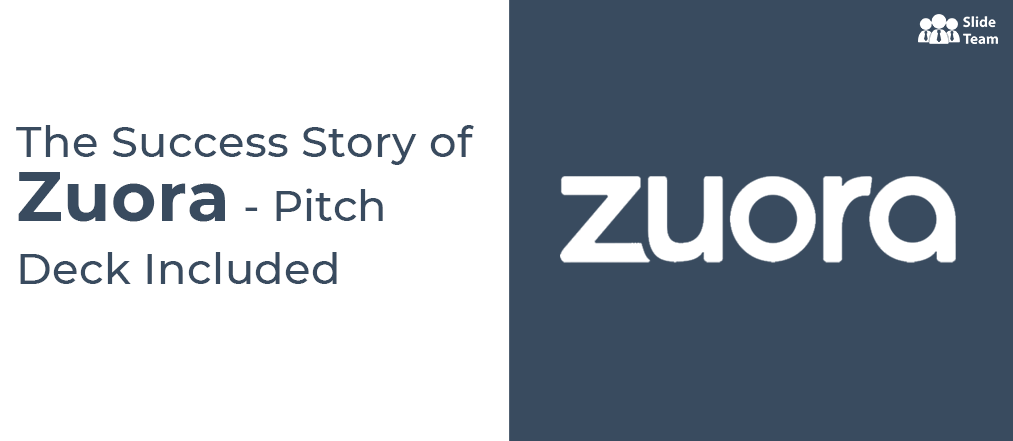
The Success Story of Zuora — World's Leading Enterprise Software Company (Pitch Deck Included)

Enterprise Software Pitch Deck to Infuse Life into Businesses

The Ultimate Software Development Guide With Template Included
This form is protected by reCAPTCHA - the Google Privacy Policy and Terms of Service apply.

Digital revolution powerpoint presentation slides

Sales funnel results presentation layouts
3d men joinning circular jigsaw puzzles ppt graphics icons

Business Strategic Planning Template For Organizations Powerpoint Presentation Slides

Future plan powerpoint template slide

Project Management Team Powerpoint Presentation Slides

Brand marketing powerpoint presentation slides

Launching a new service powerpoint presentation with slides go to market

Agenda powerpoint slide show

Four key metrics donut chart with percentage

Engineering and technology ppt inspiration example introduction continuous process improvement

Meet our team representing in circular format

How to Write a Case Study: Bookmarkable Guide & Template
Published: November 30, 2023
Earning the trust of prospective customers can be a struggle. Before you can even begin to expect to earn their business, you need to demonstrate your ability to deliver on what your product or service promises.

Sure, you could say that you're great at X or that you're way ahead of the competition when it comes to Y. But at the end of the day, what you really need to win new business is cold, hard proof.
One of the best ways to prove your worth is through a compelling case study. In fact, HubSpot’s 2020 State of Marketing report found that case studies are so compelling that they are the fifth most commonly used type of content used by marketers.

Below, I'll walk you through what a case study is, how to prepare for writing one, what you need to include in it, and how it can be an effective tactic. To jump to different areas of this post, click on the links below to automatically scroll.
Case Study Definition
Case study templates, how to write a case study.
- How to Format a Case Study
Business Case Study Examples
A case study is a specific challenge a business has faced, and the solution they've chosen to solve it. Case studies can vary greatly in length and focus on several details related to the initial challenge and applied solution, and can be presented in various forms like a video, white paper, blog post, etc.
In professional settings, it's common for a case study to tell the story of a successful business partnership between a vendor and a client. Perhaps the success you're highlighting is in the number of leads your client generated, customers closed, or revenue gained. Any one of these key performance indicators (KPIs) are examples of your company's services in action.
When done correctly, these examples of your work can chronicle the positive impact your business has on existing or previous customers and help you attract new clients.

Free Case Study Templates
Showcase your company's success using these three free case study templates.
- Data-Driven Case Study Template
- Product-Specific Case Study Template
- General Case Study Template
You're all set!
Click this link to access this resource at any time.
Why write a case study?
I know, you’re thinking “ Okay, but why do I need to write one of these? ” The truth is that while case studies are a huge undertaking, they are powerful marketing tools that allow you to demonstrate the value of your product to potential customers using real-world examples. Here are a few reasons why you should write case studies.
1. Explain Complex Topics or Concepts
Case studies give you the space to break down complex concepts, ideas, and strategies and show how they can be applied in a practical way. You can use real-world examples, like an existing client, and use their story to create a compelling narrative that shows how your product solved their issue and how those strategies can be repeated to help other customers get similar successful results.
2. Show Expertise
Case studies are a great way to demonstrate your knowledge and expertise on a given topic or industry. This is where you get the opportunity to show off your problem-solving skills and how you’ve generated successful outcomes for clients you’ve worked with.
3. Build Trust and Credibility
In addition to showing off the attributes above, case studies are an excellent way to build credibility. They’re often filled with data and thoroughly researched, which shows readers you’ve done your homework. They can have confidence in the solutions you’ve presented because they’ve read through as you’ve explained the problem and outlined step-by-step what it took to solve it. All of these elements working together enable you to build trust with potential customers.
4. Create Social Proof
Using existing clients that have seen success working with your brand builds social proof . People are more likely to choose your brand if they know that others have found success working with you. Case studies do just that — putting your success on display for potential customers to see.
All of these attributes work together to help you gain more clients. Plus you can even use quotes from customers featured in these studies and repurpose them in other marketing content. Now that you know more about the benefits of producing a case study, let’s check out how long these documents should be.
How long should a case study be?
The length of a case study will vary depending on the complexity of the project or topic discussed. However, as a general guideline, case studies typically range from 500 to 1,500 words.
Whatever length you choose, it should provide a clear understanding of the challenge, the solution you implemented, and the results achieved. This may be easier said than done, but it's important to strike a balance between providing enough detail to make the case study informative and concise enough to keep the reader's interest.
The primary goal here is to effectively communicate the key points and takeaways of the case study. It’s worth noting that this shouldn’t be a wall of text. Use headings, subheadings, bullet points, charts, and other graphics to break up the content and make it more scannable for readers. We’ve also seen brands incorporate video elements into case studies listed on their site for a more engaging experience.
Ultimately, the length of your case study should be determined by the amount of information necessary to convey the story and its impact without becoming too long. Next, let’s look at some templates to take the guesswork out of creating one.
To help you arm your prospects with information they can trust, we've put together a step-by-step guide on how to create effective case studies for your business with free case study templates for creating your own.
Tell us a little about yourself below to gain access today:
And to give you more options, we’ll highlight some useful templates that serve different needs. But remember, there are endless possibilities when it comes to demonstrating the work your business has done.
1. General Case Study Template

Do you have a specific product or service that you’re trying to sell, but not enough reviews or success stories? This Product Specific case study template will help.
This template relies less on metrics, and more on highlighting the customer’s experience and satisfaction. As you follow the template instructions, you’ll be prompted to speak more about the benefits of the specific product, rather than your team’s process for working with the customer.
4. Bold Social Media Business Case Study Template

You can find templates that represent different niches, industries, or strategies that your business has found success in — like a bold social media business case study template.
In this template, you can tell the story of how your social media marketing strategy has helped you or your client through collaboration or sale of your service. Customize it to reflect the different marketing channels used in your business and show off how well your business has been able to boost traffic, engagement, follows, and more.
5. Lead Generation Business Case Study Template

It’s important to note that not every case study has to be the product of a sale or customer story, sometimes they can be informative lessons that your own business has experienced. A great example of this is the Lead Generation Business case study template.
If you’re looking to share operational successes regarding how your team has improved processes or content, you should include the stories of different team members involved, how the solution was found, and how it has made a difference in the work your business does.
Now that we’ve discussed different templates and ideas for how to use them, let’s break down how to create your own case study with one.
- Get started with case study templates.
- Determine the case study's objective.
- Establish a case study medium.
- Find the right case study candidate.
- Contact your candidate for permission to write about them.
- Ensure you have all the resources you need to proceed once you get a response.
- Download a case study email template.
- Define the process you want to follow with the client.
- Ensure you're asking the right questions.
- Layout your case study format.
- Publish and promote your case study.
1. Get started with case study templates.
Telling your customer's story is a delicate process — you need to highlight their success while naturally incorporating your business into their story.
If you're just getting started with case studies, we recommend you download HubSpot's Case Study Templates we mentioned before to kickstart the process.
2. Determine the case study's objective.
All business case studies are designed to demonstrate the value of your services, but they can focus on several different client objectives.
Your first step when writing a case study is to determine the objective or goal of the subject you're featuring. In other words, what will the client have succeeded in doing by the end of the piece?
The client objective you focus on will depend on what you want to prove to your future customers as a result of publishing this case study.
Your case study can focus on one of the following client objectives:
- Complying with government regulation
- Lowering business costs
- Becoming profitable
- Generating more leads
- Closing on more customers
- Generating more revenue
- Expanding into a new market
- Becoming more sustainable or energy-efficient
3. Establish a case study medium.
Next, you'll determine the medium in which you'll create the case study. In other words, how will you tell this story?
Case studies don't have to be simple, written one-pagers. Using different media in your case study can allow you to promote your final piece on different channels. For example, while a written case study might just live on your website and get featured in a Facebook post, you can post an infographic case study on Pinterest and a video case study on your YouTube channel.
Here are some different case study mediums to consider:
Written Case Study
Consider writing this case study in the form of an ebook and converting it to a downloadable PDF. Then, gate the PDF behind a landing page and form for readers to fill out before downloading the piece, allowing this case study to generate leads for your business.
Video Case Study
Plan on meeting with the client and shooting an interview. Seeing the subject, in person, talk about the service you provided them can go a long way in the eyes of your potential customers.
Infographic Case Study
Use the long, vertical format of an infographic to tell your success story from top to bottom. As you progress down the infographic, emphasize major KPIs using bigger text and charts that show the successes your client has had since working with you.
Podcast Case Study
Podcasts are a platform for you to have a candid conversation with your client. This type of case study can sound more real and human to your audience — they'll know the partnership between you and your client was a genuine success.
4. Find the right case study candidate.
Writing about your previous projects requires more than picking a client and telling a story. You need permission, quotes, and a plan. To start, here are a few things to look for in potential candidates.
Product Knowledge
It helps to select a customer who's well-versed in the logistics of your product or service. That way, he or she can better speak to the value of what you offer in a way that makes sense for future customers.
Remarkable Results
Clients that have seen the best results are going to make the strongest case studies. If their own businesses have seen an exemplary ROI from your product or service, they're more likely to convey the enthusiasm that you want prospects to feel, too.
One part of this step is to choose clients who have experienced unexpected success from your product or service. When you've provided non-traditional customers — in industries that you don't usually work with, for example — with positive results, it can help to remove doubts from prospects.
Recognizable Names
While small companies can have powerful stories, bigger or more notable brands tend to lend credibility to your own. In fact, 89% of consumers say they'll buy from a brand they already recognize over a competitor, especially if they already follow them on social media.
Customers that came to you after working with a competitor help highlight your competitive advantage and might even sway decisions in your favor.
5. Contact your candidate for permission to write about them.
To get the case study candidate involved, you have to set the stage for clear and open communication. That means outlining expectations and a timeline right away — not having those is one of the biggest culprits in delayed case study creation.
Most importantly at this point, however, is getting your subject's approval. When first reaching out to your case study candidate, provide them with the case study's objective and format — both of which you will have come up with in the first two steps above.
To get this initial permission from your subject, put yourself in their shoes — what would they want out of this case study? Although you're writing this for your own company's benefit, your subject is far more interested in the benefit it has for them.
Benefits to Offer Your Case Study Candidate
Here are four potential benefits you can promise your case study candidate to gain their approval.
Brand Exposure
Explain to your subject to whom this case study will be exposed, and how this exposure can help increase their brand awareness both in and beyond their own industry. In the B2B sector, brand awareness can be hard to collect outside one's own market, making case studies particularly useful to a client looking to expand their name's reach.
Employee Exposure
Allow your subject to provide quotes with credits back to specific employees. When this is an option for them, their brand isn't the only thing expanding its reach — their employees can get their name out there, too. This presents your subject with networking and career development opportunities they might not have otherwise.
Product Discount
This is a more tangible incentive you can offer your case study candidate, especially if they're a current customer of yours. If they agree to be your subject, offer them a product discount — or a free trial of another product — as a thank-you for their help creating your case study.
Backlinks and Website Traffic
Here's a benefit that is sure to resonate with your subject's marketing team: If you publish your case study on your website, and your study links back to your subject's website — known as a "backlink" — this small gesture can give them website traffic from visitors who click through to your subject's website.
Additionally, a backlink from you increases your subject's page authority in the eyes of Google. This helps them rank more highly in search engine results and collect traffic from readers who are already looking for information about their industry.
6. Ensure you have all the resources you need to proceed once you get a response.
So you know what you’re going to offer your candidate, it’s time that you prepare the resources needed for if and when they agree to participate, like a case study release form and success story letter.
Let's break those two down.
Case Study Release Form
This document can vary, depending on factors like the size of your business, the nature of your work, and what you intend to do with the case studies once they are completed. That said, you should typically aim to include the following in the Case Study Release Form:
- A clear explanation of why you are creating this case study and how it will be used.
- A statement defining the information and potentially trademarked information you expect to include about the company — things like names, logos, job titles, and pictures.
- An explanation of what you expect from the participant, beyond the completion of the case study. For example, is this customer willing to act as a reference or share feedback, and do you have permission to pass contact information along for these purposes?
- A note about compensation.
Success Story Letter
As noted in the sample email, this document serves as an outline for the entire case study process. Other than a brief explanation of how the customer will benefit from case study participation, you'll want to be sure to define the following steps in the Success Story Letter.
7. Download a case study email template.
While you gathered your resources, your candidate has gotten time to read over the proposal. When your candidate approves of your case study, it's time to send them a release form.
A case study release form tells you what you'll need from your chosen subject, like permission to use any brand names and share the project information publicly. Kick-off this process with an email that runs through exactly what they can expect from you, as well as what you need from them. To give you an idea of what that might look like, check out this sample email:

8. Define the process you want to follow with the client.
Before you can begin the case study, you have to have a clear outline of the case study process with your client. An example of an effective outline would include the following information.
The Acceptance
First, you'll need to receive internal approval from the company's marketing team. Once approved, the Release Form should be signed and returned to you. It's also a good time to determine a timeline that meets the needs and capabilities of both teams.
The Questionnaire
To ensure that you have a productive interview — which is one of the best ways to collect information for the case study — you'll want to ask the participant to complete a questionnaire before this conversation. That will provide your team with the necessary foundation to organize the interview, and get the most out of it.
The Interview
Once the questionnaire is completed, someone on your team should reach out to the participant to schedule a 30- to 60-minute interview, which should include a series of custom questions related to the customer's experience with your product or service.
The Draft Review
After the case study is composed, you'll want to send a draft to the customer, allowing an opportunity to give you feedback and edits.
The Final Approval
Once any necessary edits are completed, send a revised copy of the case study to the customer for final approval.
Once the case study goes live — on your website or elsewhere — it's best to contact the customer with a link to the page where the case study lives. Don't be afraid to ask your participants to share these links with their own networks, as it not only demonstrates your ability to deliver positive results and impressive growth, as well.
9. Ensure you're asking the right questions.
Before you execute the questionnaire and actual interview, make sure you're setting yourself up for success. A strong case study results from being prepared to ask the right questions. What do those look like? Here are a few examples to get you started:
- What are your goals?
- What challenges were you experiencing before purchasing our product or service?
- What made our product or service stand out against our competitors?
- What did your decision-making process look like?
- How have you benefited from using our product or service? (Where applicable, always ask for data.)
Keep in mind that the questionnaire is designed to help you gain insights into what sort of strong, success-focused questions to ask during the actual interview. And once you get to that stage, we recommend that you follow the "Golden Rule of Interviewing." Sounds fancy, right? It's actually quite simple — ask open-ended questions.
If you're looking to craft a compelling story, "yes" or "no" answers won't provide the details you need. Focus on questions that invite elaboration, such as, "Can you describe ...?" or, "Tell me about ..."
In terms of the interview structure, we recommend categorizing the questions and flowing them into six specific sections that will mirror a successful case study format. Combined, they'll allow you to gather enough information to put together a rich, comprehensive study.
Open with the customer's business.
The goal of this section is to generate a better understanding of the company's current challenges and goals, and how they fit into the landscape of their industry. Sample questions might include:
- How long have you been in business?
- How many employees do you have?
- What are some of the objectives of your department at this time?
Cite a problem or pain point.
To tell a compelling story, you need context. That helps match the customer's need with your solution. Sample questions might include:
- What challenges and objectives led you to look for a solution?
- What might have happened if you did not identify a solution?
- Did you explore other solutions before this that did not work out? If so, what happened?
Discuss the decision process.
Exploring how the customer decided to work with you helps to guide potential customers through their own decision-making processes. Sample questions might include:
- How did you hear about our product or service?
- Who was involved in the selection process?
- What was most important to you when evaluating your options?
Explain how a solution was implemented.
The focus here should be placed on the customer's experience during the onboarding process. Sample questions might include:
- How long did it take to get up and running?
- Did that meet your expectations?
- Who was involved in the process?
Explain how the solution works.
The goal of this section is to better understand how the customer is using your product or service. Sample questions might include:
- Is there a particular aspect of the product or service that you rely on most?
- Who is using the product or service?
End with the results.
In this section, you want to uncover impressive measurable outcomes — the more numbers, the better. Sample questions might include:
- How is the product or service helping you save time and increase productivity?
- In what ways does that enhance your competitive advantage?
- How much have you increased metrics X, Y, and Z?
10. Lay out your case study format.
When it comes time to take all of the information you've collected and actually turn it into something, it's easy to feel overwhelmed. Where should you start? What should you include? What's the best way to structure it?
To help you get a handle on this step, it's important to first understand that there is no one-size-fits-all when it comes to the ways you can present a case study. They can be very visual, which you'll see in some of the examples we've included below, and can sometimes be communicated mostly through video or photos, with a bit of accompanying text.
Here are the sections we suggest, which we'll cover in more detail down below:
- Title: Keep it short. Develop a succinct but interesting project name you can give the work you did with your subject.
- Subtitle: Use this copy to briefly elaborate on the accomplishment. What was done? The case study itself will explain how you got there.
- Executive Summary : A 2-4 sentence summary of the entire story. You'll want to follow it with 2-3 bullet points that display metrics showcasing success.
- About the Subject: An introduction to the person or company you served, which can be pulled from a LinkedIn Business profile or client website.
- Challenges and Objectives: A 2-3 paragraph description of the customer's challenges, before using your product or service. This section should also include the goals or objectives the customer set out to achieve.
- How Product/Service Helped: A 2-3 paragraph section that describes how your product or service provided a solution to their problem.
- Results: A 2-3 paragraph testimonial that proves how your product or service specifically benefited the person or company and helped achieve its goals. Include numbers to quantify your contributions.
- Supporting Visuals or Quotes: Pick one or two powerful quotes that you would feature at the bottom of the sections above, as well as a visual that supports the story you are telling.
- Future Plans: Everyone likes an epilogue. Comment on what's ahead for your case study subject, whether or not those plans involve you.
- Call to Action (CTA): Not every case study needs a CTA, but putting a passive one at the end of your case study can encourage your readers to take an action on your website after learning about the work you've done.
When laying out your case study, focus on conveying the information you've gathered in the most clear and concise way possible. Make it easy to scan and comprehend, and be sure to provide an attractive call-to-action at the bottom — that should provide readers an opportunity to learn more about your product or service.
11. Publish and promote your case study.
Once you've completed your case study, it's time to publish and promote it. Some case study formats have pretty obvious promotional outlets — a video case study can go on YouTube, just as an infographic case study can go on Pinterest.
But there are still other ways to publish and promote your case study. Here are a couple of ideas:
Lead Gen in a Blog Post
As stated earlier in this article, written case studies make terrific lead-generators if you convert them into a downloadable format, like a PDF. To generate leads from your case study, consider writing a blog post that tells an abbreviated story of your client's success and asking readers to fill out a form with their name and email address if they'd like to read the rest in your PDF.
Then, promote this blog post on social media, through a Facebook post or a tweet.
Published as a Page on Your Website
As a growing business, you might need to display your case study out in the open to gain the trust of your target audience.
Rather than gating it behind a landing page, publish your case study to its own page on your website, and direct people here from your homepage with a "Case Studies" or "Testimonials" button along your homepage's top navigation bar.
Format for a Case Study
The traditional case study format includes the following parts: a title and subtitle, a client profile, a summary of the customer’s challenges and objectives, an account of how your solution helped, and a description of the results. You might also want to include supporting visuals and quotes, future plans, and calls-to-action.

Image Source
The title is one of the most important parts of your case study. It should draw readers in while succinctly describing the potential benefits of working with your company. To that end, your title should:
- State the name of your custome r. Right away, the reader must learn which company used your products and services. This is especially important if your customer has a recognizable brand. If you work with individuals and not companies, you may omit the name and go with professional titles: “A Marketer…”, “A CFO…”, and so forth.
- State which product your customer used . Even if you only offer one product or service, or if your company name is the same as your product name, you should still include the name of your solution. That way, readers who are not familiar with your business can become aware of what you sell.
- Allude to the results achieved . You don’t necessarily need to provide hard numbers, but the title needs to represent the benefits, quickly. That way, if a reader doesn’t stay to read, they can walk away with the most essential information: Your product works.
The example above, “Crunch Fitness Increases Leads and Signups With HubSpot,” achieves all three — without being wordy. Keeping your title short and sweet is also essential.
2. Subtitle

Your subtitle is another essential part of your case study — don’t skip it, even if you think you’ve done the work with the title. In this section, include a brief summary of the challenges your customer was facing before they began to use your products and services. Then, drive the point home by reiterating the benefits your customer experienced by working with you.
The above example reads:
“Crunch Fitness was franchising rapidly when COVID-19 forced fitness clubs around the world to close their doors. But the company stayed agile by using HubSpot to increase leads and free trial signups.”
We like that the case study team expressed the urgency of the problem — opening more locations in the midst of a pandemic — and placed the focus on the customer’s ability to stay agile.
3. Executive Summary

The executive summary should provide a snapshot of your customer, their challenges, and the benefits they enjoyed from working with you. Think it’s too much? Think again — the purpose of the case study is to emphasize, again and again, how well your product works.
The good news is that depending on your design, the executive summary can be mixed with the subtitle or with the “About the Company” section. Many times, this section doesn’t need an explicit “Executive Summary” subheading. You do need, however, to provide a convenient snapshot for readers to scan.
In the above example, ADP included information about its customer in a scannable bullet-point format, then provided two sections: “Business Challenge” and “How ADP Helped.” We love how simple and easy the format is to follow for those who are unfamiliar with ADP or its typical customer.
4. About the Company

Readers need to know and understand who your customer is. This is important for several reasons: It helps your reader potentially relate to your customer, it defines your ideal client profile (which is essential to deter poor-fit prospects who might have reached out without knowing they were a poor fit), and it gives your customer an indirect boon by subtly promoting their products and services.
Feel free to keep this section as simple as possible. You can simply copy and paste information from the company’s LinkedIn, use a quote directly from your customer, or take a more creative storytelling approach.
In the above example, HubSpot included one paragraph of description for Crunch Fitness and a few bullet points. Below, ADP tells the story of its customer using an engaging, personable technique that effectively draws readers in.

5. Challenges and Objectives

The challenges and objectives section of your case study is the place to lay out, in detail, the difficulties your customer faced prior to working with you — and what they hoped to achieve when they enlisted your help.
In this section, you can be as brief or as descriptive as you’d like, but remember: Stress the urgency of the situation. Don’t understate how much your customer needed your solution (but don’t exaggerate and lie, either). Provide contextual information as necessary. For instance, the pandemic and societal factors may have contributed to the urgency of the need.
Take the above example from design consultancy IDEO:
“Educational opportunities for adults have become difficult to access in the United States, just when they’re needed most. To counter this trend, IDEO helped the city of South Bend and the Drucker Institute launch Bendable, a community-powered platform that connects people with opportunities to learn with and from each other.”
We love how IDEO mentions the difficulties the United States faces at large, the efforts its customer is taking to address these issues, and the steps IDEO took to help.
6. How Product/Service Helped

This is where you get your product or service to shine. Cover the specific benefits that your customer enjoyed and the features they gleaned the most use out of. You can also go into detail about how you worked with and for your customer. Maybe you met several times before choosing the right solution, or you consulted with external agencies to create the best package for them.
Whatever the case may be, try to illustrate how easy and pain-free it is to work with the representatives at your company. After all, potential customers aren’t looking to just purchase a product. They’re looking for a dependable provider that will strive to exceed their expectations.
In the above example, IDEO describes how it partnered with research institutes and spoke with learners to create Bendable, a free educational platform. We love how it shows its proactivity and thoroughness. It makes potential customers feel that IDEO might do something similar for them.

The results are essential, and the best part is that you don’t need to write the entirety of the case study before sharing them. Like HubSpot, IDEO, and ADP, you can include the results right below the subtitle or executive summary. Use data and numbers to substantiate the success of your efforts, but if you don’t have numbers, you can provide quotes from your customers.
We can’t overstate the importance of the results. In fact, if you wanted to create a short case study, you could include your title, challenge, solution (how your product helped), and result.
8. Supporting Visuals or Quotes

Let your customer speak for themselves by including quotes from the representatives who directly interfaced with your company.
Visuals can also help, even if they’re stock images. On one side, they can help you convey your customer’s industry, and on the other, they can indirectly convey your successes. For instance, a picture of a happy professional — even if they’re not your customer — will communicate that your product can lead to a happy client.
In this example from IDEO, we see a man standing in a boat. IDEO’s customer is neither the man pictured nor the manufacturer of the boat, but rather Conservation International, an environmental organization. This imagery provides a visually pleasing pattern interrupt to the page, while still conveying what the case study is about.
9. Future Plans
This is optional, but including future plans can help you close on a more positive, personable note than if you were to simply include a quote or the results. In this space, you can show that your product will remain in your customer’s tech stack for years to come, or that your services will continue to be instrumental to your customer’s success.
Alternatively, if you work only on time-bound projects, you can allude to the positive impact your customer will continue to see, even after years of the end of the contract.
10. Call to Action (CTA)

Not every case study needs a CTA, but we’d still encourage it. Putting one at the end of your case study will encourage your readers to take an action on your website after learning about the work you've done.
It will also make it easier for them to reach out, if they’re ready to start immediately. You don’t want to lose business just because they have to scroll all the way back up to reach out to your team.
To help you visualize this case study outline, check out the case study template below, which can also be downloaded here .
You drove the results, made the connection, set the expectations, used the questionnaire to conduct a successful interview, and boiled down your findings into a compelling story. And after all of that, you're left with a little piece of sales enabling gold — a case study.
To show you what a well-executed final product looks like, have a look at some of these marketing case study examples.
1. "Shopify Uses HubSpot CRM to Transform High Volume Sales Organization," by HubSpot
What's interesting about this case study is the way it leads with the customer. This reflects a major HubSpot value, which is to always solve for the customer first. The copy leads with a brief description of why Shopify uses HubSpot and is accompanied by a short video and some basic statistics on the company.
Notice that this case study uses mixed media. Yes, there is a short video, but it's elaborated upon in the additional text on the page. So, while case studies can use one or the other, don't be afraid to combine written copy with visuals to emphasize the project's success.
2. "New England Journal of Medicine," by Corey McPherson Nash
When branding and design studio Corey McPherson Nash showcases its work, it makes sense for it to be visual — after all, that's what they do. So in building the case study for the studio's work on the New England Journal of Medicine's integrated advertising campaign — a project that included the goal of promoting the client's digital presence — Corey McPherson Nash showed its audience what it did, rather than purely telling it.
Notice that the case study does include some light written copy — which includes the major points we've suggested — but lets the visuals do the talking, allowing users to really absorb the studio's services.
3. "Designing the Future of Urban Farming," by IDEO
Here's a design company that knows how to lead with simplicity in its case studies. As soon as the visitor arrives at the page, he or she is greeted with a big, bold photo, and two very simple columns of text — "The Challenge" and "The Outcome."
Immediately, IDEO has communicated two of the case study's major pillars. And while that's great — the company created a solution for vertical farming startup INFARM's challenge — it doesn't stop there. As the user scrolls down, those pillars are elaborated upon with comprehensive (but not overwhelming) copy that outlines what that process looked like, replete with quotes and additional visuals.
4. "Secure Wi-Fi Wins Big for Tournament," by WatchGuard
Then, there are the cases when visuals can tell almost the entire story — when executed correctly. Network security provider WatchGuard can do that through this video, which tells the story of how its services enhanced the attendee and vendor experience at the Windmill Ultimate Frisbee tournament.
5. Rock and Roll Hall of Fame Boosts Social Media Engagement and Brand Awareness with HubSpot
In the case study above , HubSpot uses photos, videos, screenshots, and helpful stats to tell the story of how the Rock and Roll Hall of Fame used the bot, CRM, and social media tools to gain brand awareness.
6. Small Desk Plant Business Ups Sales by 30% With Trello
This case study from Trello is straightforward and easy to understand. It begins by explaining the background of the company that decided to use it, what its goals were, and how it planned to use Trello to help them.
It then goes on to discuss how the software was implemented and what tasks and teams benefited from it. Towards the end, it explains the sales results that came from implementing the software and includes quotes from decision-makers at the company that implemented it.
7. Facebook's Mercedes Benz Success Story
Facebook's Success Stories page hosts a number of well-designed and easy-to-understand case studies that visually and editorially get to the bottom line quickly.
Each study begins with key stats that draw the reader in. Then it's organized by highlighting a problem or goal in the introduction, the process the company took to reach its goals, and the results. Then, in the end, Facebook notes the tools used in the case study.
Showcasing Your Work
You work hard at what you do. Now, it's time to show it to the world — and, perhaps more important, to potential customers. Before you show off the projects that make you the proudest, we hope you follow these important steps that will help you effectively communicate that work and leave all parties feeling good about it.
Editor's Note: This blog post was originally published in February 2017 but was updated for comprehensiveness and freshness in July 2021.

Don't forget to share this post!
Related articles.

How to Market an Ebook: 21 Ways to Promote Your Content Offers
![case study template for software projects 7 Pieces of Content Your Audience Really Wants to See [New Data]](https://blog.hubspot.com/hubfs/most%20popular%20types%20of%20content.jpg)
7 Pieces of Content Your Audience Really Wants to See [New Data]
![case study template for software projects How to Write a Listicle [+ Examples and Ideas]](https://blog.hubspot.com/hubfs/listicle-1.jpg)
How to Write a Listicle [+ Examples and Ideas]

28 Case Study Examples Every Marketer Should See
![case study template for software projects What Is a White Paper? [FAQs]](https://blog.hubspot.com/hubfs/business%20whitepaper.jpg)
What Is a White Paper? [FAQs]

What is an Advertorial? 8 Examples to Help You Write One

How to Create Marketing Offers That Don't Fall Flat

20 Creative Ways To Repurpose Content

16 Important Ways to Use Case Studies in Your Marketing

11 Ways to Make Your Blog Post Interactive
Showcase your company's success using these free case study templates.
Marketing software that helps you drive revenue, save time and resources, and measure and optimize your investments — all on one easy-to-use platform
How to write a case study — examples, templates, and tools

It’s a marketer’s job to communicate the effectiveness of a product or service to potential and current customers to convince them to buy and keep business moving. One of the best methods for doing this is to share success stories that are relatable to prospects and customers based on their pain points, experiences, and overall needs.
That’s where case studies come in. Case studies are an essential part of a content marketing plan. These in-depth stories of customer experiences are some of the most effective at demonstrating the value of a product or service. Yet many marketers don’t use them, whether because of their regimented formats or the process of customer involvement and approval.
A case study is a powerful tool for showcasing your hard work and the success your customer achieved. But writing a great case study can be difficult if you’ve never done it before or if it’s been a while. This guide will show you how to write an effective case study and provide real-world examples and templates that will keep readers engaged and support your business.
In this article, you’ll learn:
What is a case study?
How to write a case study, case study templates, case study examples, case study tools.
A case study is the detailed story of a customer’s experience with a product or service that demonstrates their success and often includes measurable outcomes. Case studies are used in a range of fields and for various reasons, from business to academic research. They’re especially impactful in marketing as brands work to convince and convert consumers with relatable, real-world stories of actual customer experiences.
The best case studies tell the story of a customer’s success, including the steps they took, the results they achieved, and the support they received from a brand along the way. To write a great case study, you need to:
- Celebrate the customer and make them — not a product or service — the star of the story.
- Craft the story with specific audiences or target segments in mind so that the story of one customer will be viewed as relatable and actionable for another customer.
- Write copy that is easy to read and engaging so that readers will gain the insights and messages intended.
- Follow a standardized format that includes all of the essentials a potential customer would find interesting and useful.
- Support all of the claims for success made in the story with data in the forms of hard numbers and customer statements.
Case studies are a type of review but more in depth, aiming to show — rather than just tell — the positive experiences that customers have with a brand. Notably, 89% of consumers read reviews before deciding to buy, and 79% view case study content as part of their purchasing process. When it comes to B2B sales, 52% of buyers rank case studies as an important part of their evaluation process.
Telling a brand story through the experience of a tried-and-true customer matters. The story is relatable to potential new customers as they imagine themselves in the shoes of the company or individual featured in the case study. Showcasing previous customers can help new ones see themselves engaging with your brand in the ways that are most meaningful to them.
Besides sharing the perspective of another customer, case studies stand out from other content marketing forms because they are based on evidence. Whether pulling from client testimonials or data-driven results, case studies tend to have more impact on new business because the story contains information that is both objective (data) and subjective (customer experience) — and the brand doesn’t sound too self-promotional.

Case studies are unique in that there’s a fairly standardized format for telling a customer’s story. But that doesn’t mean there isn’t room for creativity. It’s all about making sure that teams are clear on the goals for the case study — along with strategies for supporting content and channels — and understanding how the story fits within the framework of the company’s overall marketing goals.
Here are the basic steps to writing a good case study.
1. Identify your goal
Start by defining exactly who your case study will be designed to help. Case studies are about specific instances where a company works with a customer to achieve a goal. Identify which customers are likely to have these goals, as well as other needs the story should cover to appeal to them.
The answer is often found in one of the buyer personas that have been constructed as part of your larger marketing strategy. This can include anything from new leads generated by the marketing team to long-term customers that are being pressed for cross-sell opportunities. In all of these cases, demonstrating value through a relatable customer success story can be part of the solution to conversion.
2. Choose your client or subject
Who you highlight matters. Case studies tie brands together that might otherwise not cross paths. A writer will want to ensure that the highlighted customer aligns with their own company’s brand identity and offerings. Look for a customer with positive name recognition who has had great success with a product or service and is willing to be an advocate.
The client should also match up with the identified target audience. Whichever company or individual is selected should be a reflection of other potential customers who can see themselves in similar circumstances, having the same problems and possible solutions.
Some of the most compelling case studies feature customers who:
- Switch from one product or service to another while naming competitors that missed the mark.
- Experience measurable results that are relatable to others in a specific industry.
- Represent well-known brands and recognizable names that are likely to compel action.
- Advocate for a product or service as a champion and are well-versed in its advantages.
Whoever or whatever customer is selected, marketers must ensure they have the permission of the company involved before getting started. Some brands have strict review and approval procedures for any official marketing or promotional materials that include their name. Acquiring those approvals in advance will prevent any miscommunication or wasted effort if there is an issue with their legal or compliance teams.
3. Conduct research and compile data
Substantiating the claims made in a case study — either by the marketing team or customers themselves — adds validity to the story. To do this, include data and feedback from the client that defines what success looks like. This can be anything from demonstrating return on investment (ROI) to a specific metric the customer was striving to improve. Case studies should prove how an outcome was achieved and show tangible results that indicate to the customer that your solution is the right one.
This step could also include customer interviews. Make sure that the people being interviewed are key stakeholders in the purchase decision or deployment and use of the product or service that is being highlighted. Content writers should work off a set list of questions prepared in advance. It can be helpful to share these with the interviewees beforehand so they have time to consider and craft their responses. One of the best interview tactics to keep in mind is to ask questions where yes and no are not natural answers. This way, your subject will provide more open-ended responses that produce more meaningful content.
4. Choose the right format
There are a number of different ways to format a case study. Depending on what you hope to achieve, one style will be better than another. However, there are some common elements to include, such as:
- An engaging headline
- A subject and customer introduction
- The unique challenge or challenges the customer faced
- The solution the customer used to solve the problem
- The results achieved
- Data and statistics to back up claims of success
- A strong call to action (CTA) to engage with the vendor
It’s also important to note that while case studies are traditionally written as stories, they don’t have to be in a written format. Some companies choose to get more creative with their case studies and produce multimedia content, depending on their audience and objectives. Case study formats can include traditional print stories, interactive web or social content, data-heavy infographics, professionally shot videos, podcasts, and more.
5. Write your case study
We’ll go into more detail later about how exactly to write a case study, including templates and examples. Generally speaking, though, there are a few things to keep in mind when writing your case study.
- Be clear and concise. Readers want to get to the point of the story quickly and easily, and they’ll be looking to see themselves reflected in the story right from the start.
- Provide a big picture. Always make sure to explain who the client is, their goals, and how they achieved success in a short introduction to engage the reader.
- Construct a clear narrative. Stick to the story from the perspective of the customer and what they needed to solve instead of just listing product features or benefits.
- Leverage graphics. Incorporating infographics, charts, and sidebars can be a more engaging and eye-catching way to share key statistics and data in readable ways.
- Offer the right amount of detail. Most case studies are one or two pages with clear sections that a reader can skim to find the information most important to them.
- Include data to support claims. Show real results — both facts and figures and customer quotes — to demonstrate credibility and prove the solution works.
6. Promote your story
Marketers have a number of options for distribution of a freshly minted case study. Many brands choose to publish case studies on their website and post them on social media. This can help support SEO and organic content strategies while also boosting company credibility and trust as visitors see that other businesses have used the product or service.
Marketers are always looking for quality content they can use for lead generation. Consider offering a case study as gated content behind a form on a landing page or as an offer in an email message. One great way to do this is to summarize the content and tease the full story available for download after the user takes an action.
Sales teams can also leverage case studies, so be sure they are aware that the assets exist once they’re published. Especially when it comes to larger B2B sales, companies often ask for examples of similar customer challenges that have been solved.
Now that you’ve learned a bit about case studies and what they should include, you may be wondering how to start creating great customer story content. Here are a couple of templates you can use to structure your case study.
Template 1 — Challenge-solution-result format
- Start with an engaging title. This should be fewer than 70 characters long for SEO best practices. One of the best ways to approach the title is to include the customer’s name and a hint at the challenge they overcame in the end.
- Create an introduction. Lead with an explanation as to who the customer is, the need they had, and the opportunity they found with a specific product or solution. Writers can also suggest the success the customer experienced with the solution they chose.
- Present the challenge. This should be several paragraphs long and explain the problem the customer faced and the issues they were trying to solve. Details should tie into the company’s products and services naturally. This section needs to be the most relatable to the reader so they can picture themselves in a similar situation.
- Share the solution. Explain which product or service offered was the ideal fit for the customer and why. Feel free to delve into their experience setting up, purchasing, and onboarding the solution.
- Explain the results. Demonstrate the impact of the solution they chose by backing up their positive experience with data. Fill in with customer quotes and tangible, measurable results that show the effect of their choice.
- Ask for action. Include a CTA at the end of the case study that invites readers to reach out for more information, try a demo, or learn more — to nurture them further in the marketing pipeline. What you ask of the reader should tie directly into the goals that were established for the case study in the first place.
Template 2 — Data-driven format
- Start with an engaging title. Be sure to include a statistic or data point in the first 70 characters. Again, it’s best to include the customer’s name as part of the title.
- Create an overview. Share the customer’s background and a short version of the challenge they faced. Present the reason a particular product or service was chosen, and feel free to include quotes from the customer about their selection process.
- Present data point 1. Isolate the first metric that the customer used to define success and explain how the product or solution helped to achieve this goal. Provide data points and quotes to substantiate the claim that success was achieved.
- Present data point 2. Isolate the second metric that the customer used to define success and explain what the product or solution did to achieve this goal. Provide data points and quotes to substantiate the claim that success was achieved.
- Present data point 3. Isolate the final metric that the customer used to define success and explain what the product or solution did to achieve this goal. Provide data points and quotes to substantiate the claim that success was achieved.
- Summarize the results. Reiterate the fact that the customer was able to achieve success thanks to a specific product or service. Include quotes and statements that reflect customer satisfaction and suggest they plan to continue using the solution.
- Ask for action. Include a CTA at the end of the case study that asks readers to reach out for more information, try a demo, or learn more — to further nurture them in the marketing pipeline. Again, remember that this is where marketers can look to convert their content into action with the customer.
While templates are helpful, seeing a case study in action can also be a great way to learn. Here are some examples of how Adobe customers have experienced success.
Juniper Networks
One example is the Adobe and Juniper Networks case study , which puts the reader in the customer’s shoes. The beginning of the story quickly orients the reader so that they know exactly who the article is about and what they were trying to achieve. Solutions are outlined in a way that shows Adobe Experience Manager is the best choice and a natural fit for the customer. Along the way, quotes from the client are incorporated to help add validity to the statements. The results in the case study are conveyed with clear evidence of scale and volume using tangible data.

The story of Lenovo’s journey with Adobe is one that spans years of planning, implementation, and rollout. The Lenovo case study does a great job of consolidating all of this into a relatable journey that other enterprise organizations can see themselves taking, despite the project size. This case study also features descriptive headers and compelling visual elements that engage the reader and strengthen the content.
Tata Consulting
When it comes to using data to show customer results, this case study does an excellent job of conveying details and numbers in an easy-to-digest manner. Bullet points at the start break up the content while also helping the reader understand exactly what the case study will be about. Tata Consulting used Adobe to deliver elevated, engaging content experiences for a large telecommunications client of its own — an objective that’s relatable for a lot of companies.
Case studies are a vital tool for any marketing team as they enable you to demonstrate the value of your company’s products and services to others. They help marketers do their job and add credibility to a brand trying to promote its solutions by using the experiences and stories of real customers.
When you’re ready to get started with a case study:
- Think about a few goals you’d like to accomplish with your content.
- Make a list of successful clients that would be strong candidates for a case study.
- Reach out to the client to get their approval and conduct an interview.
- Gather the data to present an engaging and effective customer story.
Adobe can help
There are several Adobe products that can help you craft compelling case studies. Adobe Experience Platform helps you collect data and deliver great customer experiences across every channel. Once you’ve created your case studies, Experience Platform will help you deliver the right information to the right customer at the right time for maximum impact.
To learn more, watch the Adobe Experience Platform story .
Keep in mind that the best case studies are backed by data. That’s where Adobe Real-Time Customer Data Platform and Adobe Analytics come into play. With Real-Time CDP, you can gather the data you need to build a great case study and target specific customers to deliver the content to the right audience at the perfect moment.
Watch the Real-Time CDP overview video to learn more.
Finally, Adobe Analytics turns real-time data into real-time insights. It helps your business collect and synthesize data from multiple platforms to make more informed decisions and create the best case study possible.
Request a demo to learn more about Adobe Analytics.
https://business.adobe.com/blog/perspectives/b2b-ecommerce-10-case-studies-inspire-you
https://business.adobe.com/blog/basics/business-case
https://business.adobe.com/blog/basics/what-is-real-time-analytics

- Get started Get started for free
Figma design
Design and prototype in one place

Collaborate with a digital whiteboard

Translate designs into code

Get the desktop, mobile, and font installer apps
See the latest features and releases
- Prototyping
- Design systems
- Wireframing
- Online whiteboard
- Team meetings
- Strategic planning
- Brainstorming
- Diagramming
- Product development
- Web development
- Design handoff
- Product managers
Organizations
Config 2024
Register to attend in person or online — June 26–27

Creator fund
Build and sell what you love
User groups
Join a local Friends of Figma group
Learn best practices at virtual events
Customer stories
Read about leading product teams
Stories about bringing new ideas to life

Get started
- Developer docs
- Best practices
- Reports & insights
- Resource library
- Help center
Figma Case study templates
Present your project in pre-built editable templates to get you started.

UX Case study template
UX Case Study Template made to help UX Designers create and organize their case study without any struggle.

Case study presentation template
Case study presentation to frame key insights and outcomes.
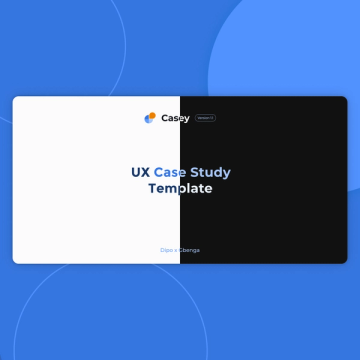
Long form research case study template with customizable styles.
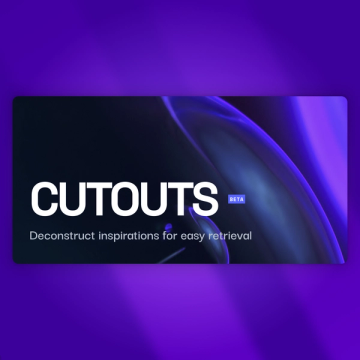
Design presentation deck
Modern design deck template with multiple sections.

Visual portfolio template
Modern visual portfolio template with 12 column grid and light and dark themes.

Behance Presentation Template
Case study template with multiple components, visual styles and frame sizes.
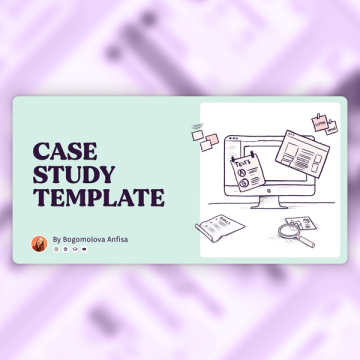
Case study template
Case study template with pastel style coloring.
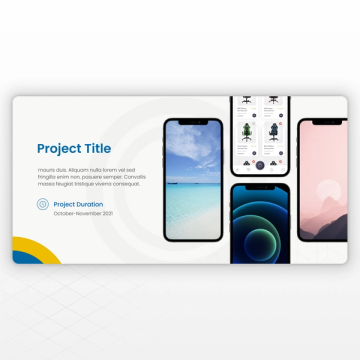
Holistic Case Study Template
Case study presentation template complete with project overview, wireframes and key journey insights.

Case study presentation layout for interview
Case study template with multiple app UI screens.
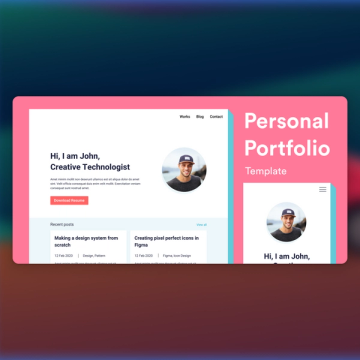
Portfolio UI - Web & Mobile
A portfolio UI for designers and developers which has 4 unique pages includes blog, case study.

Apple device mockups
Complete Apple device mockup screens for iPhone, Mac, iPad and Apple Watch.
Explore 1,000+ templates on the Figma community
Explore even more templates, widgets, and plugins—all built by the Figma community.

Business growth
Marketing tips
16 case study examples (+ 3 templates to make your own)

I like to think of case studies as a business's version of a resume. It highlights what the business can do, lends credibility to its offer, and contains only the positive bullet points that paint it in the best light possible.
Imagine if the guy running your favorite taco truck followed you home so that he could "really dig into how that burrito changed your life." I see the value in the practice. People naturally prefer a tried-and-true burrito just as they prefer tried-and-true products or services.
To help you showcase your success and flesh out your burrito questionnaire, I've put together some case study examples and key takeaways.
What is a case study?
A case study is an in-depth analysis of how your business, product, or service has helped past clients. It can be a document, a webpage, or a slide deck that showcases measurable, real-life results.
For example, if you're a SaaS company, you can analyze your customers' results after a few months of using your product to measure its effectiveness. You can then turn this analysis into a case study that further proves to potential customers what your product can do and how it can help them overcome their challenges.
It changes the narrative from "I promise that we can do X and Y for you" to "Here's what we've done for businesses like yours, and we can do it for you, too."

16 case study examples
While most case studies follow the same structure, quite a few try to break the mold and create something unique. Some businesses lean heavily on design and presentation, while others pursue a detailed, stat-oriented approach. Some businesses try to mix both.
There's no set formula to follow, but I've found that the best case studies utilize impactful design to engage readers and leverage statistics and case details to drive the point home. A case study typically highlights the companies, the challenges, the solution, and the results. The examples below will help inspire you to do it, too.
1. .css-1l9i3yq-Link[class][class][class][class][class]{all:unset;box-sizing:border-box;-webkit-text-fill-color:currentColor;cursor:pointer;}.css-1l9i3yq-Link[class][class][class][class][class]{all:unset;box-sizing:border-box;-webkit-text-decoration:underline;text-decoration:underline;cursor:pointer;-webkit-transition:all 300ms ease-in-out;transition:all 300ms ease-in-out;outline-offset:1px;-webkit-text-fill-color:currentColor;outline:1px solid transparent;}.css-1l9i3yq-Link[class][class][class][class][class][data-color='ocean']{color:#3d4592;}.css-1l9i3yq-Link[class][class][class][class][class][data-color='ocean']:hover{color:#2b2358;}.css-1l9i3yq-Link[class][class][class][class][class][data-color='ocean']:focus{color:#3d4592;outline-color:#3d4592;}.css-1l9i3yq-Link[class][class][class][class][class][data-color='white']{color:#fffdf9;}.css-1l9i3yq-Link[class][class][class][class][class][data-color='white']:hover{color:#a8a5a0;}.css-1l9i3yq-Link[class][class][class][class][class][data-color='white']:focus{color:#fffdf9;outline-color:#fffdf9;}.css-1l9i3yq-Link[class][class][class][class][class][data-color='primary']{color:#3d4592;}.css-1l9i3yq-Link[class][class][class][class][class][data-color='primary']:hover{color:#2b2358;}.css-1l9i3yq-Link[class][class][class][class][class][data-color='primary']:focus{color:#3d4592;outline-color:#3d4592;}.css-1l9i3yq-Link[class][class][class][class][class][data-color='secondary']{color:#fffdf9;}.css-1l9i3yq-Link[class][class][class][class][class][data-color='secondary']:hover{color:#a8a5a0;}.css-1l9i3yq-Link[class][class][class][class][class][data-color='secondary']:focus{color:#fffdf9;outline-color:#fffdf9;}.css-1l9i3yq-Link[class][class][class][class][class][data-weight='inherit']{font-weight:inherit;}.css-1l9i3yq-Link[class][class][class][class][class][data-weight='normal']{font-weight:400;}.css-1l9i3yq-Link[class][class][class][class][class][data-weight='bold']{font-weight:700;} Volcanica Coffee and AdRoll

People love a good farm-to-table coffee story, and boy am I one of them. But I've shared this case study with you for more reasons than my love of coffee. I enjoyed this study because it was written as though it was a letter.
In this case study, the founder of Volcanica Coffee talks about the journey from founding the company to personally struggling with learning and applying digital marketing to finding and enlisting AdRoll's services.
It felt more authentic, less about AdRoll showcasing their worth and more like a testimonial from a grateful and appreciative client. After the story, the case study wraps up with successes, milestones, and achievements. Note that quite a few percentages are prominently displayed at the top, providing supporting evidence that backs up an inspiring story.
Takeaway: Highlight your goals and measurable results to draw the reader in and provide concise, easily digestible information.
2. Taylor Guitars and Airtable

This Airtable case study on Taylor Guitars comes as close as one can to an optimal structure. It features a video that represents the artistic nature of the client, highlighting key achievements and dissecting each element of Airtable's influence.
It also supplements each section with a testimonial or quote from the client, using their insights as a catalyst for the case study's narrative. For example, the case study quotes the social media manager and project manager's insights regarding team-wide communication and access before explaining in greater detail.
Takeaway: Highlight pain points your business solves for its client, and explore that influence in greater detail.
3. EndeavourX and Figma

My favorite part of Figma's case study is highlighting why EndeavourX chose its solution. You'll notice an entire section on what Figma does for teams and then specifically for EndeavourX.
It also places a heavy emphasis on numbers and stats. The study, as brief as it is, still manages to pack in a lot of compelling statistics about what's possible with Figma.
Takeaway: Showcase the "how" and "why" of your product's differentiators and how they benefit your customers.
4. ActiveCampaign and Zapier

Zapier's case study leans heavily on design, using graphics to present statistics and goals in a manner that not only remains consistent with the branding but also actively pushes it forward, drawing users' eyes to the information most important to them.
The graphics, emphasis on branding elements, and cause/effect style tell the story without requiring long, drawn-out copy that risks boring readers. Instead, the cause and effect are concisely portrayed alongside the client company's information for a brief and easily scannable case study.
Takeaway: Lean on design to call attention to the most important elements of your case study, and make sure it stays consistent with your branding.
5. Ironclad and OpenAI

In true OpenAI fashion, this case study is a block of text. There's a distinct lack of imagery, but the study features a narrated video walking readers through the product.
The lack of imagery and color may not be the most inviting, but utilizing video format is commendable. It helps thoroughly communicate how OpenAI supported Ironclad in a way that allows the user to sit back, relax, listen, and be impressed.
Takeaway: Get creative with the media you implement in your case study. Videos can be a very powerful addition when a case study requires more detailed storytelling.
6. Shopify and GitHub

GitHub's case study on Shopify is a light read. It addresses client pain points and discusses the different aspects its product considers and improves for clients. It touches on workflow issues, internal systems, automation, and security. It does a great job of representing what one company can do with GitHub.
To drive the point home, the case study features colorful quote callouts from the Shopify team, sharing their insights and perspectives on the partnership, the key issues, and how they were addressed.
Takeaway: Leverage quotes to boost the authoritativeness and trustworthiness of your case study.
7 . Audible and Contentful

Contentful's case study on Audible features almost every element a case study should. It includes not one but two videos and clearly outlines the challenge, solution, and outcome before diving deeper into what Contentful did for Audible. The language is simple, and the writing is heavy with quotes and personal insights.
This case study is a uniquely original experience. The fact that the companies in question are perhaps two of the most creative brands out there may be the reason. I expected nothing short of a detailed analysis, a compelling story, and video content.
Takeaway: Inject some brand voice into the case study, and create assets that tell the story for you.
8 . Zoom and Asana

Asana's case study on Zoom is longer than the average piece and features detailed data on Zoom's growth since 2020. Instead of relying on imagery and graphics, it features several quotes and testimonials.
It's designed to be direct, informative, and promotional. At some point, the case study reads more like a feature list. There were a few sections that felt a tad too promotional for my liking, but to each their own burrito.
Takeaway: Maintain a balance between promotional and informative. You want to showcase the high-level goals your product helped achieve without losing the reader.
9 . Hickies and Mailchimp

I've always been a fan of Mailchimp's comic-like branding, and this case study does an excellent job of sticking to their tradition of making information easy to understand, casual, and inviting.
It features a short video that briefly covers Hickies as a company and Mailchimp's efforts to serve its needs for customer relationships and education processes. Overall, this case study is a concise overview of the partnership that manages to convey success data and tell a story at the same time. What sets it apart is that it does so in a uniquely colorful and brand-consistent manner.
Takeaway: Be concise to provide as much value in as little text as possible.
10. NVIDIA and Workday

The gaming industry is notoriously difficult to recruit for, as it requires a very specific set of skills and experience. This case study focuses on how Workday was able to help fill that recruitment gap for NVIDIA, one of the biggest names in the gaming world.
Though it doesn't feature videos or graphics, this case study stood out to me in how it structures information like "key products used" to give readers insight into which tools helped achieve these results.
Takeaway: If your company offers multiple products or services, outline exactly which ones were involved in your case study, so readers can assess each tool.
11. KFC and Contentful

I'm personally not a big KFC fan, but that's only because I refuse to eat out of a bucket. My aversion to the bucket format aside, Contentful follows its consistent case study format in this one, outlining challenges, solutions, and outcomes before diving into the nitty-gritty details of the project.
Say what you will about KFC, but their primary product (chicken) does present a unique opportunity for wordplay like "Continuing to march to the beat of a digital-first drum(stick)" or "Delivering deep-fried goodness to every channel."
Takeaway: Inject humor into your case study if there's room for it and if it fits your brand.
12. Intuit and Twilio

Twilio does an excellent job of delivering achievements at the very beginning of the case study and going into detail in this two-minute read. While there aren't many graphics, the way quotes from the Intuit team are implemented adds a certain flair to the study and breaks up the sections nicely.
It's simple, concise, and manages to fit a lot of information in easily digestible sections.
Takeaway: Make sure each section is long enough to inform but brief enough to avoid boring readers. Break down information for each section, and don't go into so much detail that you lose the reader halfway through.
13. Spotify and Salesforce

Salesforce created a video that accurately summarizes the key points of the case study. Beyond that, the page itself is very light on content, and sections are as short as one paragraph.
I especially like how information is broken down into "What you need to know," "Why it matters," and "What the difference looks like." I'm not ashamed of being spoon-fed information. When it's structured so well and so simply, it makes for an entertaining read.
Takeaway: Invest in videos that capture and promote your partnership with your case study subject. Video content plays a promotional role that extends beyond the case study in social media and marketing initiatives .
14. Benchling and Airtable

Benchling is an impressive entity in its own right. Biotech R&D and health care nuances go right over my head. But the research and digging I've been doing in the name of these burritos (case studies) revealed that these products are immensely complex.
And that's precisely why this case study deserves a read—it succeeds at explaining a complex project that readers outside the industry wouldn't know much about.
Takeaway: Simplify complex information, and walk readers through the company's operations and how your business helped streamline them.
15. Chipotle and Hubble

The concision of this case study is refreshing. It features two sections—the challenge and the solution—all in 316 words. This goes to show that your case study doesn't necessarily need to be a four-figure investment with video shoots and studio time.
Sometimes, the message is simple and short enough to convey in a handful of paragraphs.
Takeaway: Consider what you should include instead of what you can include. Assess the time, resources, and effort you're able and willing to invest in a case study, and choose which elements you want to include from there.
16. Hudl and Zapier

I may be biased, but I'm a big fan of seeing metrics and achievements represented in branded graphics. It can be a jarring experience to navigate a website, then visit a case study page and feel as though you've gone to a completely different website.
The Zapier format provides nuggets of high-level insights, milestones, and achievements, as well as the challenge, solution, and results. My favorite part of this case study is how it's supplemented with a blog post detailing how Hudl uses Zapier automation to build a seamless user experience.
The case study is essentially the summary, and the blog article is the detailed analysis that provides context beyond X achievement or Y goal.
Takeaway: Keep your case study concise and informative. Create other resources to provide context under your blog, media or press, and product pages.
3 case study templates
Now that you've had your fill of case studies (if that's possible), I've got just what you need: an infinite number of case studies, which you can create yourself with these case study templates.
Case study template 1

If you've got a quick hit of stats you want to show off, try this template. The opening section gives space for a short summary and three visually appealing stats you can highlight, followed by a headline and body where you can break the case study down more thoroughly. This one's pretty simple, with only sections for solutions and results, but you can easily continue the formatting to add more sections as needed.
Case study template 2

For a case study template with a little more detail, use this one. Opening with a striking cover page for a quick overview, this one goes on to include context, stakeholders, challenges, multiple quote callouts, and quick-hit stats.
Case study template 3

Whether you want a little structural variation or just like a nice dark green, this template has similar components to the last template but is designed to help tell a story. Move from the client overview through a description of your company before getting to the details of how you fixed said company's problems.
Tips for writing a case study
Examples are all well and good, but you don't learn how to make a burrito just by watching tutorials on YouTube without knowing what any of the ingredients are. You could , but it probably wouldn't be all that good.
Writing a good case study comes down to a mix of creativity, branding, and the capacity to invest in the project. With those details in mind, here are some case study tips to follow:
Have an objective: Define your objective by identifying the challenge, solution, and results. Assess your work with the client and focus on the most prominent wins. You're speaking to multiple businesses and industries through the case study, so make sure you know what you want to say to them.
Focus on persuasive data: Growth percentages and measurable results are your best friends. Extract your most compelling data and highlight it in your case study.
Use eye-grabbing graphics: Branded design goes a long way in accurately representing your brand and retaining readers as they review the study. Leverage unique and eye-catching graphics to keep readers engaged.
Simplify data presentation: Some industries are more complex than others, and sometimes, data can be difficult to understand at a glance. Make sure you present your data in the simplest way possible. Make it concise, informative, and easy to understand.
Use automation to drive results for your case study
A case study example is a source of inspiration you can leverage to determine how to best position your brand's work. Find your unique angle, and refine it over time to help your business stand out. Ask anyone: the best burrito in town doesn't just appear at the number one spot. They find their angle (usually the house sauce) and leverage it to stand out.
In fact, with the right technology, it can be refined to work better . Explore how Zapier's automation features can help drive results for your case study by making your case study a part of a developed workflow that creates a user journey through your website, your case studies, and into the pipeline.
Case study FAQ
Got your case study template? Great—it's time to gather the team for an awkward semi-vague data collection task. While you do that, here are some case study quick answers for you to skim through while you contemplate what to call your team meeting.
What is an example of a case study?
An example of a case study is when a software company analyzes its results from a client project and creates a webpage, presentation, or document that focuses on high-level results, challenges, and solutions in an attempt to showcase effectiveness and promote the software.
How do you write a case study?
To write a good case study, you should have an objective, identify persuasive and compelling data, leverage graphics, and simplify data. Case studies typically include an analysis of the challenge, solution, and results of the partnership.
What is the format of a case study?
While case studies don't have a set format, they're often portrayed as reports or essays that inform readers about the partnership and its results.
Related reading:
How Hudl uses automation to create a seamless user experience
How to make your case studies high-stakes—and why it matters
How experts write case studies that convert, not bore
Get productivity tips delivered straight to your inbox
We’ll email you 1-3 times per week—and never share your information.

Hachem Ramki
Hachem is a writer and digital marketer from Montreal. After graduating with a degree in English, Hachem spent seven years traveling around the world before moving to Canada. When he's not writing, he enjoys Basketball, Dungeons and Dragons, and playing music for friends and family.
- Content marketing
Related articles

8 essential tips for maximizing TikTok ads ROI
8 essential tips for maximizing TikTok ads...

The best marketing newsletters in 2024

11 Google Ads examples (and how to use their strategies)
11 Google Ads examples (and how to use their...

How will AI change SEO content production?
Improve your productivity automatically. Use Zapier to get your apps working together.

Filter by Keywords
15 Best Case Study Templates to Use in Word and ClickUp
Praburam Srinivasan
Growth Marketing Manager
February 14, 2024
Case studies are valuable tools for sharing customer success stories and analyzing problem-solving approaches in a structured and informative manner. They can be used to provide detailed insights into specific projects, strategies, or challenges and offer valuable lessons and best practices for professionals across various fields.
Content marketing teams often create case studies as a way to gain more customers and get new business. Case studies can give potential customers a better understanding of your company brand , what it does and how you could potentially help them.
However, creating a compelling case study from scratch can be a time-consuming task. That’s where marketing case study examples and templates can help.
What is a Case Study Template?
What makes a good case study template, 1. clickup case study template, 2. clickup case study design template, 3. clickup research report template, 4. clickup market research template, 5. clickup user research plan template, 6. clickup data analysis findings template, 7. clickup campaign report template, 8. clickup research whiteboard, 9. google docs case study template by wordstream, 10. word case study report template by template.net, 11. word case brief summary template by template.net, 12. word case study report template by template.net, 13. word case study research template by template.net, 14. word psychology case study template by template.net, 15. word media case study template by template.net.
A case study template is a pre-designed framework that serves as a starting point for creating comprehensive and structured case study documents. It provides a standardized, traditional case study format for organizing and presenting information about a particular project, problem-solving scenario, success story, or real-life situation.
Case study templates typically include sections for outlining the background and context of the case study, project documentation , describing the methodology or approach used, presenting data and analysis, and highlighting key findings and recommendations that tell the entire story.
Business case study examples like templates can work as a guide to help content marketers, blog post writers, and anyone else creating quality content that’s customer-facing, focus on important aspects and maintain a logical flow while telling a compelling story.
Some key elements that make a case study template stand out include:
- Clarity and organization: A well-designed template should be easy to navigate. Each section should be labeled appropriately, enabling readers to quickly find the information they seek
- Flexibility: A good case study template should be easily customizable and able to accommodate diverse scenarios. It should be adaptable to different industries, research methodologies, and presentation styles
- Visual appeal: Incorporating visual elements like charts, graphs, and other images can enhance a case study template’s look and make it more visually appealing. They can also aid in the comprehension of complex data. A visually engaging template can captivate readers and make the case study more impactful
15 Case Study Templates to Use in 2024
You don’t have to start from scratch when making your next case study. Instead, take a look at these carefully curated case study templates from ClickUp and Microsoft Word.

ClickUp’s Case Study Template can provide a great start for just about any type of case study you and your team want to write. It kicks off with a section for introducing both your business and the client or customer that the case study focuses on.
After introducing both yourself and the customer, you briefly highlight the customer’s experience and the successes you achieved before delivering a more detailed description of the work you performed and the measurable results you achieved.
The next section focuses on the objective of the case study—what the client’s goal and pain point was and why they decided you were the right company to help them achieve these goals.
The case study template then launches into a section describing the solutions you presented and the data that backs up your success. We created this marketing case study template for a marketing agency that helps customers achieve growth through paid media campaigns, but it can easily be edited to highlight any type of solution.

One of the best ways of telling a customer story using a case study is by allowing the customer to do most of the work themselves. When a case study is written by current or even previous customers, it feels more sincere and honest, especially to potential customers in the evaluation process.
If you want to try this technique out, use this ClickUp Study Design Template . You can send your customer this great case study template and allow them to fill it out themselves and basically write a case study for you. This gives you unfiltered and unbiased answers to the questions you want answered in the case study.
The case study template helps them understand what you want the case study to look like and how the customer’s story should be described. It also helps you get great customer quotes.
A template makes it easier for your customer to frame their experiences with you and easily explain how your product or service helped them. Hearing a peer’s success story from a firsthand perspective can be a more convincing read for prospective customers.
Manage customers with customer database software !

Case studies are essentially customer stories, which can be told in many ways and come in many formats. A research report is another excellent way to frame a case study.
This ClickUp Research Report Template is a step-by-step guide that can help your team create an easy-to-follow research report that allows you to clearly detail your research methods, findings, and the insights that you’ve gained from the research being presented.
This template has a very clear structure, allowing you to simply add the following: an executive summary (brief description), introduction, the methodology used, your results, references, and any necessary appendices if supplementary material needs to be referenced in your research report.
If you need more templates like this, check out this list of research plan templates .

Companies perform market research in order to define what their customers want and need from them. This type of research also helps you to improve product and service offers and learn more about what your competitors are doing and where the success of other businesses stems from.
ClickUp’s Market Research Template gives you a simple-to-follow document that helps you gather and present information related to your target audience, the state of your product/service, and the state of your industry at large.
When you perform marketing research, you are aiming to confirm your hunches about customer needs through scientific research and tangible data.
Marketing case study examples like this are perfect because they’re very simplified and easily customizable. It offers you a section for presenting your company and why you are performing marketing research first.
The template then guides you in describing the type of research you’re doing, how you went about performing market research, data collection techniques, and what insights were garnered—whether it was from existing or potential customers.
Check out these research management tools !

Another type of customer-centric report that you can put together is a user research report. ClickUp’s User Research Plan Template makes it easy for you to define all of the goals and details that you want included in your user research.
The template is particularly useful for user experience (UX) teams that want to perform user persona research in order to better understand what users need and how they behave when using their product, in order to deliver a better experience to them and to new clients.
The template starts with a “ problem statement ” where you can define the problem that the user research report is aiming to solve. Next, you’ll list the goals that you want to achieve and then clearly define the research process.
This type of marketing case study template and report can show you what a satisfied customer looks like and give you insights that help to attract and retain future customers.
Check out these user persona templates !

Another important study that your business can perform in order to make smarter decisions is data analysis. ClickUp’s Data Analysis Findings template makes it easy for your team to perform data analysis and present it clearly to key stakeholders.
This template also starts by setting the stage for the study and explaining it, first with a problem statement and then by explaining the significance of the study.
Next, the template recommends that you define the scope and limitations of the study to set expectations for its potential impact. The next step is to frame your analysis methods and provide the data sources that you used in the analysis, as well as the statistical methods used.
Finally, you can present your findings in a clear and concise way. The template also includes charts and other data visualization tools you can use to make the study more engaging.
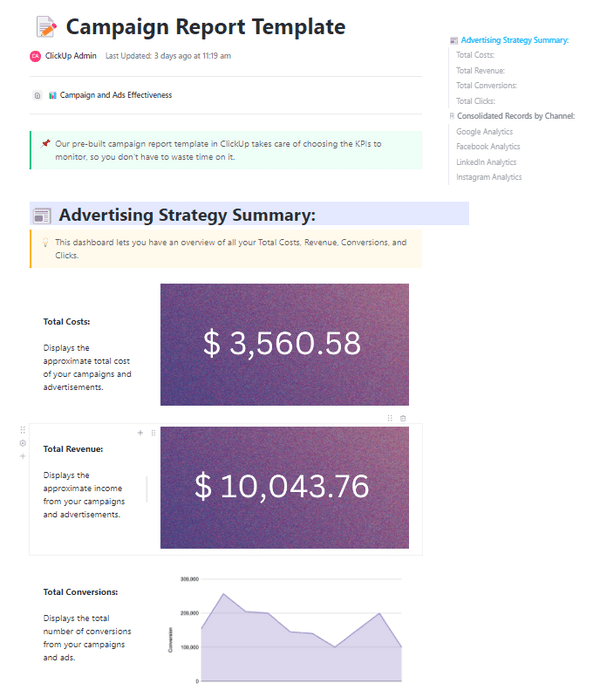
This ClickUp Campaign Report template is pre-built to make it incredibly easy to present the results of any ad campaign to stakeholders very easily.
It starts with a section describing your strategy in detail, including the total costs, and the total revenue, conversions, and clicks that you expect to achieve with the campaign.
The marketing case study template then provides charts and graphs that you can use to detail the performance of your campaigns on every single channel that you use. Case study templates like this are great for detailing information on potential customers to know how to better run your campaigns in the future.
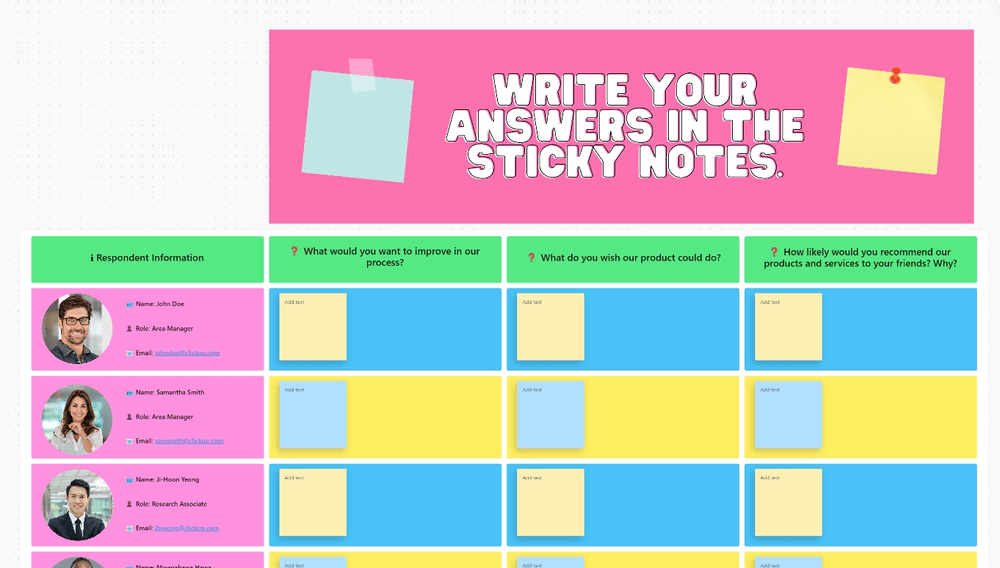
Make your next user research project a collaborative, visual experience. Give everyone on your team a chance to add their thoughts and findings with virtual sticky notes using the ClickUp Research Whiteboard Template .
This is one of the more flexible case study templates in this list. Its user research tool makes it easy to take all the random bits of information your team gathers through interviews, surveys, user sessions, and other methods of feedback into one location.
Then, you can quickly organize all of that data into clear categories that make this case study template easy to see at a glance what direction you need to take your project to satisfy your customers.

If you’re writing many case studies, it’s a good idea to try out a bunch of templates over time for added inspiration. Even if you’ve found one structure works great for your case studies, changing your structure up every now and then can give you a fresh perspective on how to present a featured client.
Another good case study you can check out is Wordstream’s Case Study Template. It has an excellent structure and provides pre-built visual cues that give you some ideas for breaking up business case study examples and making them more appealing with pictures and charts.
Use this template to showcase particular customers’ results and share customer pain points and how they were solved. This will help you provide clear evidence to potential customers that you will be able to help them as well.

Template.net is one of the biggest websites if you’re looking for business templates. It’s especially popular for businesses that prefer creating documents in Microsoft Word and Excel.
This Case Study Template from Template.net is sparse, but it gets right to the point and is very well-structured and easy to follow.

This Microsoft Word case study template is a great way to get right down to business! It features a clean and organized layout with clear headings and subheadings, making it easy for readers to navigate. This template also includes space for a brief summary of the case study, perfect for giving readers an overview before diving into the details.
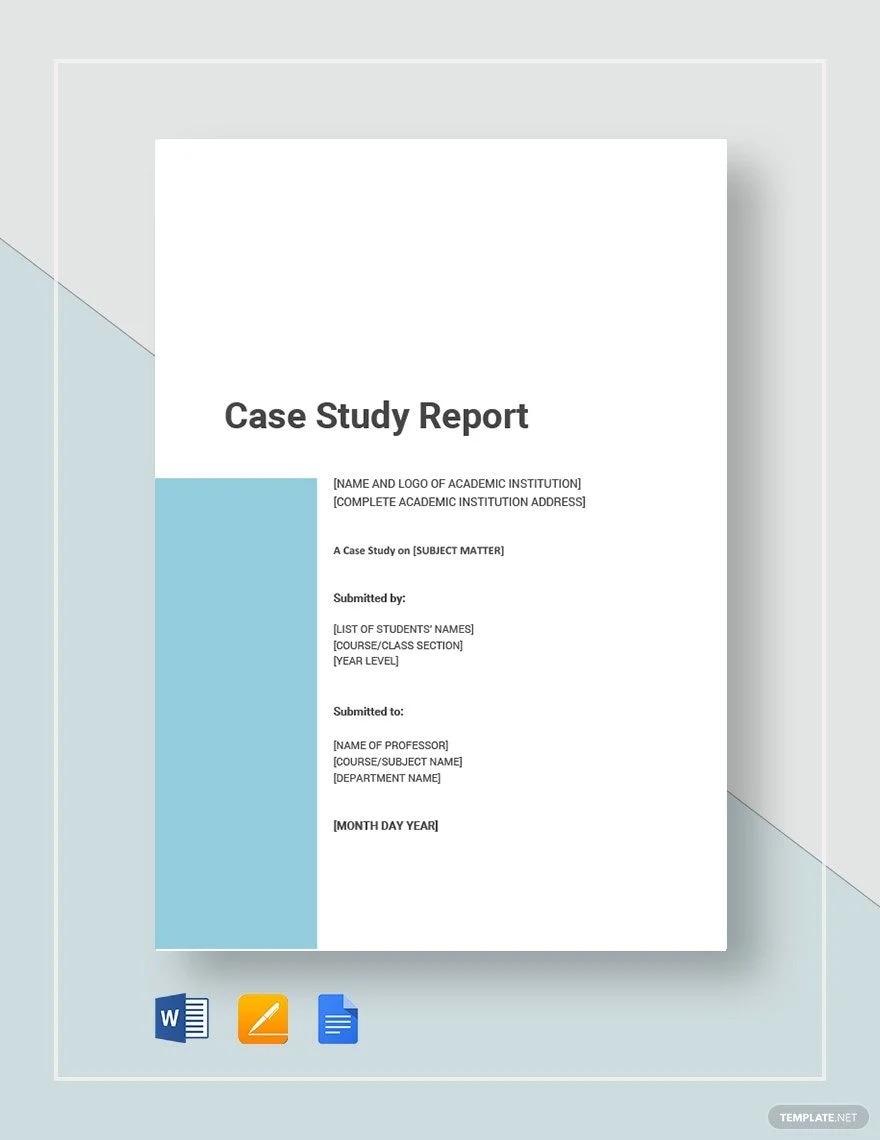
This Microsoft Word case study template is a great option for creating an in-depth report on your findings. The template includes sections for an executive summary, introduction, methodology, results, references, and appendices. It also features a clear structure to make it easy to gather and present information in a cohesive manner. The template also includes sections for an introduction, methodology, findings, and recommendations, ensuring that all the essential elements of a case study are covered.
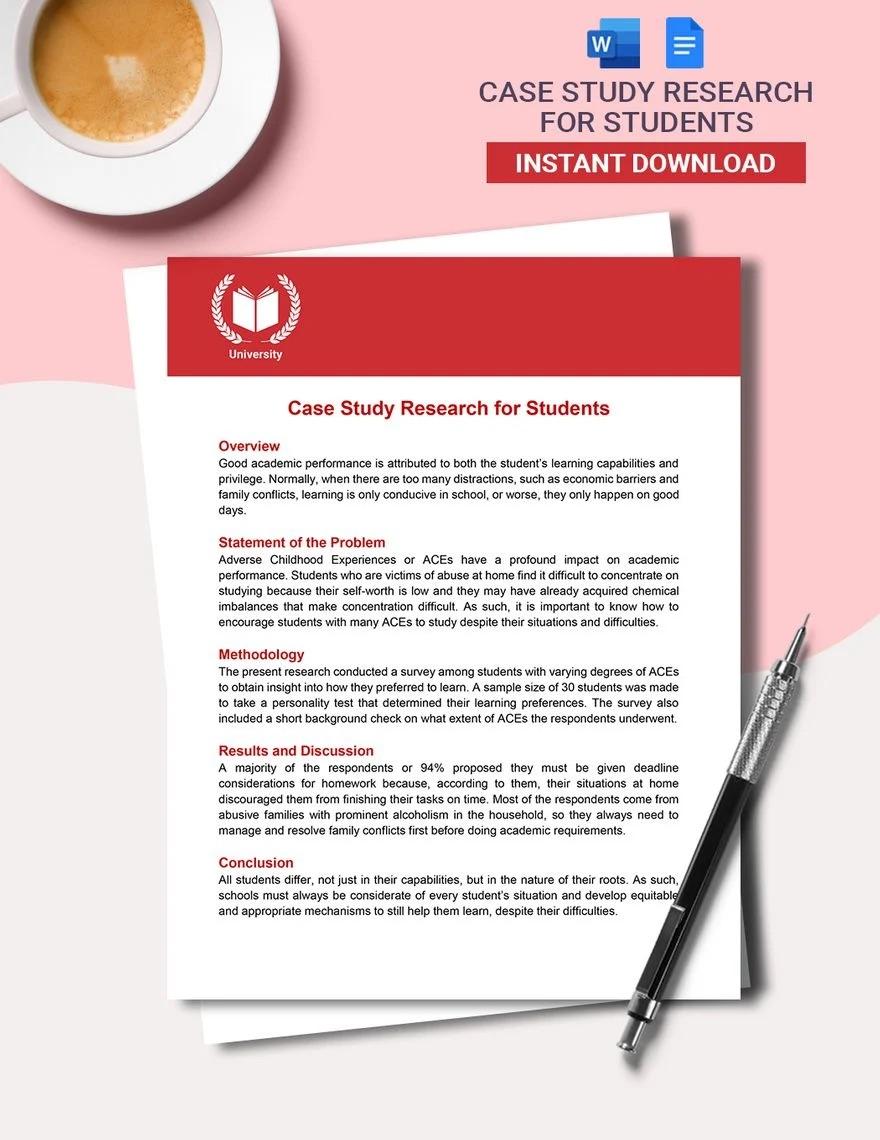
This Word case study template features a professional and organized design with clearly labeled sections for the introduction, methodology, findings, and conclusion. It also includes space for charts and graphs to visually represent data.
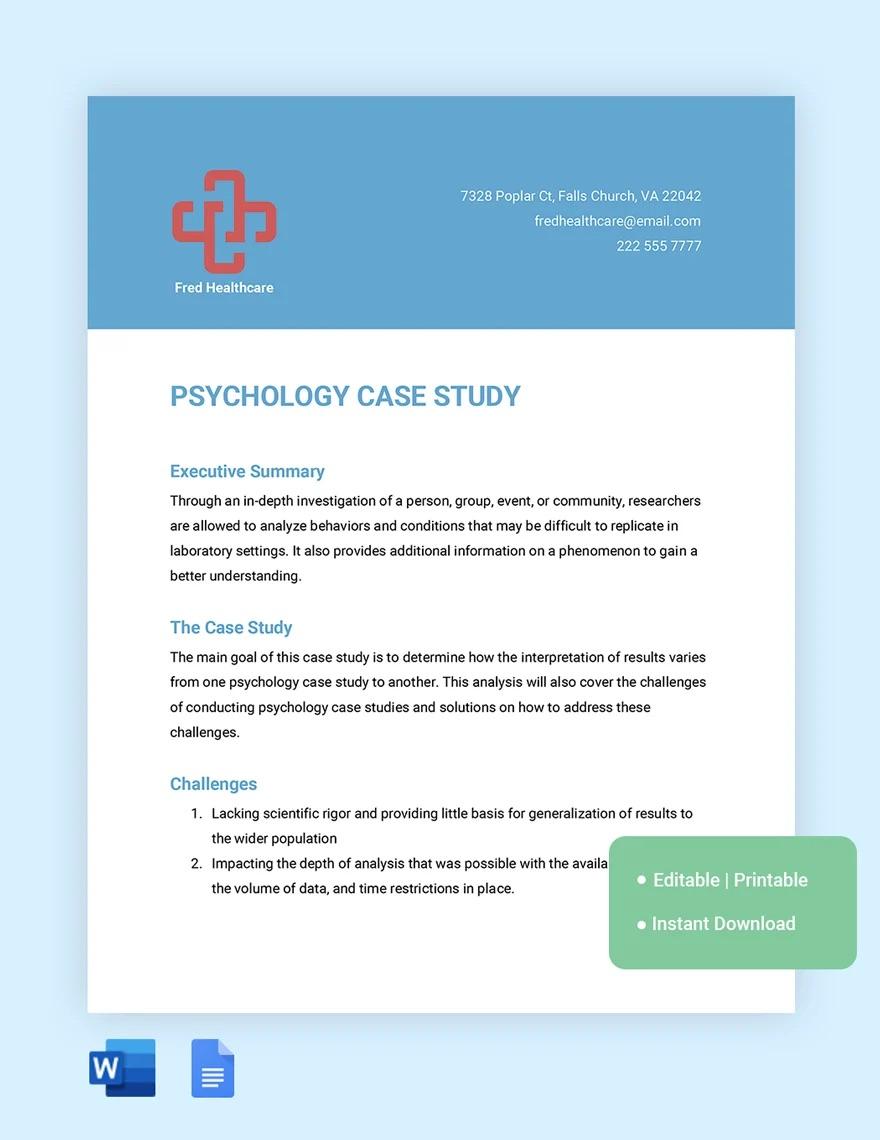
Psychology case studies can be complex and detailed, making it important to have a well-organized template to present the information. The Psychology Case Study Template is perfect for this task, with clear headings and subheadings that guide readers through each section of the study. It also includes sections for summarizing key points and providing recommendations based on the findings.
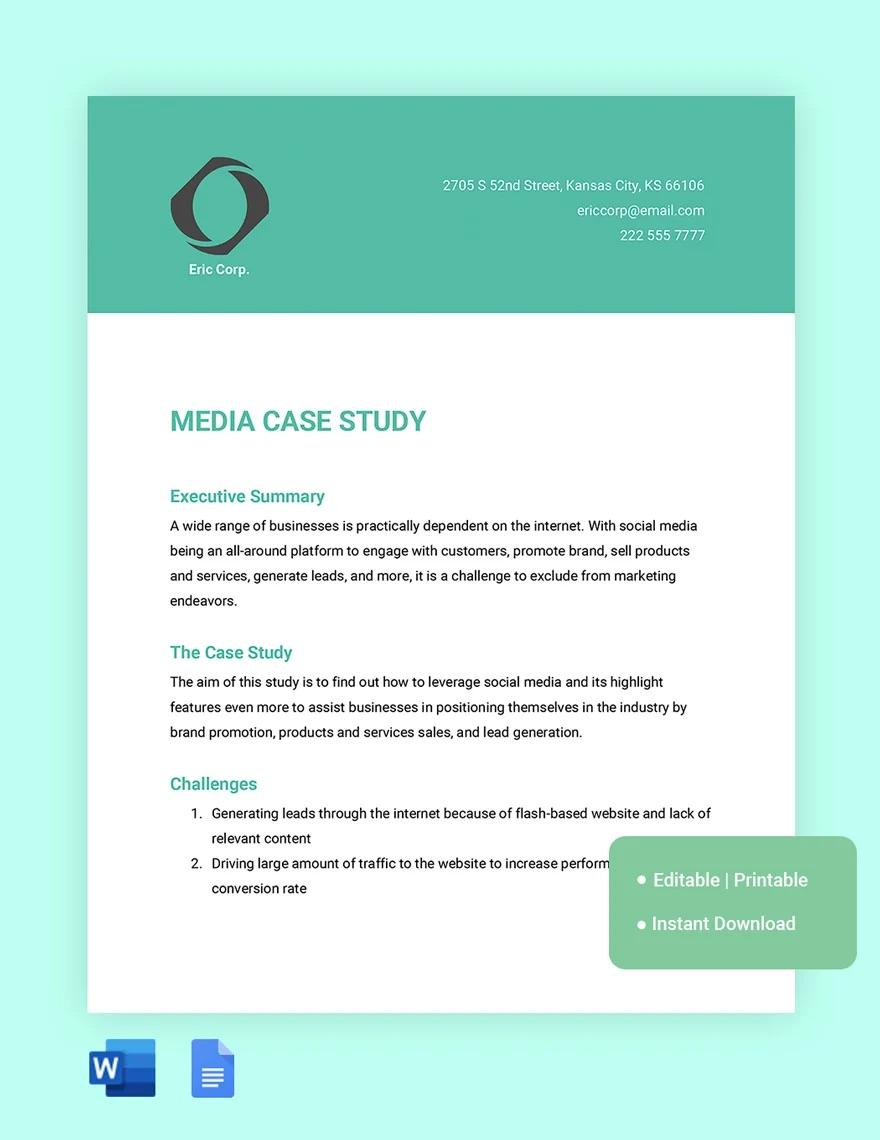
This media case study template from Template.net is perfect for showcasing the success of a marketing or advertising campaign! It includes space for key metrics, such as reach and engagement, and also has sections for outlining the challenges faced and solutions implemented. With its clean design and easy-to-follow layout, this template is ideal for presenting media case studies to clients or stakeholders.
It’s Easy to Make a Case for Using ClickUp Case Study Templates
People trust other people. That’s why personal recommendations are one of the most effective marketing tactics. A case study provides your company with just that—a personal recommendation from a client you’ve helping, telling others that you can do the same for them.
In the selection process of choosing a product or service to go with, companies will always look at the experiences of other organizations similar to them. Marketing case studies are sincere yet persuasive and clearly show how you help others and can be a very effective differentiator.
ClickUp was designed to serve teams in any industry and of any size. So it makes sense the case study templates we offer are just as diverse and customizable.
Best of all, they are completely free to use! Sign up for free to ClickUp to get immediate access to a massive amount of templates, free cloud storage, and of course, industry-leading project and team management features.
Questions? Comments? Visit our Help Center for support.
Receive the latest WriteClick Newsletter updates.
Thanks for subscribing to our blog!
Please enter a valid email
- Free training & 24-hour support
- Serious about security & privacy
- 99.99% uptime the last 12 months
We use essential cookies to make Venngage work. By clicking “Accept All Cookies”, you agree to the storing of cookies on your device to enhance site navigation, analyze site usage, and assist in our marketing efforts.
Manage Cookies
Cookies and similar technologies collect certain information about how you’re using our website. Some of them are essential, and without them you wouldn’t be able to use Venngage. But others are optional, and you get to choose whether we use them or not.
Strictly Necessary Cookies
These cookies are always on, as they’re essential for making Venngage work, and making it safe. Without these cookies, services you’ve asked for can’t be provided.
Show cookie providers
- Google Login
Functionality Cookies
These cookies help us provide enhanced functionality and personalisation, and remember your settings. They may be set by us or by third party providers.
Performance Cookies
These cookies help us analyze how many people are using Venngage, where they come from and how they're using it. If you opt out of these cookies, we can’t get feedback to make Venngage better for you and all our users.
- Google Analytics
Targeting Cookies
These cookies are set by our advertising partners to track your activity and show you relevant Venngage ads on other sites as you browse the internet.
- Google Tag Manager
- Infographics
- Daily Infographics
- Graphic Design
- Graphs and Charts
- Data Visualization
- Human Resources
- Training and Development
- Beginner Guides
Blog Graphic Design
15+ Professional Case Study Examples [Design Tips + Templates]
By Alice Corner , Jan 12, 2023

Have you ever bought something — within the last 10 years or so — without reading its reviews or without a recommendation or prior experience of using it?
If the answer is no — or at least, rarely — you get my point.
Positive reviews matter for selling to regular customers, and for B2B or SaaS businesses, detailed case studies are important too.
Wondering how to craft a compelling case study ? No worries—I’ve got you covered with 15 marketing case study templates , helpful tips, and examples to ensure your case study converts effectively.
Click to jump ahead:
- What is a Case Study?
Business Case Study Examples
Simple case study examples.
- Marketing Case Study Examples
Sales Case Study Examples
- Case Study FAQs
What is a case study?
A case study is an in-depth, detailed analysis of a specific real-world situation. For example, a case study can be about an individual, group, event, organization, or phenomenon. The purpose of a case study is to understand its complexities and gain insights into a particular instance or situation.
In the context of a business, however, case studies take customer success stories and explore how they use your product to help them achieve their business goals.

As well as being valuable marketing tools , case studies are a good way to evaluate your product as it allows you to objectively examine how others are using it.
It’s also a good way to interview your customers about why they work with you.
Related: What is a Case Study? [+6 Types of Case Studies]
Marketing Case Study Template
A marketing case study showcases how your product or services helped potential clients achieve their business goals. You can also create case studies of internal, successful marketing projects. A marketing case study typically includes:
- Company background and history
- The challenge
- How you helped
- Specific actions taken
- Visuals or Data
- Client testimonials
Here’s an example of a marketing case study template:

Whether you’re a B2B or B2C company, business case studies can be a powerful resource to help with your sales, marketing, and even internal departmental awareness.
Business and business management case studies should encompass strategic insights alongside anecdotal and qualitative findings, like in the business case study examples below.
Conduct a B2B case study by researching the company holistically
When it comes to writing a case study, make sure you approach the company holistically and analyze everything from their social media to their sales.
Think about every avenue your product or service has been of use to your case study company, and ask them about the impact this has had on their wider company goals.

In business case study examples like the one above, we can see that the company has been thought about holistically simply by the use of icons.
By combining social media icons with icons that show in-person communication we know that this is a well-researched and thorough case study.
This case study report example could also be used within an annual or end-of-year report.
Highlight the key takeaway from your marketing case study
To create a compelling case study, identify the key takeaways from your research. Use catchy language to sum up this information in a sentence, and present this sentence at the top of your page.
This is “at a glance” information and it allows people to gain a top-level understanding of the content immediately.

You can use a large, bold, contrasting font to help this information stand out from the page and provide interest.
Learn how to choose fonts effectively with our Venngage guide and once you’ve done that.
Upload your fonts and brand colors to Venngage using the My Brand Kit tool and see them automatically applied to your designs.
The heading is the ideal place to put the most impactful information, as this is the first thing that people will read.
In this example, the stat of “Increase[d] lead quality by 90%” is used as the header. It makes customers want to read more to find out how exactly lead quality was increased by such a massive amount.

If you’re conducting an in-person interview, you could highlight a direct quote or insight provided by your interview subject.
Pick out a catchy sentence or phrase, or the key piece of information your interview subject provided and use that as a way to draw a potential customer in.
Use charts to visualize data in your business case studies
Charts are an excellent way to visualize data and to bring statistics and information to life. Charts make information easier to understand and to illustrate trends or patterns.
Making charts is even easier with Venngage.
In this consulting case study example, we can see that a chart has been used to demonstrate the difference in lead value within the Lead Elves case study.
Adding a chart here helps break up the information and add visual value to the case study.

Using charts in your case study can also be useful if you’re creating a project management case study.
You could use a Gantt chart or a project timeline to show how you have managed the project successfully.

Use direct quotes to build trust in your marketing case study
To add an extra layer of authenticity you can include a direct quote from your customer within your case study.
According to research from Nielsen , 92% of people will trust a recommendation from a peer and 70% trust recommendations even if they’re from somebody they don’t know.

So if you have a customer or client who can’t stop singing your praises, make sure you get a direct quote from them and include it in your case study.
You can either lift part of the conversation or interview, or you can specifically request a quote. Make sure to ask for permission before using the quote.

This design uses a bright contrasting speech bubble to show that it includes a direct quote, and helps the quote stand out from the rest of the text.
This will help draw the customer’s attention directly to the quote, in turn influencing them to use your product or service.
Less is often more, and this is especially true when it comes to creating designs. Whilst you want to create a professional-looking, well-written and design case study – there’s no need to overcomplicate things.
These simple case study examples show that smart clean designs and informative content can be an effective way to showcase your successes.
Use colors and fonts to create a professional-looking case study
Business case studies shouldn’t be boring. In fact, they should be beautifully and professionally designed.
This means the normal rules of design apply. Use fonts, colors, and icons to create an interesting and visually appealing case study.
In this case study example, we can see how multiple fonts have been used to help differentiate between the headers and content, as well as complementary colors and eye-catching icons.

Marketing case study examples
Marketing case studies are incredibly useful for showing your marketing successes. Every successful marketing campaign relies on influencing a consumer’s behavior, and a great case study can be a great way to spotlight your biggest wins.
In the marketing case study examples below, a variety of designs and techniques to create impactful and effective case studies.
Show off impressive results with a bold marketing case study
Case studies are meant to show off your successes, so make sure you feature your positive results prominently. Using bold and bright colors as well as contrasting shapes, large bold fonts, and simple icons is a great way to highlight your wins.
In well-written case study examples like the one below, the big wins are highlighted on the second page with a bright orange color and are highlighted in circles.
Making the important data stand out is especially important when attracting a prospective customer with marketing case studies.

Use a simple but clear layout in your case study
Using a simple layout in your case study can be incredibly effective, like in the example of a case study below.
Keeping a clean white background, and using slim lines to help separate the sections is an easy way to format your case study.
Making the information clear helps draw attention to the important results, and it helps improve the accessibility of the design .
Business case study examples like this would sit nicely within a larger report, with a consistent layout throughout.

Use visuals and icons to create an engaging and branded business case study
Nobody wants to read pages and pages of text — and that’s why Venngage wants to help you communicate your ideas visually.
Using icons, graphics, photos, or patterns helps create a much more engaging design.
With this Blue Cap case study icons, colors, and impactful pattern designs have been used to create an engaging design that catches your eye.

Use a monochromatic color palette to create a professional and clean case study
Let your research shine by using a monochromatic and minimalistic color palette.
By sticking to one color, and leaving lots of blank space you can ensure your design doesn’t distract a potential customer from your case study content.

In this case study on Polygon Media, the design is simple and professional, and the layout allows the prospective customer to follow the flow of information.
The gradient effect on the left-hand column helps break up the white background and adds an interesting visual effect.

Did you know you can generate an accessible color palette with Venngage? Try our free accessible color palette generator today and create a case study that delivers and looks pleasant to the eye:

Add long term goals in your case study
When creating a case study it’s a great idea to look at both the short term and the long term goals of the company to gain the best understanding possible of the insights they provide.
Short-term goals will be what the company or person hopes to achieve in the next few months, and long-term goals are what the company hopes to achieve in the next few years.
Check out this modern pattern design example of a case study below:

In this case study example, the short and long-term goals are clearly distinguished by light blue boxes and placed side by side so that they are easy to compare.

Use a strong introductory paragraph to outline the overall strategy and goals before outlining the specific short-term and long-term goals to help with clarity.
This strategy can also be handy when creating a consulting case study.
Use data to make concrete points about your sales and successes
When conducting any sort of research stats, facts, and figures are like gold dust (aka, really valuable).
Being able to quantify your findings is important to help understand the information fully. Saying sales increased 10% is much more effective than saying sales increased.
While sales dashboards generally tend it make it all about the numbers and charts, in sales case study examples, like this one, the key data and findings can be presented with icons. This contributes to the potential customer’s better understanding of the report.
They can clearly comprehend the information and it shows that the case study has been well researched.

Use emotive, persuasive, or action based language in your marketing case study
Create a compelling case study by using emotive, persuasive and action-based language when customizing your case study template.

In this well-written case study example, we can see that phrases such as “Results that Speak Volumes” and “Drive Sales” have been used.
Using persuasive language like you would in a blog post. It helps inspire potential customers to take action now.

Keep your potential customers in mind when creating a customer case study for marketing
82% of marketers use case studies in their marketing because it’s such an effective tool to help quickly gain customers’ trust and to showcase the potential of your product.
Why are case studies such an important tool in content marketing?
By writing a case study you’re telling potential customers that they can trust you because you’re showing them that other people do.
Not only that, but if you have a SaaS product, business case studies are a great way to show how other people are effectively using your product in their company.
In this case study, Network is demonstrating how their product has been used by Vortex Co. with great success; instantly showing other potential customers that their tool works and is worth using.

Related: 10+ Case Study Infographic Templates That Convert
Case studies are particularly effective as a sales technique.
A sales case study is like an extended customer testimonial, not only sharing opinions of your product – but showcasing the results you helped your customer achieve.
Make impactful statistics pop in your sales case study
Writing a case study doesn’t mean using text as the only medium for sharing results.
You should use icons to highlight areas of your research that are particularly interesting or relevant, like in this example of a case study:

Icons are a great way to help summarize information quickly and can act as visual cues to help draw the customer’s attention to certain areas of the page.
In some of the business case study examples above, icons are used to represent the impressive areas of growth and are presented in a way that grabs your attention.
Use high contrast shapes and colors to draw attention to key information in your sales case study
Help the key information stand out within your case study by using high contrast shapes and colors.
Use a complementary or contrasting color, or use a shape such as a rectangle or a circle for maximum impact.

This design has used dark blue rectangles to help separate the information and make it easier to read.
Coupled with icons and strong statistics, this information stands out on the page and is easily digestible and retainable for a potential customer.

Case Study Examples Summary
Once you have created your case study, it’s best practice to update your examples on a regular basis to include up-to-date statistics, data, and information.
You should update your business case study examples often if you are sharing them on your website .
It’s also important that your case study sits within your brand guidelines – find out how Venngage’s My Brand Kit tool can help you create consistently branded case study templates.
Case studies are important marketing tools – but they shouldn’t be the only tool in your toolbox. Content marketing is also a valuable way to earn consumer trust.
Case Study FAQ
Why should you write a case study.
Case studies are an effective marketing technique to engage potential customers and help build trust.
By producing case studies featuring your current clients or customers, you are showcasing how your tool or product can be used. You’re also showing that other people endorse your product.
In addition to being a good way to gather positive testimonials from existing customers , business case studies are good educational resources and can be shared amongst your company or team, and used as a reference for future projects.
How should you write a case study?
To create a great case study, you should think strategically. The first step, before starting your case study research, is to think about what you aim to learn or what you aim to prove.
You might be aiming to learn how a company makes sales or develops a new product. If this is the case, base your questions around this.
You can learn more about writing a case study from our extensive guide.
Related: How to Present a Case Study like a Pro (With Examples)
Some good questions you could ask would be:
- Why do you use our tool or service?
- How often do you use our tool or service?
- What does the process of using our product look like to you?
- If our product didn’t exist, what would you be doing instead?
- What is the number one benefit you’ve found from using our tool?
You might also enjoy:
- 12 Essential Consulting Templates For Marketing, Planning and Branding
- Best Marketing Strategies for Consultants and Freelancers in 2019 [Study + Infographic]
Free Case Study Templates
By Kate Eby | February 28, 2024
- Share on Facebook
- Share on LinkedIn
Link copied
We've collected free marketing case study templates for marketing managers, project coordinators, business strategists, and sales teams. Use these templates to organize and showcase your case studies for problem-solving and data analysis.
Simple Case Study Template

Download a Sample Simple Case Study Template for Microsoft Word | Adobe PDF | Google Docs
Download a Blank Simple Case Study Template for Microsoft Word | Adobe PDF | Google Docs
When to Use This Template: This simple case study template available with or without sample copy has a straightforward, user-friendly format. It's ideal for junior marketers or entry-level associates who are just starting to write case studies. This template is also perfect for situations that require a quick, clear understanding of the basics.
Notable Template Features: This simple case study template sports an easy-to-follow structure, focusing on the essentials without overwhelming the user with complex details. It features fundamental sections such as Introduction, Challenge, Solution, and Results , laid out in an intuitive, no-frills manner.
While a marketing case study template showcases strategy outcomes, a business case template evaluates broader business impacts.
Single-Slide Case Study Presentation Template
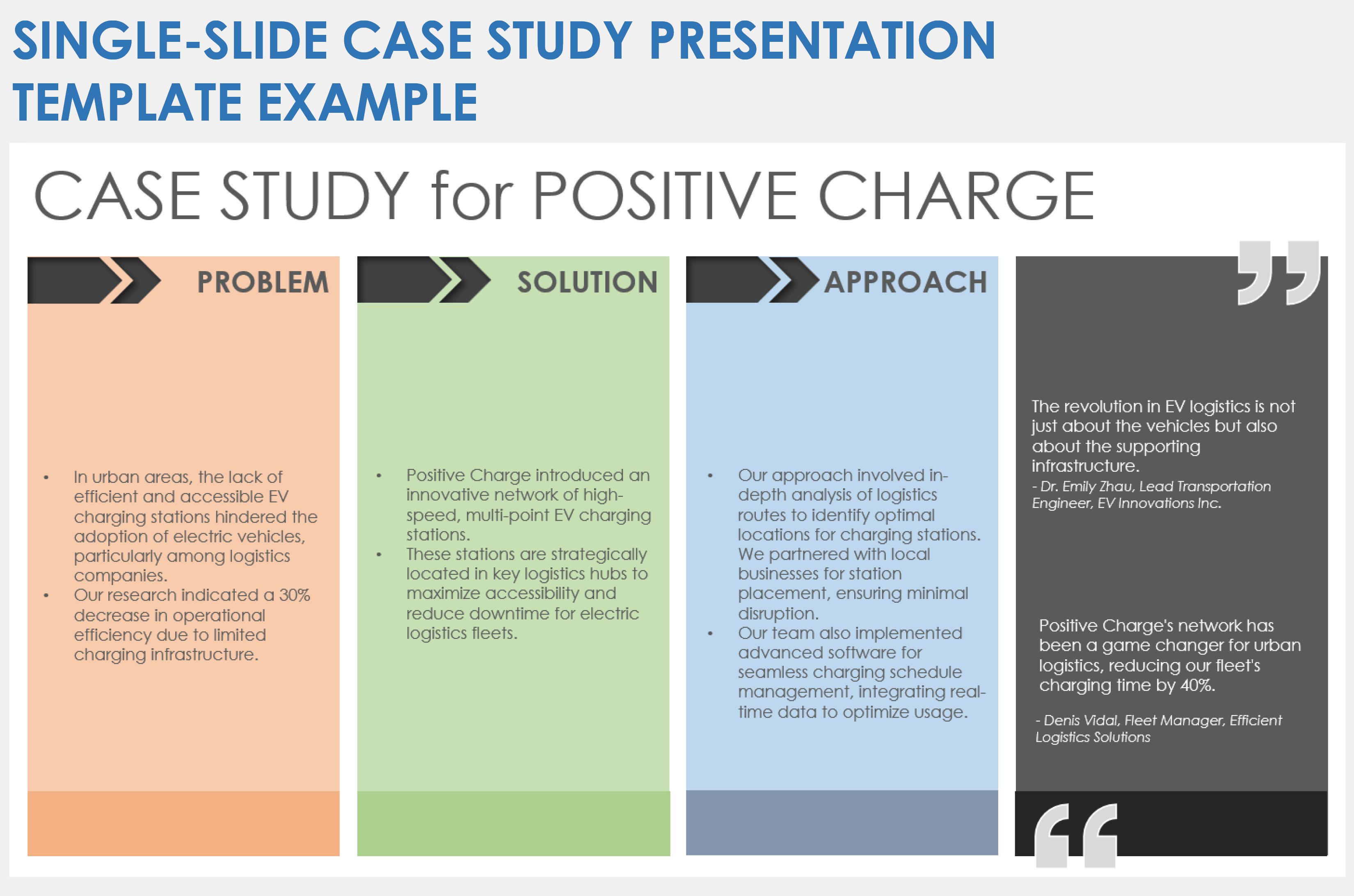
Download a Sample Single-Slide Case Study Presentation Template for PowerPoint | Google Slides
Download a Blank Single-Slide Case Study Presentation Template for PowerPoint | Google Slides
When to Use This Template: Ideal for sales representatives and quick-paced meetings, use this single-slide case study presentation template to deliver a concise yet impactful presentation.
Notable Template Features: The standout feature of this template is its ability to condense the entire case study into one slide. If you want some guidance on formatting, download the template with sample copy. This template differs from more elaborate versions by focusing on essential elements such as the problem, solution, and results.
Case Study Report Template
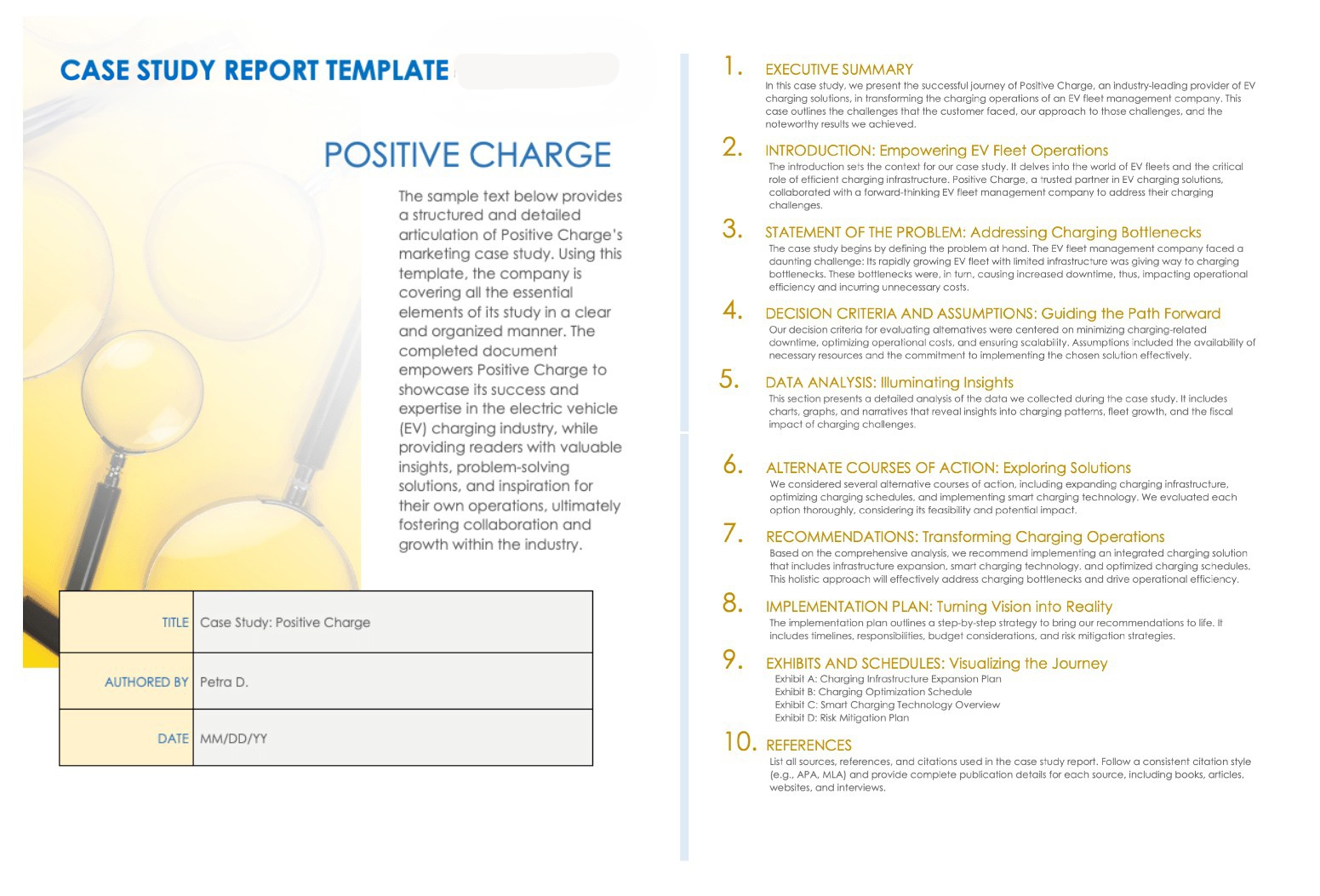
Download a Sample Case Study Report Template for Microsoft Word | Google Docs
Download a Blank Case Study Report Template for Microsoft Word | Google Docs
When to Use This Template: Choose this case study report template when you need to create an in-depth, detailed analysis of a marketing case. It's especially useful for marketing managers and product managers who need to delve into extensive data analysis and provide a thorough overview of their findings.
Notable Template Features: The defining feature of this template — available with or without sample copy — is its detailed and comprehensive structure, which sets it apart from simpler formats. It facilitates an examination of complex cases, providing ample space for data presentation, detailed analyses, and in-depth discussions. This template is ideal for producing clear, professional, and exhaustive reports that cover every aspect of the case study in depth.
Data-Driven Case Study Template
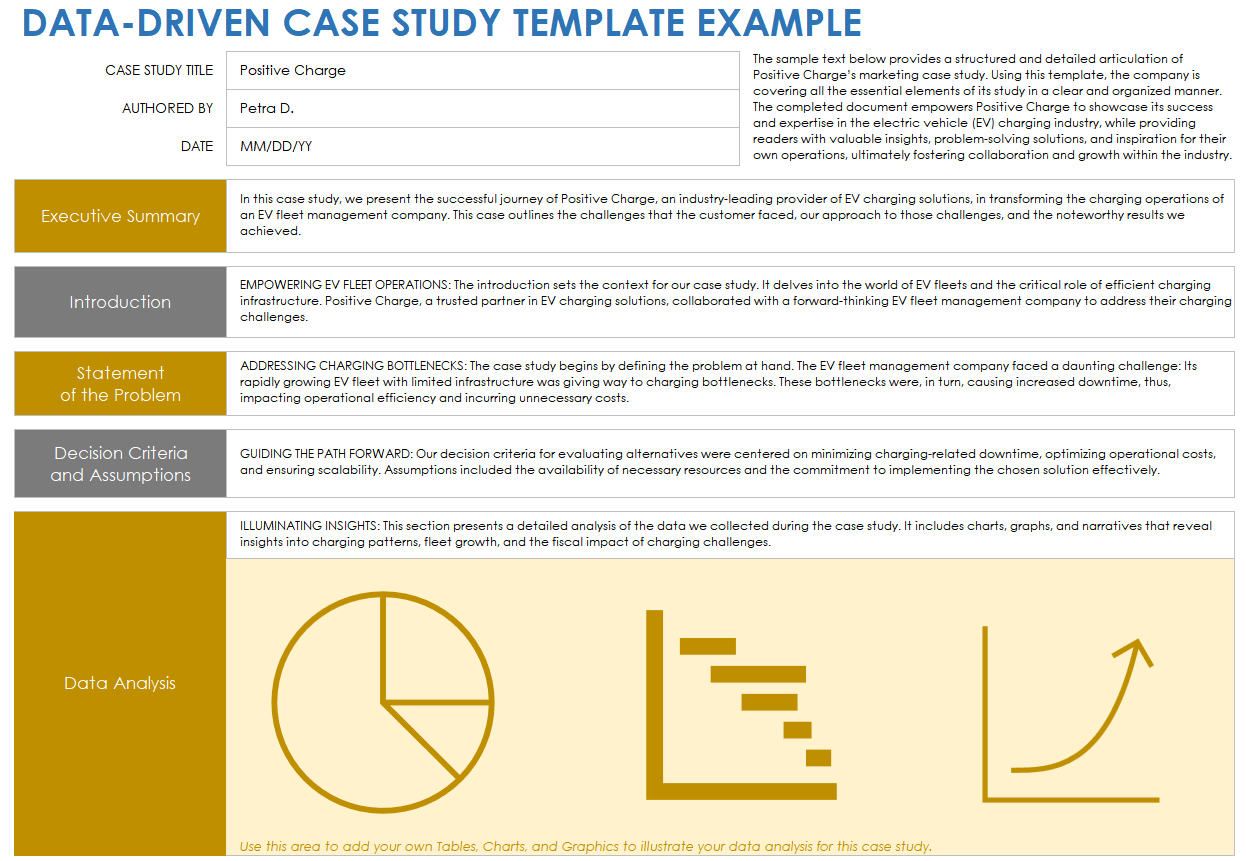
Download a Sample Data-Driven Case Study Template for Excel | Microsoft Word | Google Docs
Download a Blank Data-Driven Case Study Template for Excel | Microsoft Word | Google Docs
When to Use This Template: Utilize the data-driven case study template — available with or without example copy — to showcase the measurable outcomes and analytics of a case study. The template is ideal for marketers and analysts who want to emphasize the quantitative results and data-backed aspects of their strategies and campaigns.
Notable Template Features: This template emphasizes data visualization and metrics. It incorporates graphs, charts, and tables to present for a clear and detailed presentation of statistical information. Its strength lies in transforming complex data sets into understandable, visually engaging formats.
Marketing Case Study Template
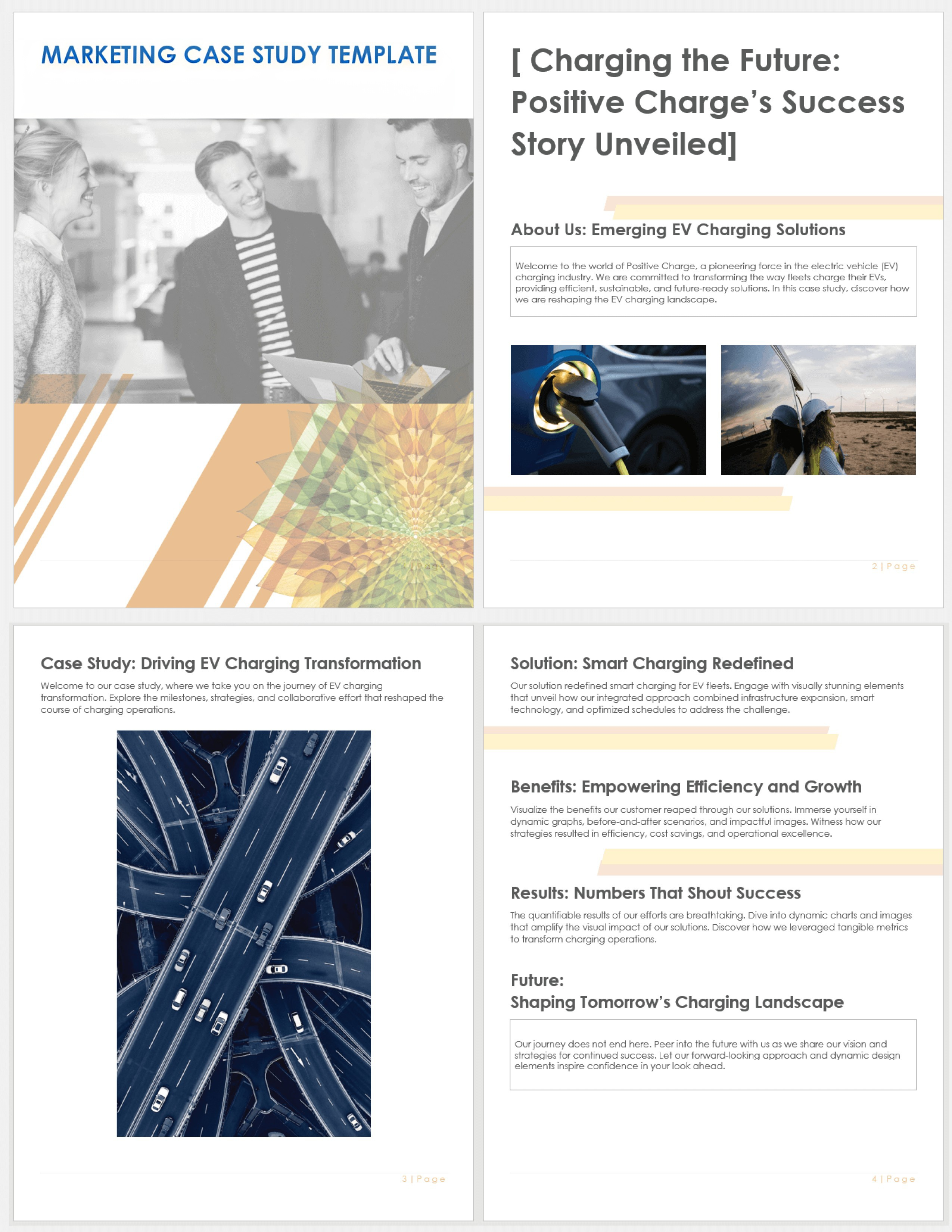
Download a Sample Marketing Case Study Template for Microsoft Word | Google Docs
Download a Blank Marketing Case Study Template for Microsoft Word | Google Docs
When to Use This Template: Turn to this marketing case study template to showcase marketing strategies, campaigns, and their outcomes. It’s particularly well suited for marketing managers, sales representatives, and content creators who aim to clearly illustrate the impact and success of their marketing efforts.
Notable Template Features: What sets this template apart is its focus on the storytelling aspects of marketing. Download the version with sample data to see how to structure the section on your company details, the challenge, and the solution.
One-Page Case Study Template
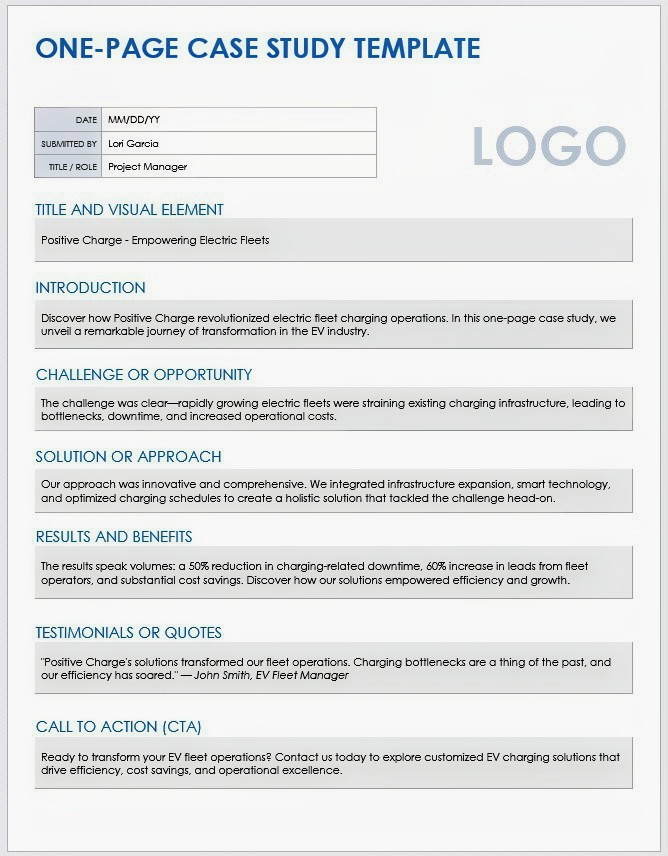
Download a Sample One-Page Case Study Template for Microsoft Word | Google Docs
Download a Blank One-Page Case Study Template for Microsoft Word | Google Docs
When to Use This Template: Choose this one-page case study template to deliver a powerful message quickly and succinctly. The template is ideal for sales representatives and marketing managers who need to present a compelling, brief summary of a case study when time is limited and the impact is crucial, such as in sales pitches or high-stakes meetings.
Notable Template Features: The hallmark of this template is its streamlined, one-page format, which sets it apart from more extensive options. Download the version with example text to see how it distills the case study into key highlights and results, presented in an easy-to-digest format.
Check out this article featuring free Google Docs case study templates for more options.
Problem-Solution-Impact Case Study Template
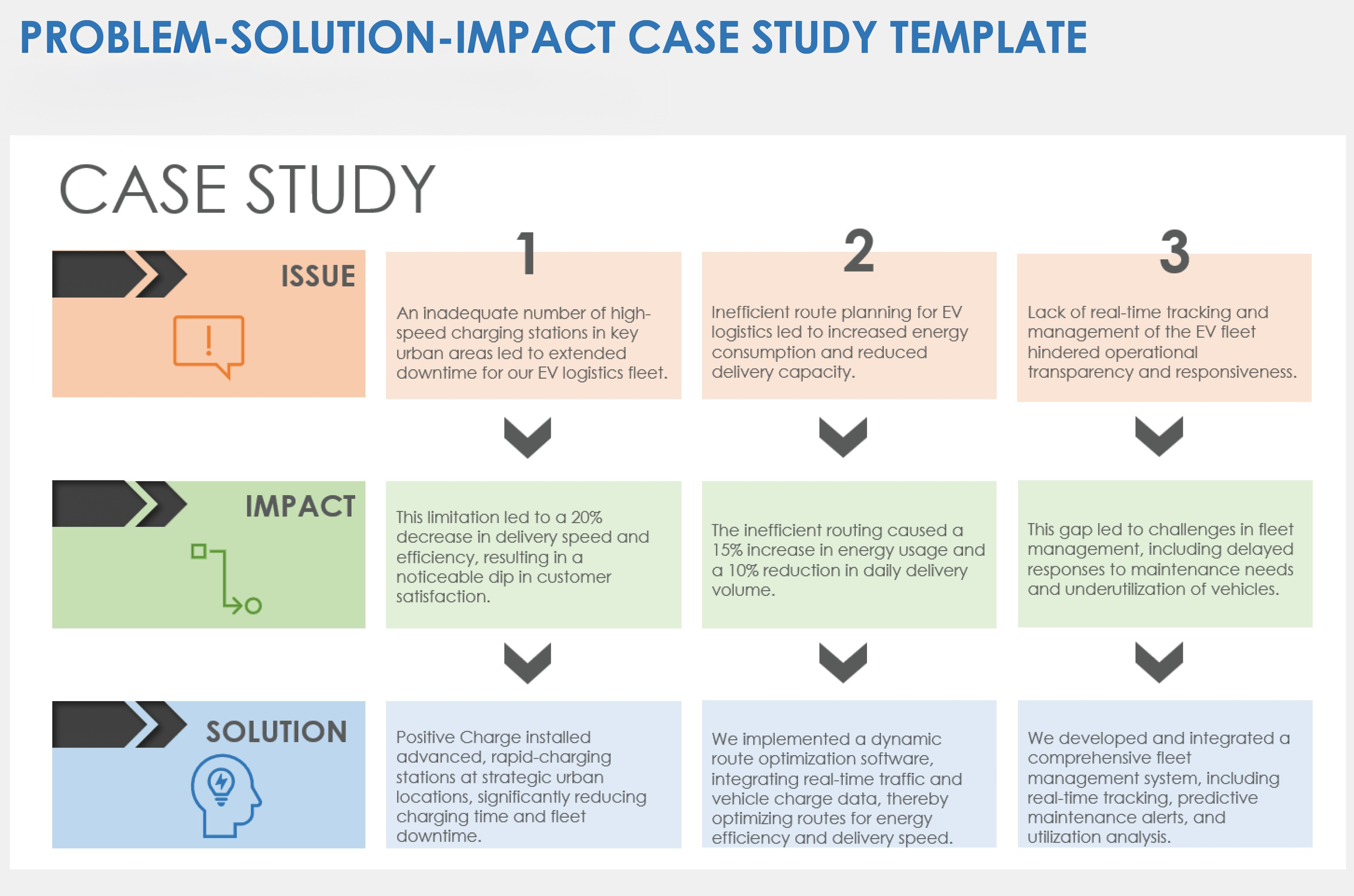
Download a Sample Problem-Solution-Impact Case Study Template for Microsoft Word | PowerPoint | Google Docs
Download a Blank Problem-Solution-Impact Case Study Template for Microsoft Word | PowerPoint | Google Docs
When to Use This Template: This problem-solution-impact case study template is effective for projects where you need to delineate a specific problem, outline the applied solutions, and discuss the subsequent effects. Download the version with sample text to see how to use the template to craft a case study with a logical flow and clear outcome.
Notable Template Features: This template's distinctive feature is its structured approach, dividing the case study into Problem, Solution, and Impact sections. Unlike templates that might blend these elements together, this one provides a distinct, sequential framework.
In-Depth Analysis Case Study Template
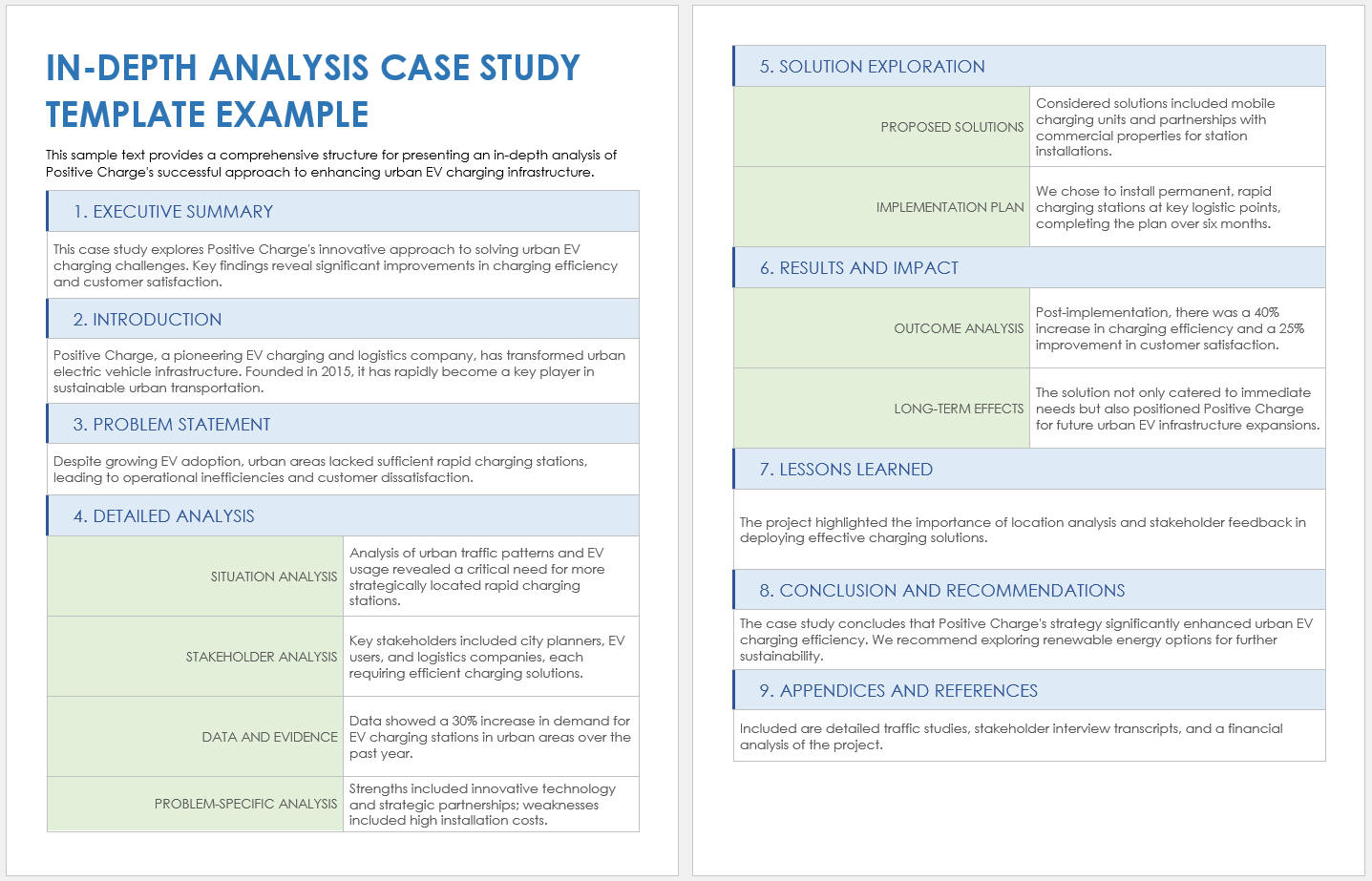
Download a Sample In-Depth Analysis Case Study Template for Microsoft Word | Adobe PDF | Google Docs
Download an Blank In-Depth Analysis Case Study Template for Microsoft Word | Adobe PDF | Google Docs
When to Use This Template: Deploy this in-depth analysis case study template and delve into a complex case study. It's perfect for situations where a thorough understanding and comprehensive analysis of all aspects of the case are needed, such as in research-heavy projects, detailed marketing strategy reviews, or complex product development scenarios.
Notable Template Features: This template — available with or without sample data — has an expansive and detailed structure. Use the In-Depth Analysis section to thoroughly explore the various facets of the case, including situation analysis, stakeholder analysis, and a deep dive into relevant data and evidence. Unlike simpler templates, this one offers a platform for comprehensive dissection and examination of intricate case studies, providing space for a detailed problem-specific analysis (such as SWOT or PESTLE).
Testimonial-Based Case Study Template
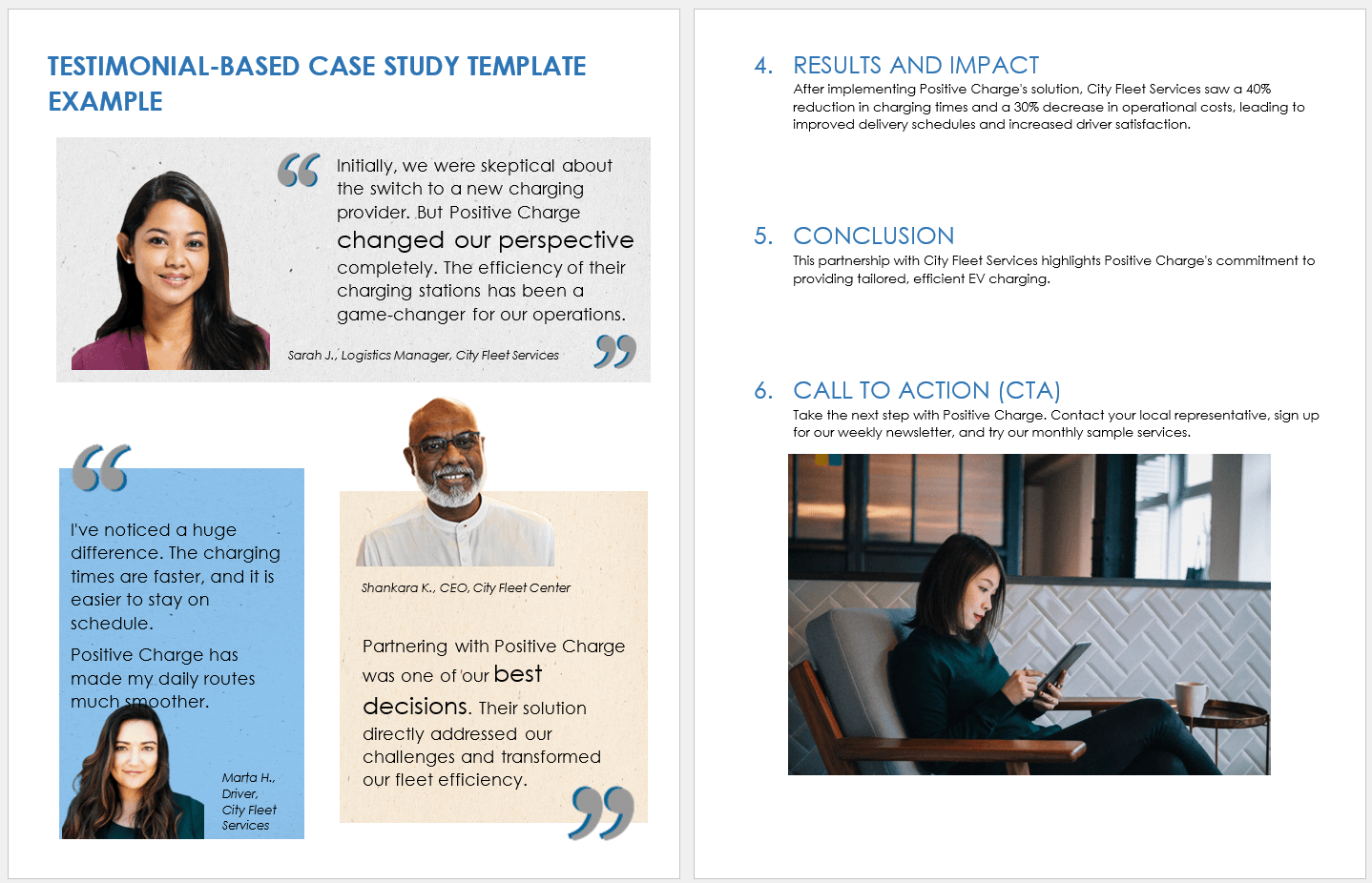
Download a Sample Testimonial-Based Case Study Template for Microsoft Word | Adobe PDF | Google Docs
Download a Blank Testimonial-Based Case Study Template for Microsoft Word | Adobe PDF | Google Docs
When to Use This Template: Utilize this testimonial-based case study template to emphasize the real-world impact and customer satisfaction of your service or product, especially in scenarios where customer experiences and endorsements are crucial. This template is ideal when you have strong, positive feedback from clients that can illustrate the benefits of your offerings.
Notable Template Features: This template focuses on customer testimonials. Unlike other case study formats, this one dedicates a significant portion to showcasing direct quotes and stories from clients. The sample-text version includes real-life examples and endorsements, demonstrating the practical benefits and satisfaction of your clients.
Key Elements in a Case Study Template
The key elements in a case study template include a clear title, executive summary, background information, and problem statement. They also cover objectives, solutions, results, and lessons learned to help you create a complete, engaging story of a project's success.
The following elements help to structure a case study:
- Title: Add a concise and informative title that captures the essence of the case study.
- Executive Summary: Provide a brief overview of the case study, summarizing the problem, solution, and results.
- Background Information: Include detailed context about the company, situation, or environment relevant to the case study.
- Problem Statement: Clearly define the challenge or issue addressed.
- Objectives: Outline what the case study aims to achieve or resolve.
- Methodology or Approach: Describe the methods or strategies used to address the problem.
- Solution: Detail the specific actions taken or solutions implemented to solve the problem.
- Results: Provide quantifiable outcomes and data showing the impact of the solution.
- Analysis: Write a critical examination of the solution's effectiveness and the achieved results.
- Visuals (Charts, Graphs, Images): These visuals should help viewers understand complex data and break up text-heavy content.
- Testimonials/Quotes: Add credibility with direct quotes from clients, customers, or team members involved.
- Challenges and Limitations: Discuss any obstacles faced during the project and how they were overcome.
- Lessons Learned: Include any insights or knowledge gained from the experience.
- Conclusion: Summarize the main points, and restate the significance of the case study.
- Call to Action (CTA): Add content to encourage the audience to take a specific action, such as contacting the company or learning more about a service.
Types of Case Study Templates
Case study templates include single-slide overviews for quick summaries, in-depth analysis for detailed exploration, and customer testimonial templates that track the user's experience. Others focus on comparing strategies, showcasing data-driven results, and more.
Here’s a list of case study templates:
- Single-Slide Overview Case Study Template: Ideal for quick summaries, this template condenses the entire case study onto one slide, highlighting the problem, solution, and results.
- In-Depth Analysis Case Study Template: Designed for detailed exploration, this template type has sections for background, market analysis, strategy implementation, and results.
- Problem-Solution-Results Case Study Template: Structured around identifying a challenge, detailing the solution, and showcasing the outcomes, use this template when you want to take a narrative approach.
- Data-Driven Case Study Template: Use this template to emphasize quantitative results and include charts and graphs to illustrate key metrics and successes.
- Testimonial-Based Case Study Template: This option uses customer reviews and testimonials to highlight real-world applications and satisfaction.
Streamline and Collect All the Elements Needed for a Case Study with Smartsheet
Empower your people to go above and beyond with a flexible platform designed to match the needs of your team — and adapt as those needs change.
The Smartsheet platform makes it easy to plan, capture, manage, and report on work from anywhere, helping your team be more effective and get more done. Report on key metrics and get real-time visibility into work as it happens with roll-up reports, dashboards, and automated workflows built to keep your team connected and informed.
When teams have clarity into the work getting done, there’s no telling how much more they can accomplish in the same amount of time. Try Smartsheet for free, today.
Discover why over 90% of Fortune 100 companies trust Smartsheet to get work done.
How to write effective case studies for your software product

Case studies are one of the best ways to communicate product value to potential customers.
A well-done case study:
- Creates trust (recommendations from third parties are always more reliable than what the company itself claims)
- Provides social proof —in a situation where a potential customer isn’t sure what to do, they assume that others around them have more knowledge
- Gives more information about the product—you can’t fit everything onto your features page
- Creates a sense of “I can relate to this”, if the case study is for a company in the same space
- Allows you to target your marketing better towards much narrower customer groups, meaning a much more personalized experience
However, good case studies take time and commitment. You can’t just put together a case study based on any customer, in any format, and at any time.
Here are some tips for effective case studies that you can use for targeting, marketing communications, customer success, search optimization, and more.
Create niche studies for separate target groups
Even if your business has one specific main target group, it still probably has different verticals of customers under it. At the very least, you definitely have various strong use cases for your product.
For example—if your main target group is SMBs, you still have:
- SMBs that do retail
- SMBs that do online sales
- SMBs that do software
…and so on.
The effectiveness of case studies comes largely from the relatability aspect of them.
Imagine doing research for a software solution you need. If you immediately see a case study for another company with a use case nearly identical to yours, you will:
- Get a lot of extra information without having to reach out to the company
- Be immediately assured that the product is suitable for your specific use case
And, on the flip side, if you’re doing research and the available case studies are wildly different from what you need, it might be a red flag for you.
This means that the most effective case studies are the ones that are the most heavily tailored for your most desired target group(s).
There’s no point in doing a case study for edge case customers who you aren’t actively pursuing.
Try to figure out all the different main use cases that exist within your ideal customer target group, and build case studies for all (or most) of them.
This way, you can build the most in-depth rapport with your ideal customers. It’s great ammo for effective success/sales processes, and saves you time on tailoring communication on the spot.
Choose your case study candidates wisely
Besides making sure you have a good range of different case studies, it’s also important to be picky about who the selected ones are.
You obviously value all of your customers. However, some of them are definitely more useful than others when it comes to communicating your value.
After you have picked the target groups you’d like case studies for, make sure you pick customers who:
- Use the product often and have used it recently. This guarantees that they’re up to date with any new features you have, the current design, recent changes, etc. Having an outdated opinion isn’t very useful.
- Have seen solid results from using your product. Oftentimes, the customers who have been most impressed with your product will let you know about it by reaching out. Make a list of these people as soon as you communicate with them, for easy reaching out later.
- Are truly enthusiastic about your product—again, these people usually reach out and express their joy.
- Are at least relatively well-known in their space (if possible).
Whereas most users are efficient at being your customers, they might not be efficient at communicating your product value to the outside world.
Pick and choose the people who are most qualified, excited, able, and constructive, and you’ll be able to create the most informative and valuable case studies.
Focus on value first
Case studies communicate nothing if the only message is “yes, this product is “good””.
It’s important that your case studies focus on the value your product has offered a customer—and therefore can offer to others, too.
For example, Canny’s case studies consist of three parts—challenge, solution, and results.
Here’s what that looks like in the case study for ReadMe , one of our customers:
The challenge describes what the company was struggling with before they chose Canny.

The solution explains how Canny solved the issue they were having before.
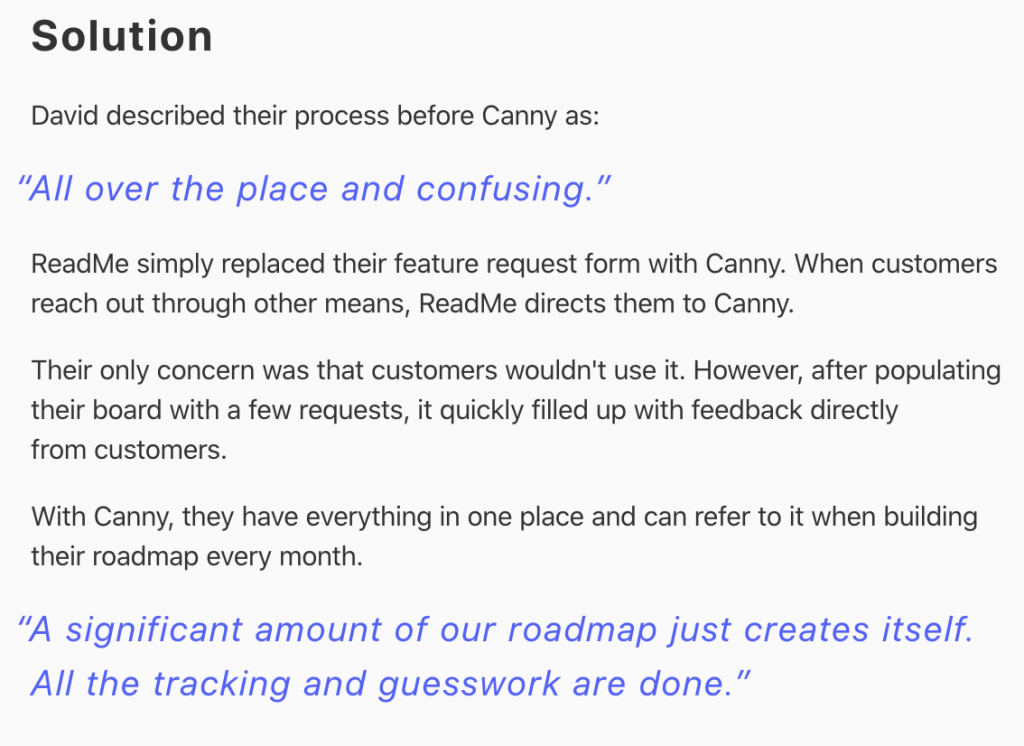
The results highlight the real value the customer has seen from using Canny.
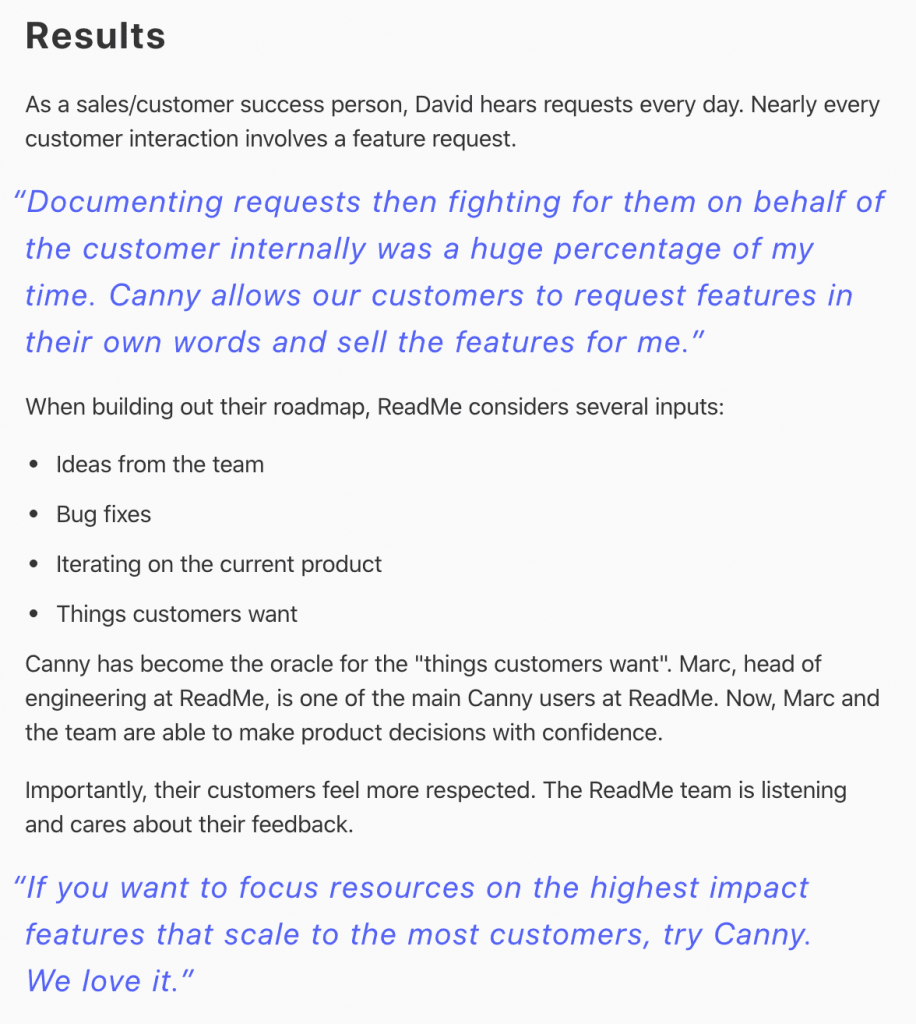
The most important thing here is, again, focusing on value. Value is what customers are signing up for and handing their money over to you for.
The more you can emphasize that in your case studies, the better. Ideally, you would be able to show clear ROI with actual numbers—e.g “increased conversions by x”.
It’s a simple principle of social proof—“If another company like mine is getting value from this product, so can I”.
Pay attention to formatting and design
Case studies are an excellent source of information, but they need to be easy to digest.
With the abundance of information already available for any product out there, nobody has time to read through pages of text walls in addition.
Try to format your studies in an easy-to-consume way:
- As with any piece of content, use headings and bulleted lists to break up text
- The three-step solution we mentioned above is a good start for sectioning your proof
- Use as many easy-to-understand visuals as possible
A few additional tips
Since case studies are mostly meant for creating a feeling of recognition, add the company’s “profile” in an easy to spot place.
This way, people browsing the studies will know if they’re in a similar position as the highlighted company, even if they haven’t heard of it before.

Make the most important things stand out for quick browsing. If someone is just glancing over the page, they’ll be drawn to the highlights of the case study.
This includes strong statements, direct quotes that make a point, and any other value “evidence” one-liners straight from the customer.
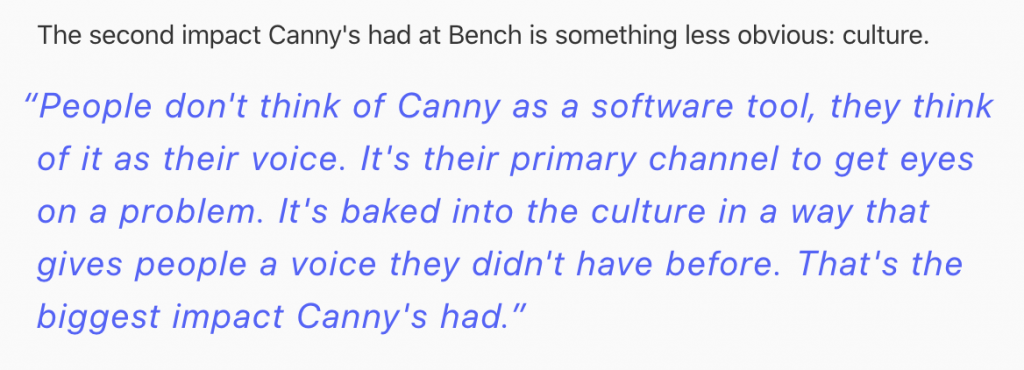
Add plenty of CTA’s—your case study pages should still be built for conversion.
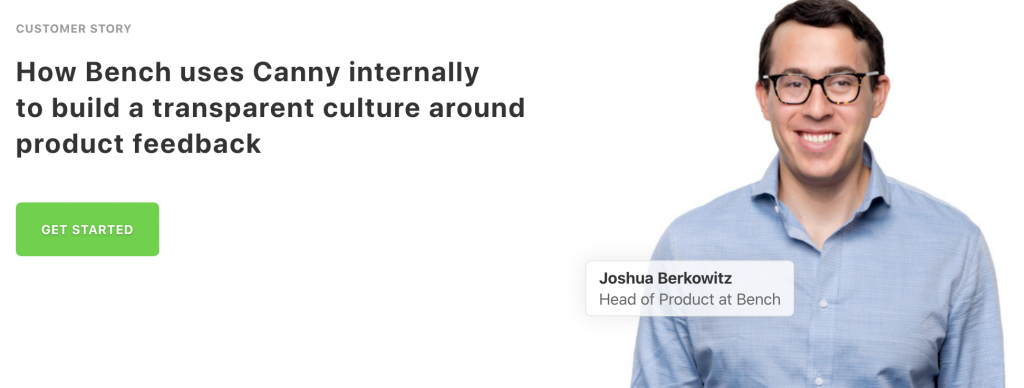
Give your potential customers easy access to start a trial or use the product if they decide to.
Spend some time and effort on creating impactful case studies
As much as you would like to get some social proof out there ASAP, waiting a little and putting effort into case studies is worth it.
Mediocre studies on not-so-ideal customers aren’t going to be detailed or useful enough, nor provide the proof of value you’re looking for.
Focus on planning for and discussing your target audiences, providing a variety of cases, and optimizing design and copy.
You’ll have proof of value out there for everyone to see, and save some time for yourself and your potential customers.

Elen Veenpere
Marketer at Canny. Elen enjoys drinking unnecessary amounts of coffee, typing words, and filling out marketing spreadsheets.

Related Posts
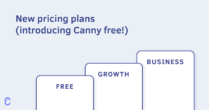
Awesome post! Keep up the great work! 🙂
Thanks for the heads up on the benefit of product case studies.
Last Updated on May 14, 2023
- Portfolio Tips
- Career Tips
- Portfolio Examples
- Get UXfolio!
The Ultimate UX Case Study Template

Having a template to follow is the biggest help in UX case study writing. Even more so, if you’re a junior who doesn’t have much experience with portfolios. A template can help you plan, organize your thoughts while showing you the light at the end of the tunnel.
The UXfolio team reads hundreds of case studies every month. What we’ve found is that successful UX case studies have a similar structure. In this article, we’ve distilled this formula into a flexible UX case study template and some practical tips that you can use to polish your case studies!
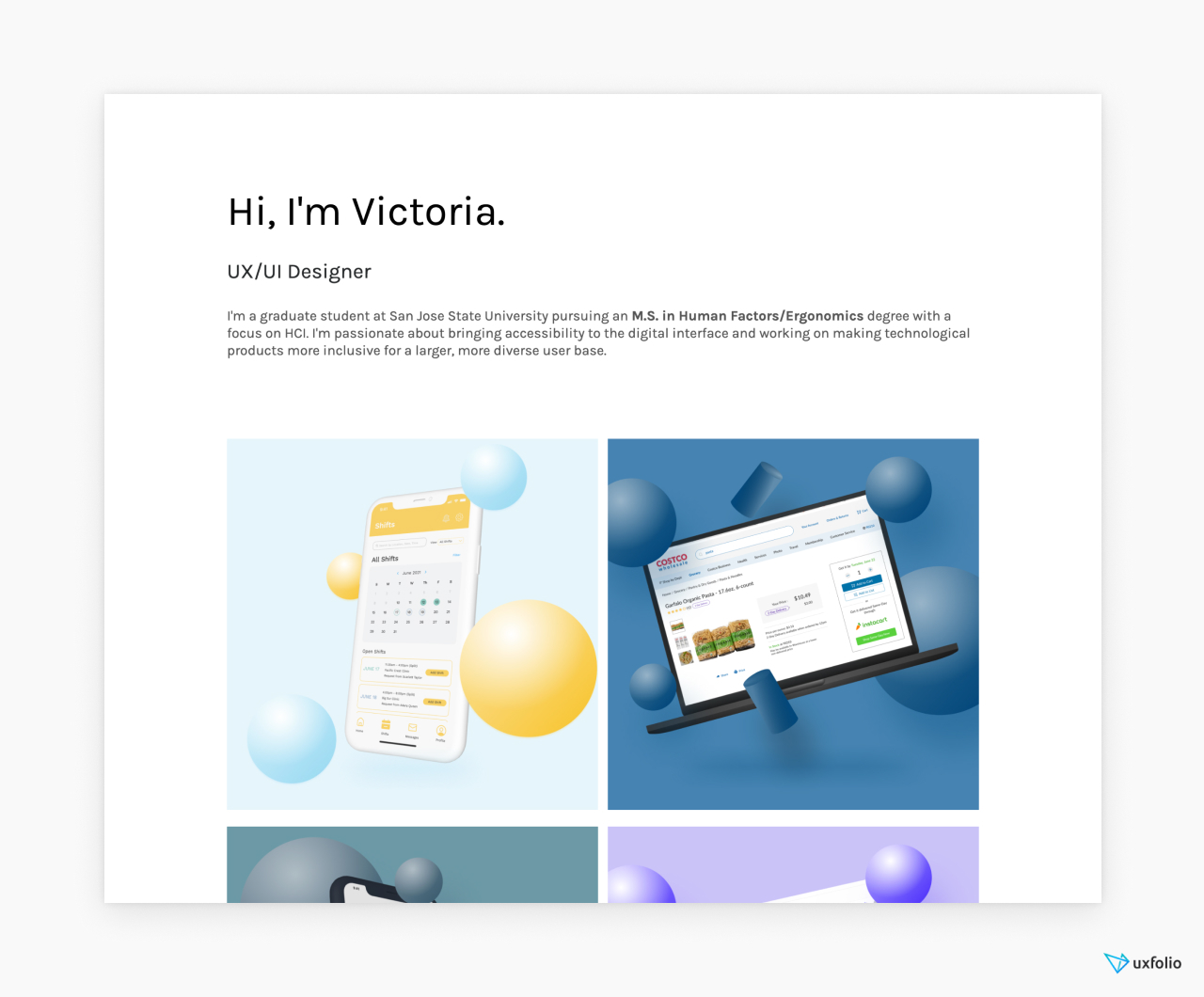
About UX case studies in general:
Before you get to work, we need to clarify a few important details. Doing so will help you understand the expectations and the purpose of UX case studies:
What are UX case studies?
UX case studies are a form of professional content that mixes text and visuals to present the design process of products or product features. They make up UX portfolios, alongside optional pages such as ‘About Me’ or ‘Contact’.
How are they different from UX portfolios?
UX portfolios are made of UX case studies. Think of your portfolio as a folder that holds together your case studies. Back in the day, these used to be printed, book-like documents. Nowadays the industry prefers websites and other digital formats .
How are they different from resumés?
Your resumé lists your skills and work experience. Meanwhile, your portfolio uses case studies to showcase how you apply those skills and experience . Ultimately, you’ll need both to land a job.
How many case studies should be in a portfolio?
If you’re a junior UX designer , you should include 2-3 case studies in your portfolio. These could describe UX bootcamp assignments, re-design concepts, UX challenges , internship projects , or even fictional products. If you’re a medior or senior UX designer, write up 4-5 of your most impressive projects into case studies. Your goal should be to feature as many of your skills as possible. And remember: quality over quantity.
What to feature in your UX case studies?
Since your career depends on your UX portfolio, there’s a lot of pressure that comes with putting one together. Usually, it’s this pressure that numbs designers and leads to procrastination. But just setting straight what lays ahead will help ease your mind:
The story of your design
Design decisions, visuals with explanations.
This might sound very esoteric, but it’s really not. For every design, there was at least one problem that required a solution. You were the person who explored the problem and found the solution/solutions. There might have been moments when the whole thing went off-rails, or when you needed to go back to the drawing board. Those are all part of your design story.
Now, imagine that a friend, peer, or colleague asks you about a project. How would you talk about it? That’s almost exactly what you should put in your case studies. Just polish it a bit, leave out the curse words, add visuals and you have a case study.
Throughout the design process, you keep making decisions. Choosing a UX method to apply is a decision too, and there’s a reason why you chose it. Your UX case studies need to highlight these decisions and their contribution to the design.
The biggest mistake in UX case studie s is when UXers go on defining instead of explaining:
- Definition ➡️ “I proceeded to do an in-depth competitive analysis to find out more about competing apps in the same category.”
- Explanation ➡️ “I proceeded to do an in-depth competitive analysis to make a list of features that were missing from our products, check out how others solved the XY flow, and find out how could we improve on it in our solution.”
Then you’ll move on to explain what you’ve found and as your case study progresses, you reference those findings.
You need to be heavy-handed with your visuals when you’re creating UX case studies. Using images alongside your text will help your readers’ comprehension. So, as a first step, collect everything you can: photos, sketches, whiteboard grabs, graphs, personas, screenshots, wireframes, user flows, prototypes, mood boards, notes, and so on.
We’ve seen some creative UXers use screenshots of calls (with blurred-out faces), group photos, and prototypes of all fidelity. Such visuals help us understand what we’re reading about. But they also build an image in our heads of the designer behind the screen, which can be very powerful and memorable.
Some designers are already in the habit of keeping every scrap of paper with a scribble on it because they know that when it comes to writing a case study, you can’t have enough visuals. Follow their example to make your easier – your future self will thank you.
But it’s not enough to just throw some images into a case study. Here’s how you can make them impactful:
- Always give context ➡️ if you put that stunning photo of the wall with post-its into your case study, make sure that you place it in a section where you explain what’s happening on it (see design decisions) or give it a caption that explains it. The important thing is that visuals will only work if they are strategically placed or they come with an explanation.
- Strive for visual consistency ➡️ even if it requires some extra work, you should make sure that your visuals match each other. Yes, a persona and the user flow might not be close to each other on your layout, but they’re still in the same document so they need to have consistent styling. Believe me, this is a common criticism from design leads and HR folk as well.

How long should be a case study?
If you check a site like Behance, you’ll find that most UX projects there are rather short. Usually, they focus on the visual aspects of design, aka UI. That is a fantastic starting point for a case study. But for UX design, you will need to add some content for context.
The good news is that you don’t need to write essays for case studies. All it takes is around 500 words and some well-optimized visuals. You should never stretch your words because it’ll reflect poorly on your presentation skills.
Also, treat this number with flexibility: If the project at hand justifies it, feel free to go above or below that. Usually, when a case study is very long, it’s because the project itself was more complicated.
What’s the point of UX case studies?
1. applied designer skills.
It’s one thing to learn a skill and it’s another to use it in a way that can help drive numbers for a business. A great UX case study will prove that you are capable of applying your skills and delivering a solution even with all the distractions and obstacles that come with real-life scenarios.
2. Presentation skills
Many UXers forget about the skills that are required beyond UX. Just read a few UX designer job descriptions , and you’ll find that advocating for design best practices is one of the most common requirements.
As a designer, you’ll have many stakeholder meetings and you’ll need to present your or your team’s ideas. And the fate of those ideas might depend on the way they’re presented. Therefore, the way you articulate your thoughts is important. A great UX case study will show that you are great at structuring your thoughts and articulating complex concepts.
3. The impact of your design
You can see in our UX case study template that there’s a separate section for showcasing your impact. If you can prove that your design can drive numbers, you’re set. This is the single most powerful tool that you can use in a case study: before-and-after analytics, such as an increase in checkouts, increase in finished flows, better CTRs, user feedback, etc. Use whatever number you have to show that your design contributed to the business. It’ll convince even the UX-doubters.
Obviously, as an aspiring/junior designer , this might be impossible, so you need to be a bit more creative. We advise you to show what impact the project had on you: what you’ve learned and how you’ve improved as a designer.
4. Navigating in a team
Almost every product is a collaborative effort between professionals from various disciplines: researchers, designers, developers, marketers, etc. Therefore, navigating in a collaborative environment is an important trait. A case study should show how the team influenced the design, how you’ve collaborated with other designers, the sacrifices that had to be made, and so on.
You don’t need an elaborate plan for this. First and foremost, make sure that you introduce the team in your case study. Second, ask for quotes/recommendations and include them in a neat quotes section. Yes, tooting your own horn can be a bit uncomfortable, but unfortunately, it’s part of the game.
5. Showcase of your taste
Yes, it’s UX, but the reality is that most people don’t care: if what you present doesn’t appeal to them, it’s unlikely that you’ll get the job. Make sure that your UX case studies are visually consistent. If you want to cast a wider net, strive for sleek, minimalist solutions and harmonizing colors.

A simple yet effective UX case study template
This is a tried-and-true UX case study template that can provide a structure to your thoughts. There are 6 chapters that are standard for almost any UX case study. However, the content of these chapters is highly dependent on the project you’re writing about. But don’t worry, this doesn’t mean that we’ll leave you on your own: for each chapter, we’ll give you various options and ideas to help you get going.
UX case study template/skeleton:
- Hero section
- Project overview
- Exploration/Discovery
- UX design process
- Final design
1. Hero section
All case studies should begin with a title & subtitle. You can use various formulas for your title, but we’ve found that this is the one that works the best:
- App name + project scope + project/case study = Netflix Checkout Redesign Project
Your subtitle can provide a glimpse into the project, for which you have various options:
- What’s the product about? (An app that helps you keep your plants alive.)
- What was the project about? (6-week UX design and research project)
If you want to include something visual in your hero section go hard or go home: use spoilers, aka show screens of the final design. You don’t have to fit everything there, just the parts you’re most proud of as an appetizer. Later in the case study, you’ll have enough space to showcase everything you’ve worked on.
- 2 sentences (titles), and
- 1 optional cover image.
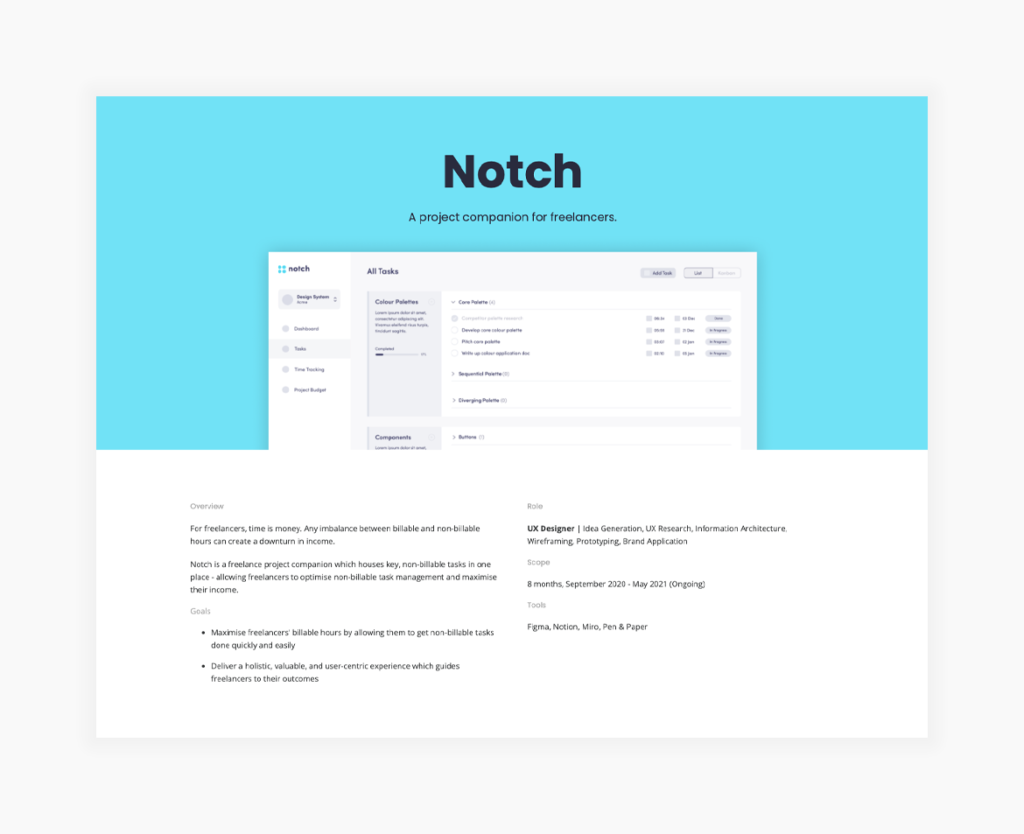
2. Project overview
Make sure that your readers are prepared for what’s to come. Remember: they know nothing about this project, so you need to cover the bases:
- Product description,
- Team members,
- Project length,
- Methods used, and
- 3-4 sentences for the overview, and
- 4-5 bulletpoints for the small details.

3. Exploration/discovery
Now that we have all the background information, we can move on to how you’ve approached the issue you were presented with. This part usually includes:
- Competitive analysis,
- Interviews, and
Make sure that for everything you mention you answer at least these three questions:
- Why did you choose to do it?
- What did you find out?
- How did that influence your next move?
You can end this chapter with a wrap-up to create a smooth transition to the next chapter.
- At least 3-4 sentences for each method you’ve used,
- Visualize as much information as you can.

4. UX design process
Now that we understand the scope of the project, we’re eager to see how you went on to design a solution. You can achieve a great structure here if you start from more abstract ideas and move towards the final design:
- Wireframes,
- Prototypes,
- Iteration, and
- Validation.
Again, you need to answer a few questions for every step you made:
- What did you want to achieve by doing this?
- How did this step contribute to the final design?
- At least 3-5 sentences for every method you mention.
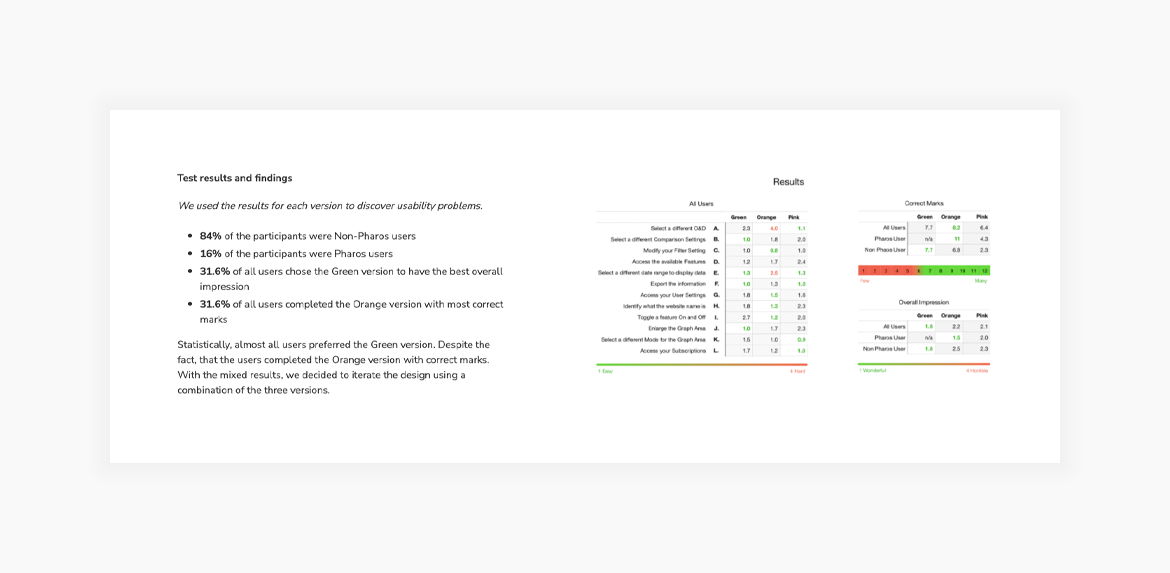
5. Final design
Probably the most exciting part of every UX case study is the reveal of the final design. In this section, you should explain
- Why did you choose this solution?
- What other solutions were in the run?
- Before-and-after screenshots (if relevant to the project).
There are two great options to present your final designs. The first is to use galleries. You can go with a nice carousel or a grid that follows a logical order. The second is to embed your Figma prototype. This has the added benefit of making your case study interactive, which makes for a more memorable experience. (Or you can combine the two for an even better showing.)
- 2-3 short paragraphs.
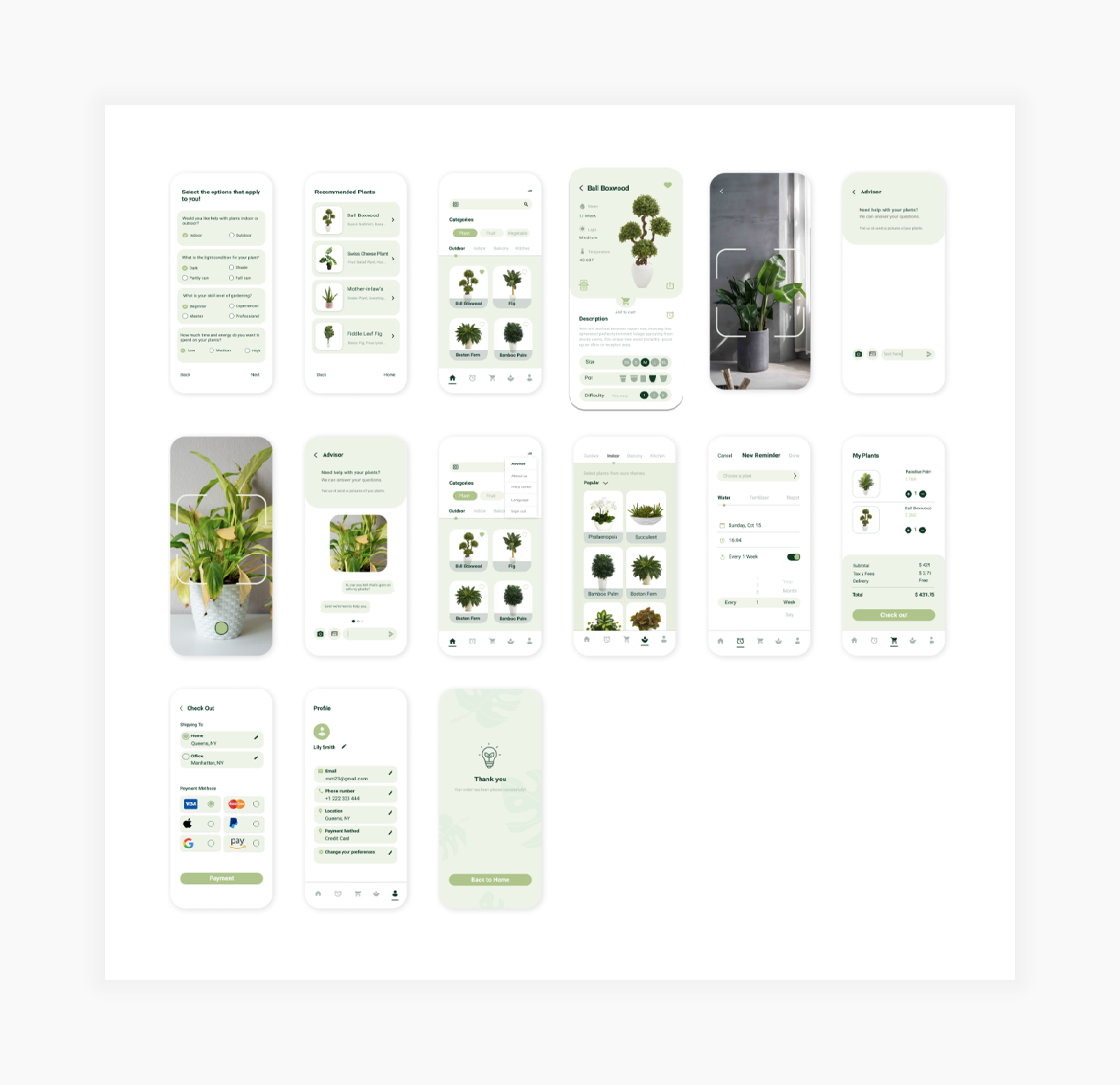
If you have numbers or analytics that show how your design contributed to business goals, you need to showcase them. This will make your case study even more impactful. You don’t need graphs and piecharts (unless you have the time to create some); it’s enough to make a list with the quantifiable data. If you don’t have access to such data , you can also include testimonials and user quotes to underline impact. If you can include both, that’s a winning combination.
- At least 1 sentence for each achievement.
- In a bulleted list or short paragraph.
6. Learnings
There’s something to learn even from the most boring project you’ve ever done. At least, you should strive to find something positive that can contribute to your growth as a designer. This can be a soft skill, a new tool, a new method, or a different way of cooperation. Try to think of things that were new to you in this project and share the takeaways with your readers. Alternative closures include:
- What would I do differently?
- Jobs to be done
- This chapter can be as long as you please, but
- At least 3-4 sentences.
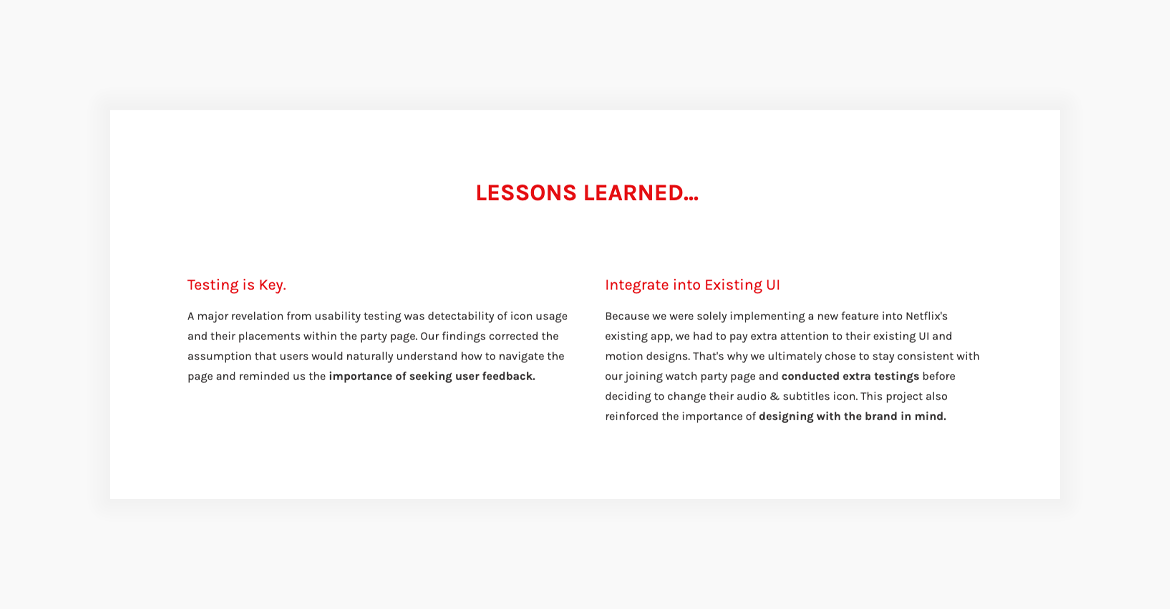
Alternate UX case study templates
We’ve provided a classic UX case study template that has been proven to be working. Now, we’ll show you how you can alter this template for different flows:
UI focused case study template
If you’re strong in UI, you should not wait to reveal your final design until the end of your case study. You needn’t worry about spoiling the surprise as a case study is not a fiction novel or Netflix show. A beautiful design will pull in your readers. What’s more, if the company doesn’t really know the difference between UI and UX, this approach will make your case study even more impactful as it’ll start with the ‘beautiful stuff’.
Here’s how that template would go:
- Project Overview
- Transition to the next section by letting your reader know that you’ll explain how you’ve arrived at this solution.
- Exploration/discovery
- (Optional: Showcase even more of your final designs)
Impact driven case study template
Every product has a business behind it. And what you can do for that business is what matters to stakeholders. We can all conclude that a screen is pretty, but if it doesn’t contribute to business goals or KPIs, it’s just that, a pretty screen. So, if you have some numbers to share, don’t be afraid to put them right after your intro section. Then go on and showcase how you’ve achieved it:
- Share numbers then follow up by showcasing the design which contributed them:
Build your UX case studies with UXfolio!
UXfolio is a portfolio and case study builder made with UX designers in mind. It offers stunning, customizable templates as well as a case study generator with text and image ideas. What’s more, UXfolio comes with built-in device mockups, easy prototype embedding, and password protection on the portfolio or the case study level. Ready to work on your portfolio? Try UXfolio for free!
Case studies
Here are more than 130 projects we accomplished for our clients. Browse to find case studies related to your industry, the required expertise, or services.
Automated testing
Back-end development
Custom software development
Data migration services
Dedicated team
Discovery phase
Legacy application modernization
MVP development
Manual testing
Mobile app development
Penetration testing
Software architecture
Software audit
Software support
Staff augmentation
System integration services
Team extension
UI/UX design
Web app development
Agriculture
Aviation and Aerospace
Computer Games
Computer Software
Entertainment
Financial Services
Human Resource
Marketing and Advertising
Oil and Energy
Project management
Real Estate
Restaurants
Social media
Telecommunications
Artificial intelligence
BI and reporting
Cloud computing
Cloud solutions
Data science
Data warehouse and ETL
Embedded solutions
Penetration testing (grey box)
Robotics process automation (RPA)

Software solutions bringing business values
100% data privacy guarantee
USA (Headquarters)
Faroe Islands
Hey there! This website uses “cookies” to give you best, most relevant experience. Please accept cookies for optimal performance. Read more
Software development case studies
We love to show off examples of web and mobile applications that we’ve developed for our clients. In addition to betting projects (in which we specialize), here you will also find applications from the financial, healthcare, IoT industries and additionally, some solutions for startups. Remember that not all of the software development case studies that we’ve completed are available on this page, some of them are confidential. We encourage you to contact us if you have questions.
All software development case studies
Below you will find all of our case studies. For a better navigation experience, use the filters by dividing them into industries, the scope of work, or the platform. Projects we have carried out in the past are still being developed. We put a lot of work into them and we are very proud of what we do. We’d love to speak with you, so please contact us if you have questions about these projects. If you want to implement your own idea, CrustLab is the partner to help you do it!

CrazyBet – Crypto Casino with Custom Frontend & Social Features
Delve into the genesis of a standalone crypto casino platform infused with immersive gaming aspects and vibrant social interactions.

BETFAN – Sportsbook Web & Mobile UI
Innovative sportsbook UI that transforms betting on web and mobile platforms into an exceptional experience. Delivered for one of the top legal bookmakers in Poland.

Slot Games Aggregator
Industry-acclaimed one-stop software for online casino operators, now expanded with even more attractive gaming options.

White-label Casino Apps for a Global Audience
Uncover the intricacies of cutting-edge custom casino mobile apps. Confronting considerable technical challenges, rigorous timelines, and strict regulatory constraints, we redefined industry standards.

White-label Mobile Sportsbook Apps
The genesis of custom mobile sportsbook apps reshaping the US and Canadian iGaming landscape through customization and cross-state functionality.

STAY STRONG – A Next-level App Elevating Tennis Club Engagement
Discover how Fame Sport Club, a VIP-centric tennis and badminton hub in Krakow, harnessed cutting-edge technology to elevate player experiences and boost profitability.

AI-boosted Flutter mobile app supporting soccer clubs in training young soccer players
Cross-platform Flutter mobile app created for professional soccer clubs. AI-boosted Duolingo for young adepts of soccer and a complete back office for professional coaches.

BetMakers – the next generation online betting platform
Creation of a next generation multi-tenant Horse Racing betting system hosted by one of the biggest players in the betting industry.
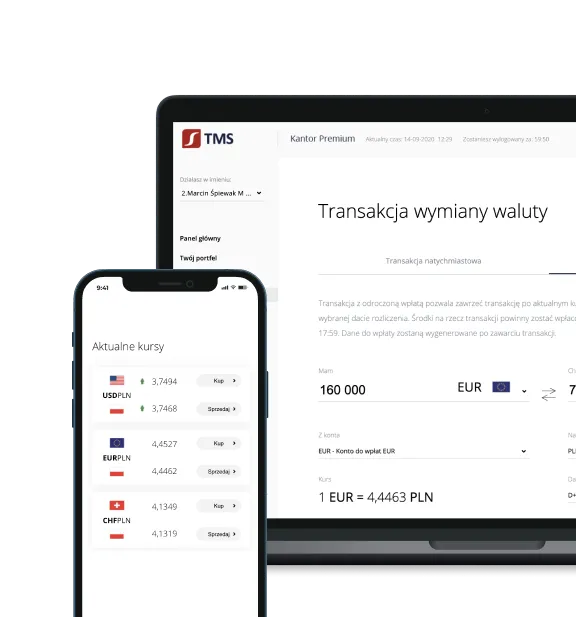
TMS Brokers – Online currency exchange office
Expansion of an online currency exchange office’s functionalities including dedicated panels for users, administrators, and traders.

PelviFly – Healthcare cross-platform mobile app development
Creation of a cross-platform mobile app for end-users and a custom web application for coaches and administrators. The system introduces the gaming experience into a professional medical treatment to start training pelvic floor muscles for women of all ages.

Offender tracking system – an AI-supported IoT application for Public Safety
Development of the personal unit tracking system and native mobile applications to supervise and monitor their activity.
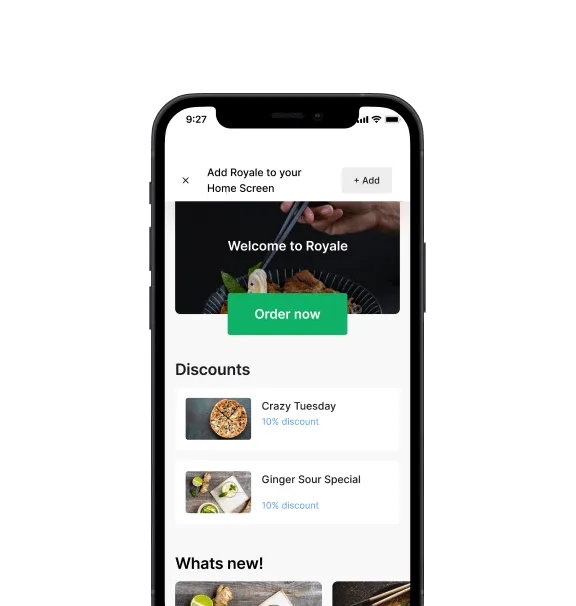
Leeroy – A White-label Restaurant Management App
The transformation of a groundbreaking all-in-one platform designed to streamline restaurant management across Scandinavia.

Case study – fixed pool betting system
Improvements and refreshments to a fixed-pool betting system. Fixed performance bottlenecks, implemented several new technical solutions and custom features, improved the user experience, and added more business conversion points to the web application.

DreamPicks – Online sports betting platform MVP design
Complete design project of the MVP version for an online sports betting platform intended for the US market.

Zowie – a mobile chat widget SDK
Creation of the SDK for a mobile chat widget for Android, iOS, and Flutter.

SoyDigi – business management as a service web app MVP
Creation of the web app MVP version of a business as a service application for a Polish-Columbian startup in the early stages of growth.

Pick24 – social betting mobile apps development
Development of social betting iOS and Android mobile applications for simulated gambling.

WorkInn – Web application and recruitment marketplace for the HoReCa industry
A web application from the event and catering industry that connects event organizers and employees such as cooks, waiters, bartenders, and more.

Smooth Remote – An AWS-based web remote job board
An extended AWS-based web remote job board with an admin panel, Content Management System, and payment integrations.

The Central House of Technology – Content Management System development
Development of a Content Management System to manage the knowledge base and integration with the cdt.pl web portal.

Solver e-learning platform
Creation of an e-learning platform that targets two types of users: providers who offer services and audiences who want to learn.
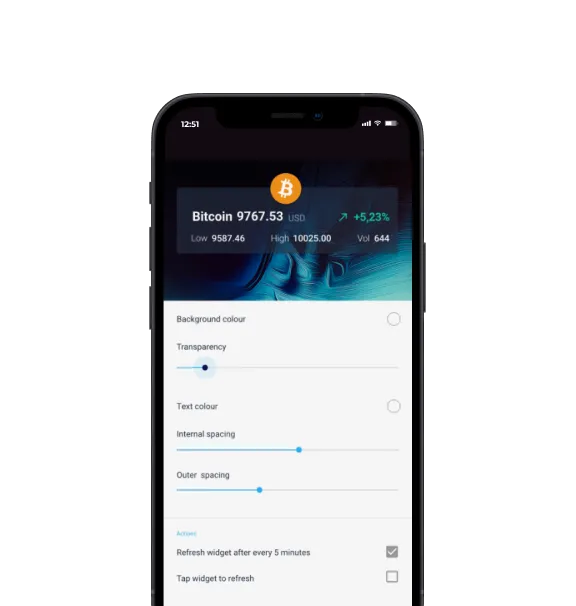
ICEO – Android widget application
Development of Android widget application which allows the user to follow the cryptocurrency rates in real-time.

BLNK – design of iOS mobile application
An iOS mobile application supporting the maintenance of healthy eyesight.

Pretta – A new level of project management
An iOS application designed to optimize project management processes.
Trusted by leading brands
There is no better recommendation than the opinion of a satisfied customer. See what founders and managers have to say about their cooperation with CrustLab.
CrustLab consistently adds value to our organization in many ways. We’ve received very positively feedback on the system CrustLab has delivered. Our customers regard it as an excellent product. Our experience working with them has far exceeded those of other vendors.
The team provided professional services that added value to the core functions of the business. They were fast and felt like our internal IT department, working during the night when we were deploying important features. That was fantastic, and I’m happy they’ve worked with me.

CrustLab’s implementation of our solutions has almost doubled our revenues. All aspects of cooperation were very good. I felt that we were treated as very important clients because we received a very high standard of service. The team delivered the results at the time and budget.
We finished an MVP in 3 weeks. It was very valuable that CrustLab was able to evaluate the feasibility of our solution and estimated the effort and cost that was required to request the funding. CrustLab can be a business partner in addition to an excellent software development agency.
CrustLab successfully delivered a product that was able to maintain its performance despite some sudden surges in the site’s traffic. Thanks to their experience and ability to predict problems, we found solutions and built the project on time.

We take advantage of CrustLab’s experience in the field of payments, new functionalities, and user-friendly design. The development process itself ran smoothly and according to plan. It was important for us to complete the project on time, so I cannot imagine a better partner for this project.

We hired CrustLab to introduce several modifications to improve one of the Pocco Finance apps and integrate it with the new version of the SDK. The project was completed on time and in line with the planned budget. I strongly recommend CrustLab as a software partner.
This team is hungry, sharp, “on it” and very customer-focused. I had no idea that I could find such great help from the other side of the world – especially a firm that could understand our product requirements even though I’m not a tech product manager.

We are really satisfied with the cooperation with CrustLab. Very good technical skillset, good communication, and work done on time! After creating a customizable widget, we entrusted them with redefine of another application, and the results are splendid.

Our cooperation with CrustLab concerned body leasing. They offered us highly skilled and experienced Android developers. I am fully satisfied with the ease of contact, the speed of completing the formalities, but most of all of the man they recommended to us.

Contact us and get a free project estimation!
- CrustLab /
- Case studies
Help | Advanced Search
Computer Science > Software Engineering
Title: public-private funding models in open source software development: a case study on scikit-learn.
Abstract: Governments are increasingly allocating funding for open source software (OSS) development to address concerns related to software security, digital sovereignty, and national competitiveness in science and innovation, amongst others. While announcements of governmental funding are generally well-received by OSS developers, we still have a limited understanding of OSS developers evaluate the relative benefits and drawbacks of such funding compared to other types of funding. This paper explores this question through a case study on scikit-learn, a Python library for machine learning, whose funding model combines research grants, commercial sponsorship, community donations, and a 32 million euro grant from the France's artificial intelligence strategy. Through 25 interviews with scikit-learn's maintainers and funders, this study makes two key contributions to research and practice. First, the study illustrates how the maintainers have weaved public and private funding into their project to ensure the continued provision of scikit-learn as a digital public good, as well as the importance of diversified funding and governance protocols for funding to safeguard the community ethos of the project. Second, it offers practical recommendations to various stakeholders. For OSS developer communities, it illustrates the benefits of a diversified funding model in balancing the merits and drawbacks of different funding sources. For companies, it serves as a reminder that sponsoring developers or OSS projects can significantly support OSS maintainers, who often struggle with limited resources and towering workloads. For governments, it emphasises the importance of funding the maintenance of existing OSS in addition to or exclusively funding the development of new OSS libraries or features. The paper concludes with suggestions for future research directions.
Submission history
Access paper:.
- HTML (experimental)
- Other Formats
References & Citations
- Google Scholar
- Semantic Scholar
BibTeX formatted citation
Bibliographic and Citation Tools
Code, data and media associated with this article, recommenders and search tools.
- Institution
arXivLabs: experimental projects with community collaborators
arXivLabs is a framework that allows collaborators to develop and share new arXiv features directly on our website.
Both individuals and organizations that work with arXivLabs have embraced and accepted our values of openness, community, excellence, and user data privacy. arXiv is committed to these values and only works with partners that adhere to them.
Have an idea for a project that will add value for arXiv's community? Learn more about arXivLabs .

COMMENTS
Template 1: Enterprise Software Development Services Case Study Presentation . Use this PowerPoint template to create a case study for your software development project for enterprises. You can add a client testimonial with an image in the given space to this PPT slide. Describe the problem, solution, and results of the project using this design.
14 Case Study Templates. Now that we have explored some of the high level strategies you can use to create a business case study, we will transition to 14 case study design templates you can use with Visme. 1. Fuji Xerox Australia Case Study Template. Customize this template and make it your own!
2. Determine the case study's objective. All business case studies are designed to demonstrate the value of your services, but they can focus on several different client objectives. Your first step when writing a case study is to determine the objective or goal of the subject you're featuring.
Case study examples. While templates are helpful, seeing a case study in action can also be a great way to learn. Here are some examples of how Adobe customers have experienced success. Juniper Networks. One example is the Adobe and Juniper Networks case study, which puts the reader in the customer's shoes.
Case study examples. Case studies are proven marketing strategies in a wide variety of B2B industries. Here are just a few examples of a case study: Amazon Web Services, Inc. provides companies with cloud computing platforms and APIs on a metered, pay-as-you-go basis.
Explore 1,000+ templates on the Figma community. Explore even more templates, widgets, and plugins—all built by the Figma community. See more. Display your projects and research in an organized and presentable format with free templates to get you started.
For example, the case study quotes the social media manager and project manager's insights regarding team-wide communication and access before explaining in greater detail. Takeaway: Highlight pain points your business solves for its client, and explore that influence in greater detail. 3. EndeavourX and Figma.
13. Word Case Study Research Template by Template.net. Via Template.net. This Word case study template features a professional and organized design with clearly labeled sections for the introduction, methodology, findings, and conclusion. It also includes space for charts and graphs to visually represent data.
Download the Sample Project Case Study Template for Google Docs Download the Blank Project Case Study Template for Google Docs. When to Use This Template: Choose this project case study template when you want to show off how well you managed and executed your project.Project managers or content creators who need some guidance on how to complete this template should download the version with ...
A great case study will contain five essential elements: Without proper preparation, your case study won't have enough details to be strongly relatable, convincing, or reassuring. To help you streamline your process, use the prep section of our free case study template and follow the suggested research method below. Step 1: Set Your Objectives
Each case study template in Visme is designed to highlight your client's basic information, their problem and how your company's solution helped them overcome that problem. Customize your favorite case study layout from the options above with your own brand colors, or upload your exclusive brand fonts to use throughout the case study.
Marketing Case Study Template. A marketing case study showcases how your product or services helped potential clients achieve their business goals. You can also create case studies of internal, successful marketing projects. A marketing case study typically includes: Company background and history; The challenge; How you helped; Specific ...
A case study is a detailed analysis of a specific topic in a real-world context. It can pertain to a person, place, event, group, or phenomenon, among others. The purpose is to derive generalizations about the topic, as well as other insights. Case studies find application in academic, business, political, or scientific research.
Choose a case study template: After you outline your case study, choose a case study template. Visme has stunning templates that can inspire your case study design. Craft a compelling headline: Include figures or percentages that draw attention to your case study. Work on the first draft: Your case study should be easy to read and understand.
Download a Blank Problem-Solution-Impact Case Study Template for Microsoft Word | PowerPoint | Google Docs When to Use This Template: This problem-solution-impact case study template is effective for projects where you need to delineate a specific problem, outline the applied solutions, and discuss the subsequent effects. Download the version ...
2. Establish your brand as a thought leader. Built on researched conclusions from projects you've led, they allow you to showcase your expertise in your industry. If you regularly publish insightful and well-researched stories, you can establish your company as a thought leader. 3.
Focus on value first. Case studies communicate nothing if the only message is "yes, this product is "good"". It's important that your case studies focus on the value your product has offered a customer—and therefore can offer to others, too. For example, Canny's case studies consist of three parts—challenge, solution, and results.
The Ultimate UX Case Study Template. Ákos Izsák. January 4, 2022. Having a template to follow is the biggest help in UX case study writing. Even more so, if you're a junior who doesn't have much experience with portfolios. A template can help you plan, organize your thoughts while showing you the light at the end of the tunnel.
855 templates. Create a blank Case Study Doc. Study Plan Doc in Bright Orange White Vibrant Professional Style. Doc by Canva Creative Studio. Change Management Doc. Doc by Canva Creative Studio. Business Proposal Doc. Proposal by Canva Creative Studio. Brand Guidelines Doc in Blue Purple Corporate Geometric Style.
2. Intel Case Study. This simple light-red template is perfect for tech companies looking to quickly present their case study with an overview of its background, goals, and strategy. It ends the presentation by going through the study's figures and data. Customize this template and make it your own!
Here are more than 130 projects we accomplished for our clients. Browse to find case studies related to your industry, the required expertise, or services. Service. Automated testing. Back-end development. Custom software development. Data migration services. Dedicated team. DevOps.
Software development case studies . We love to show off examples of web and mobile applications that we've developed for our clients. In addition to betting projects (in which we specialize), here you will also find applications from the financial, healthcare, IoT industries and additionally, some solutions for startups.
Step 2: Leverage Editable Templates or Start from Scratch. The next step is to create your single-page case study. You have the option of starting from scratch or using premade templates. In the Visme dashboard, click Create New>Project.
Governments are increasingly allocating funding for open source software (OSS) development to address concerns related to software security, digital sovereignty, and national competitiveness in science and innovation, amongst others. While announcements of governmental funding are generally well-received by OSS developers, we still have a limited understanding of OSS developers evaluate the ...